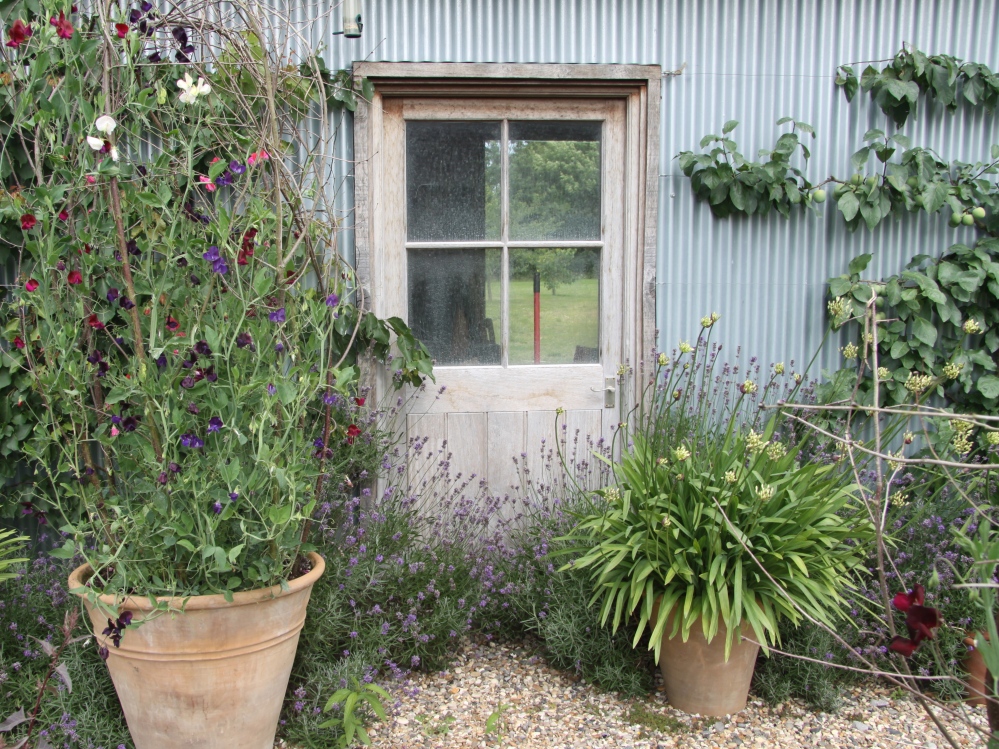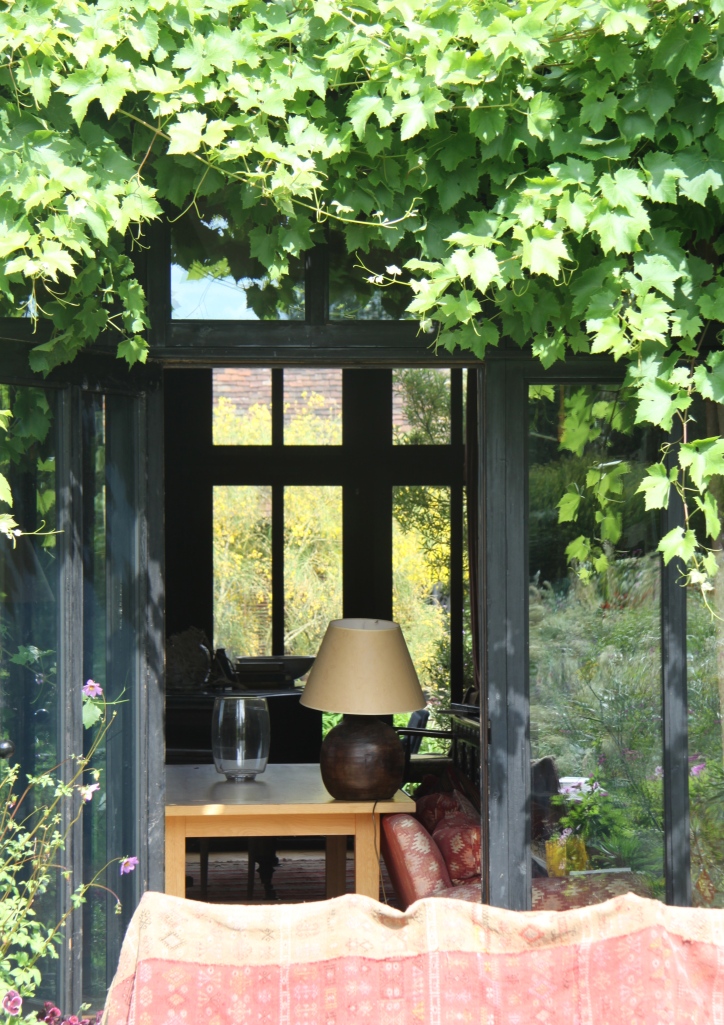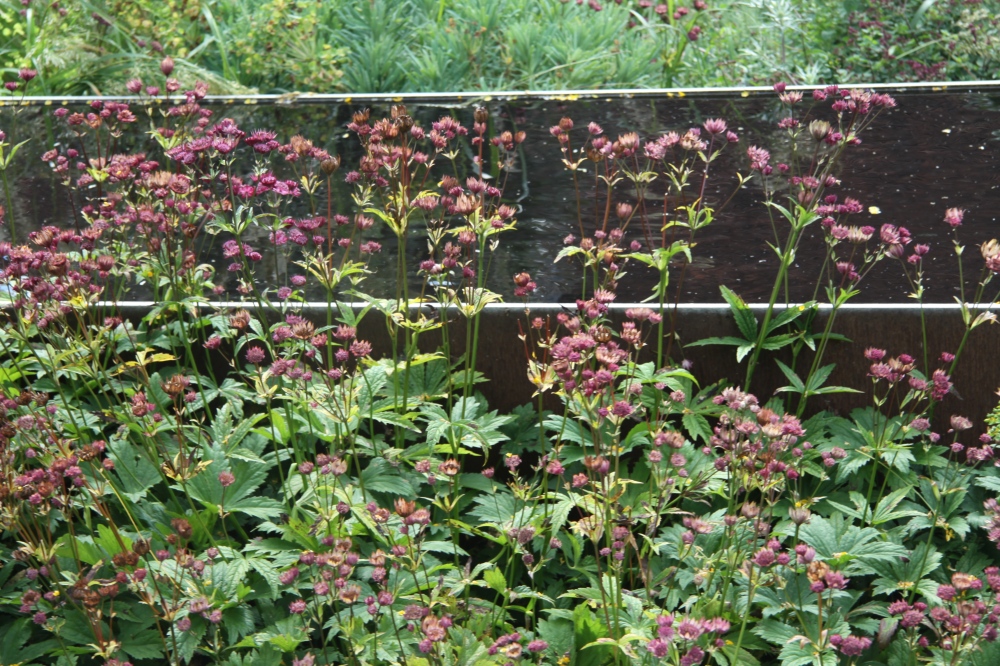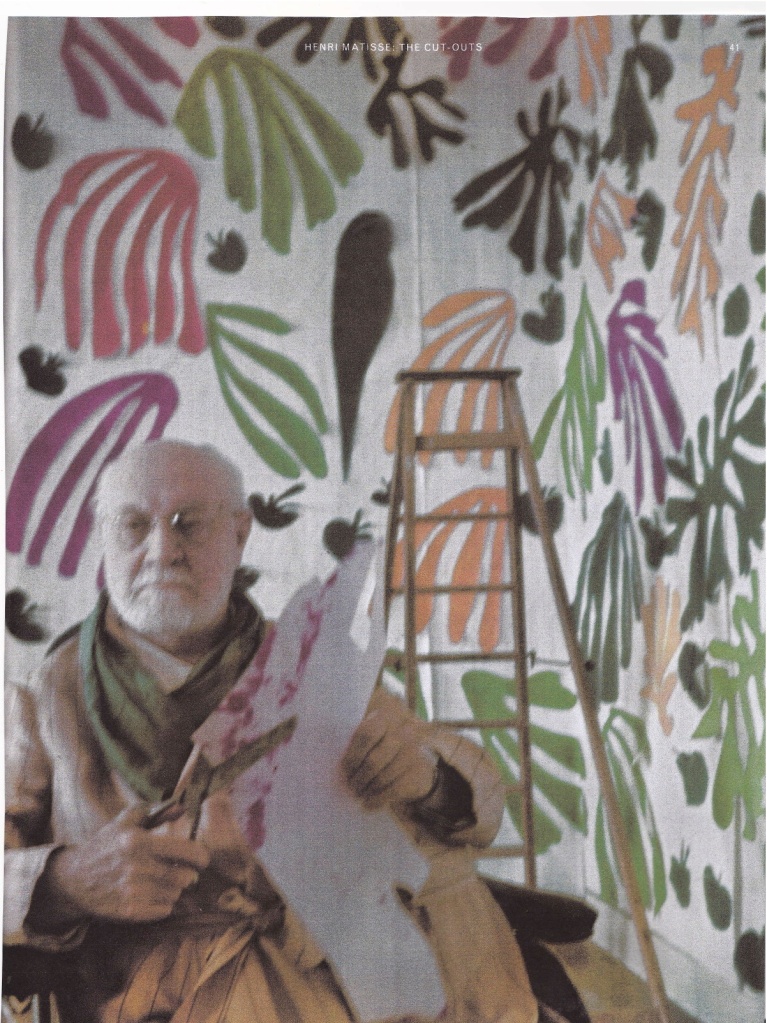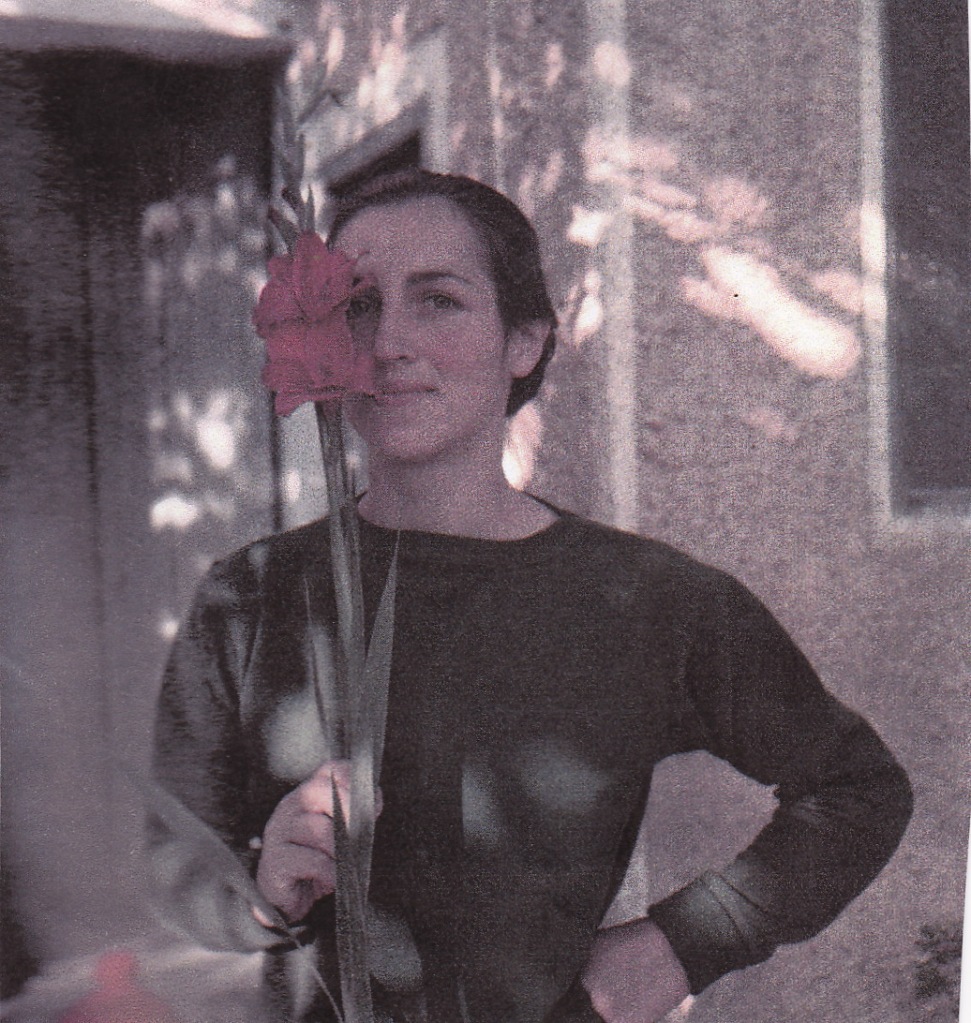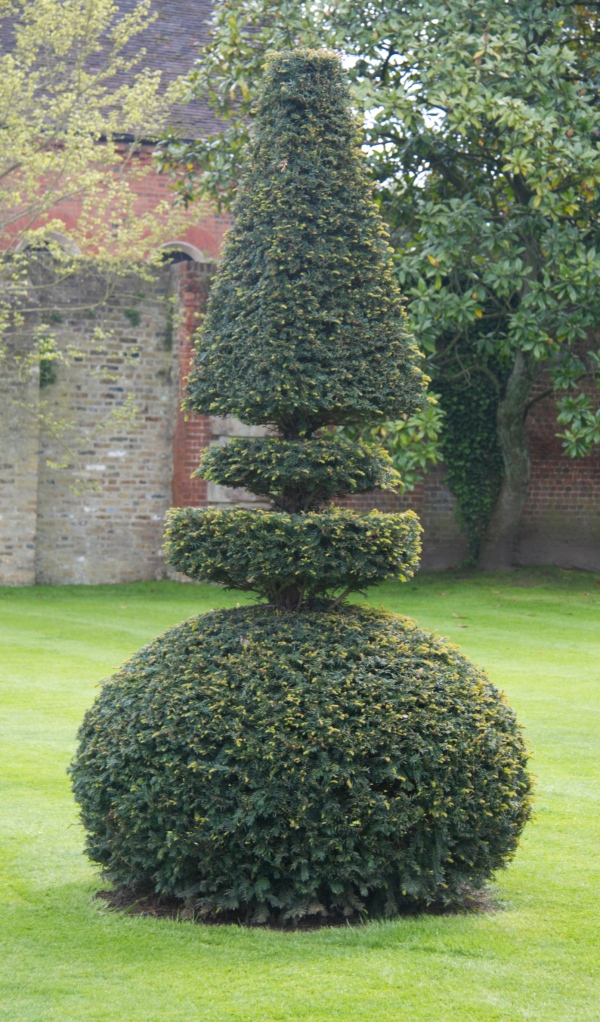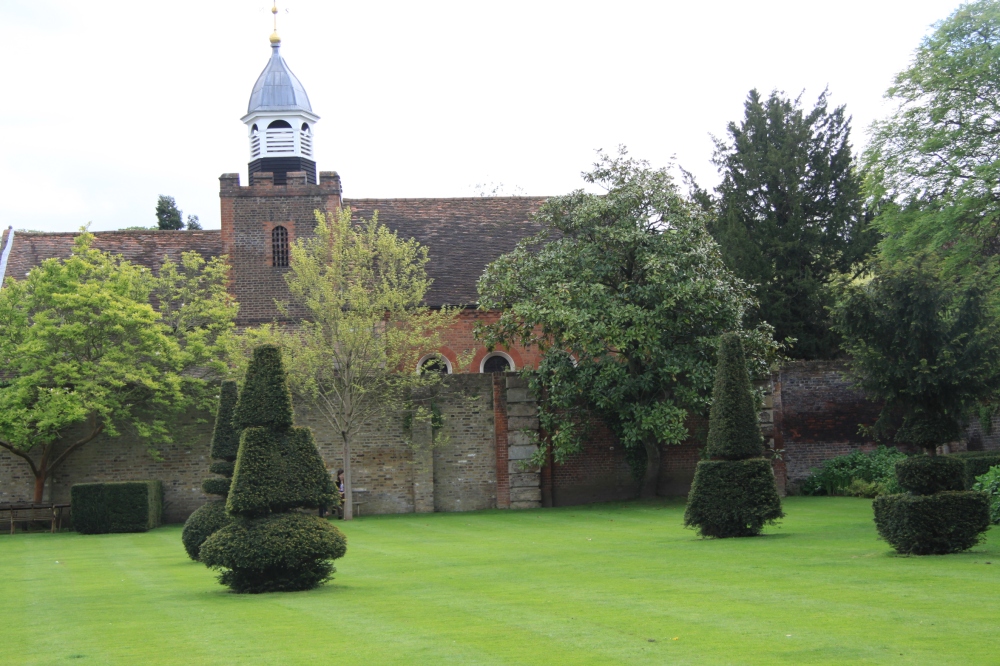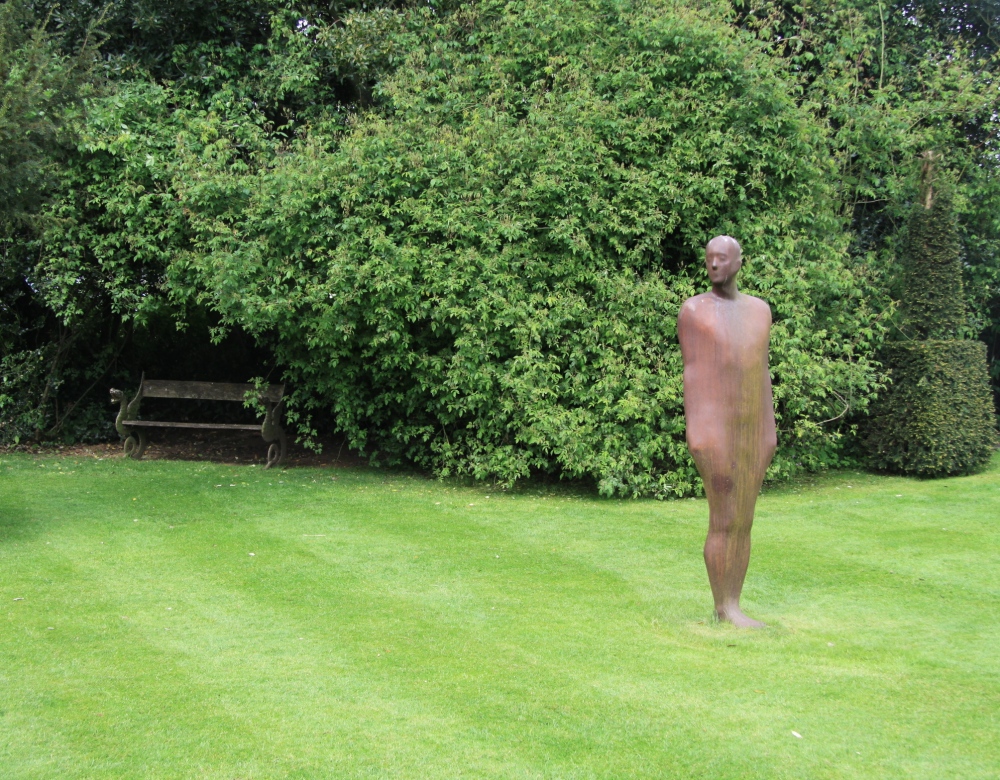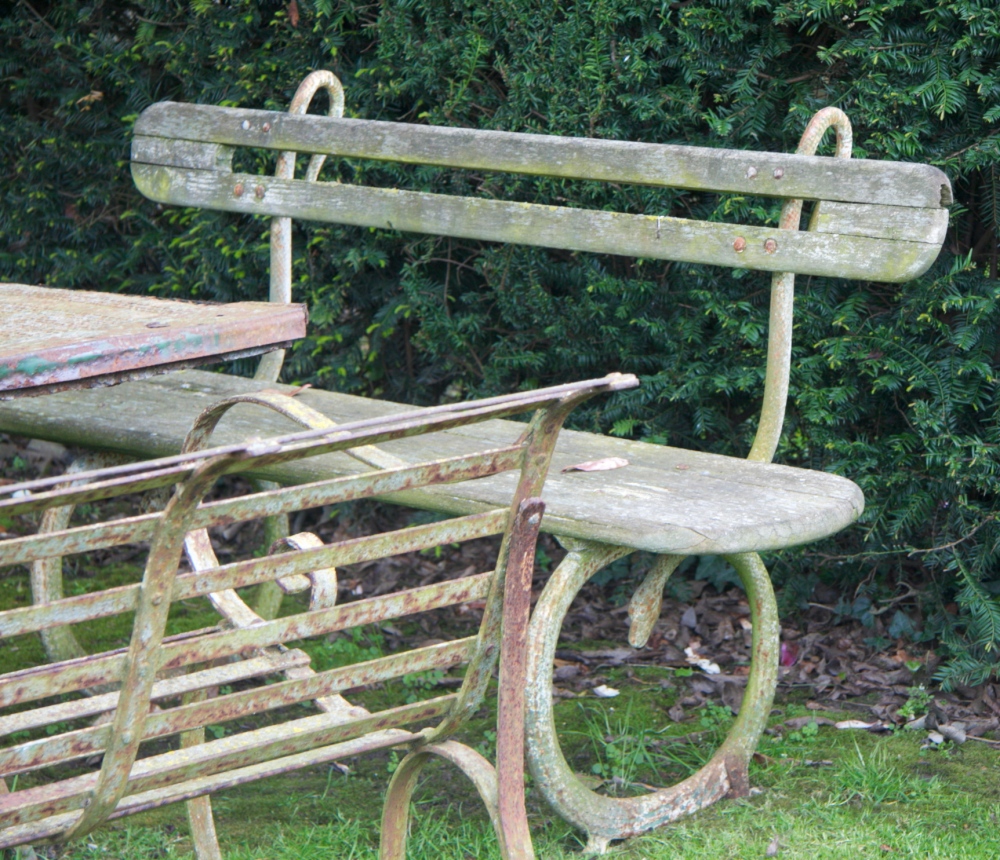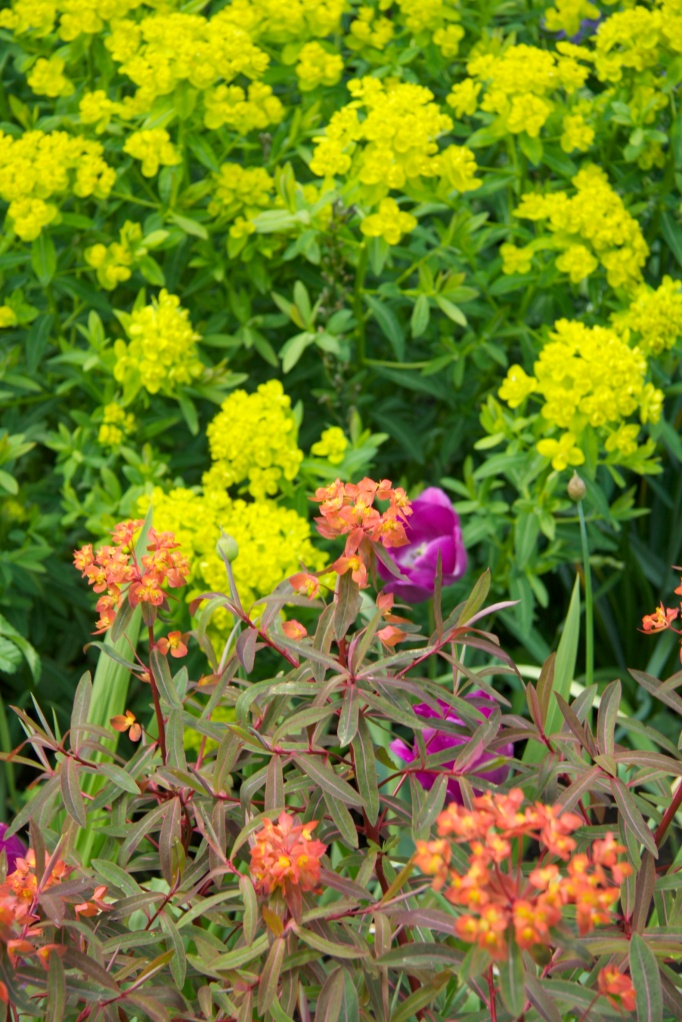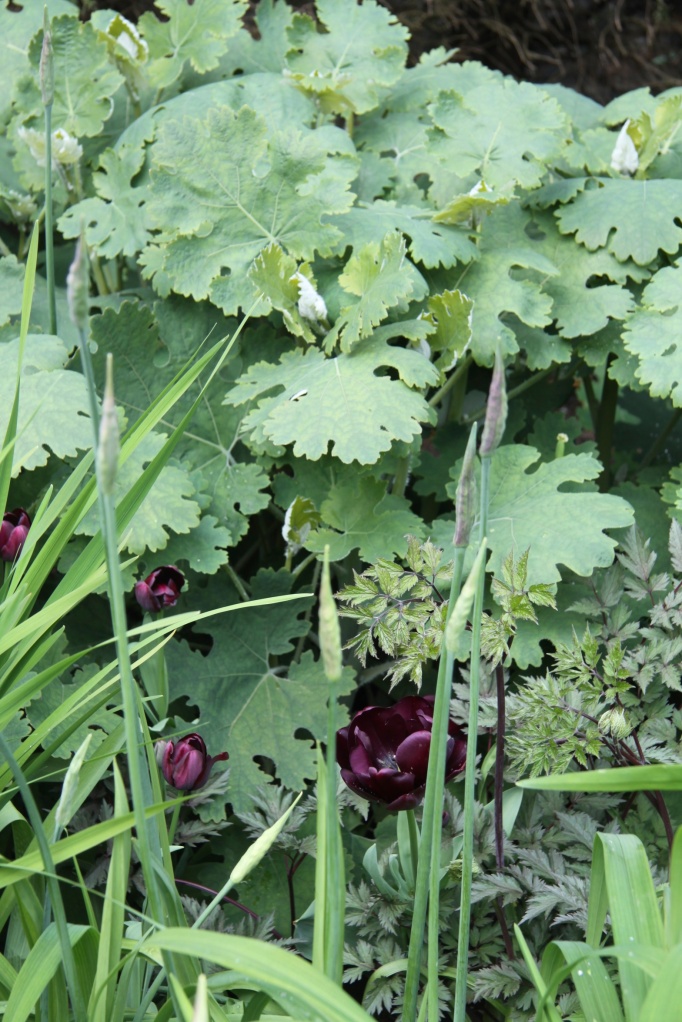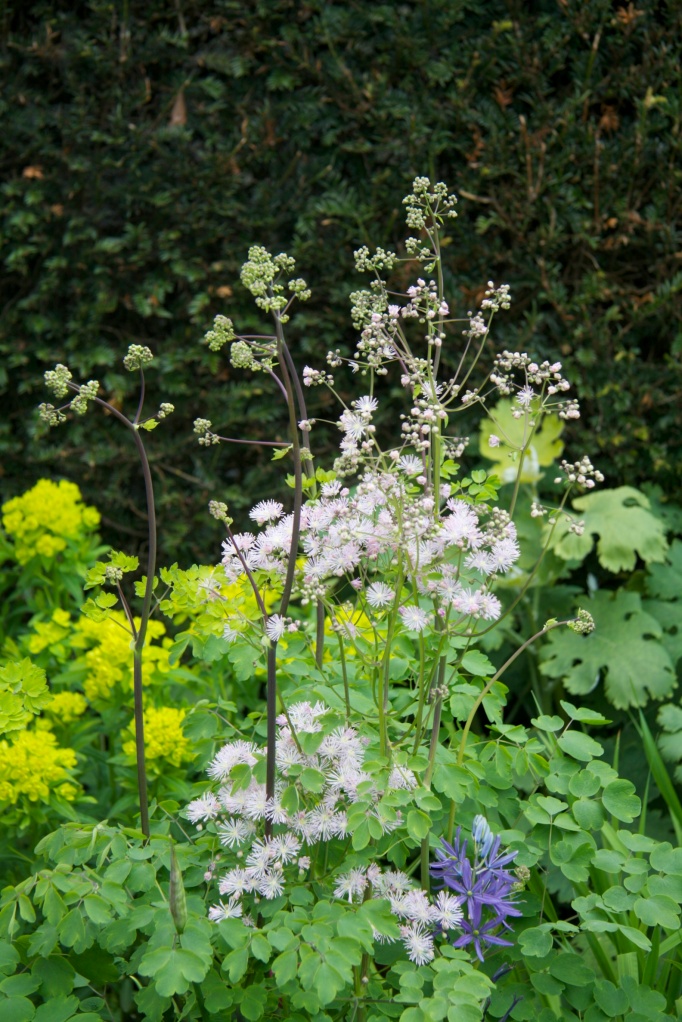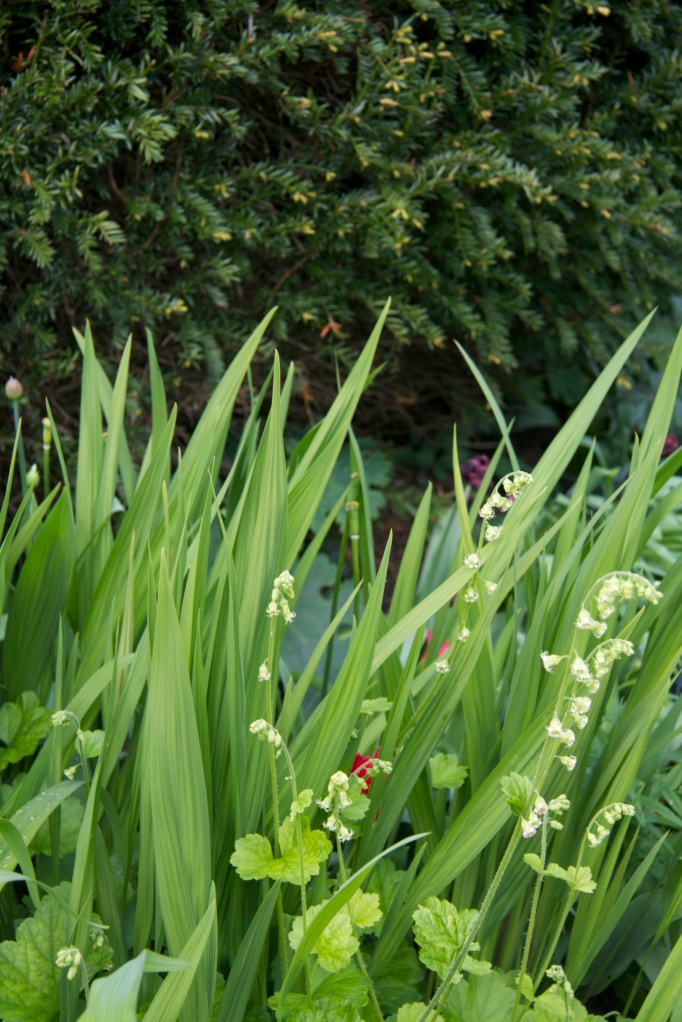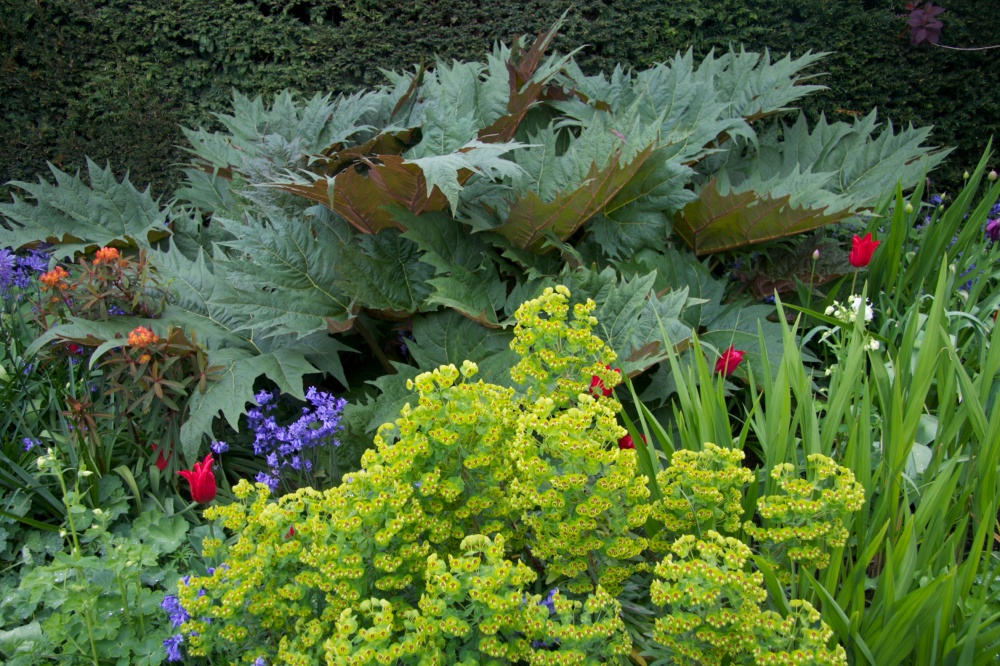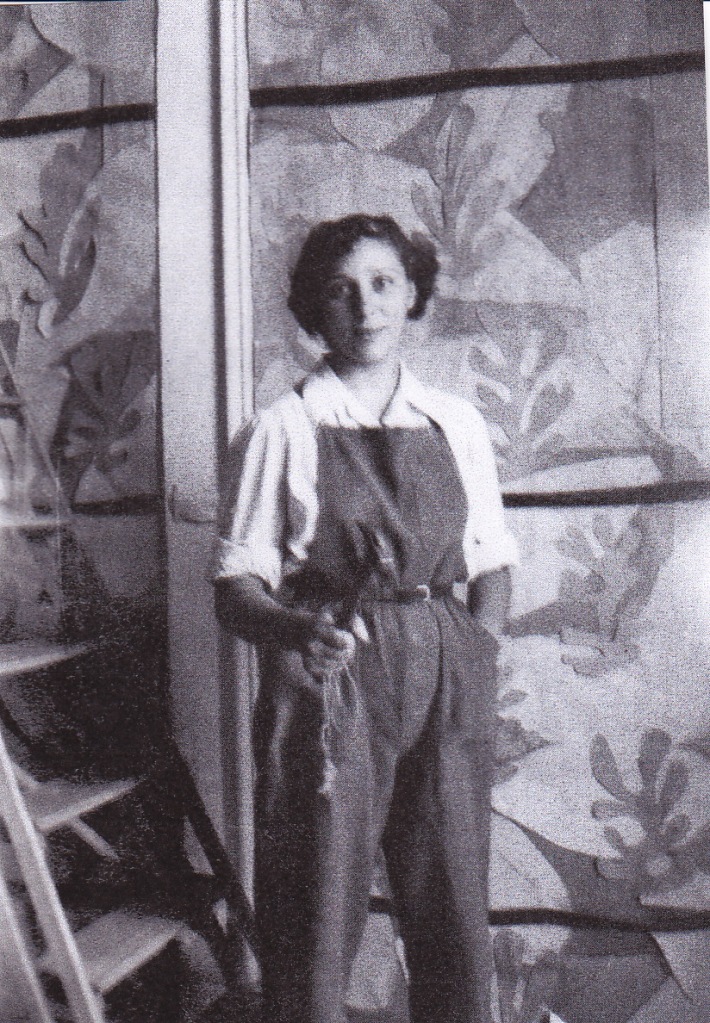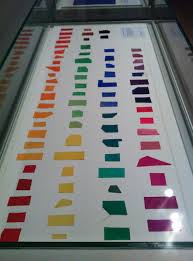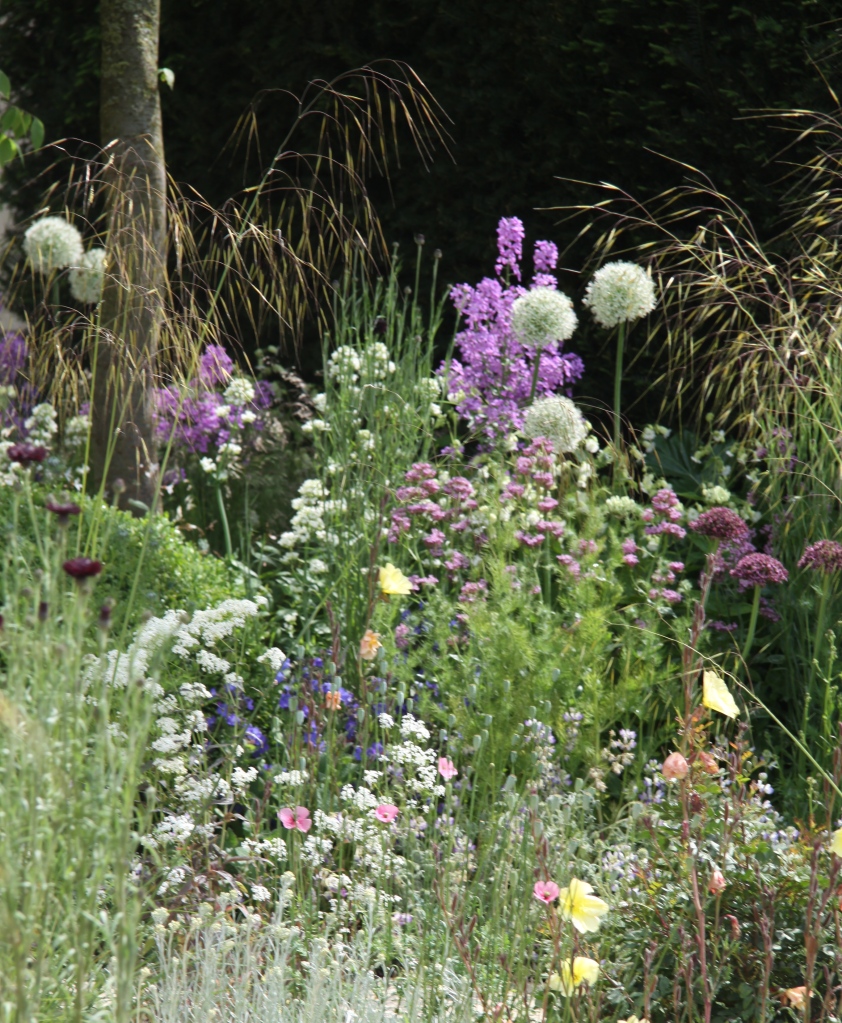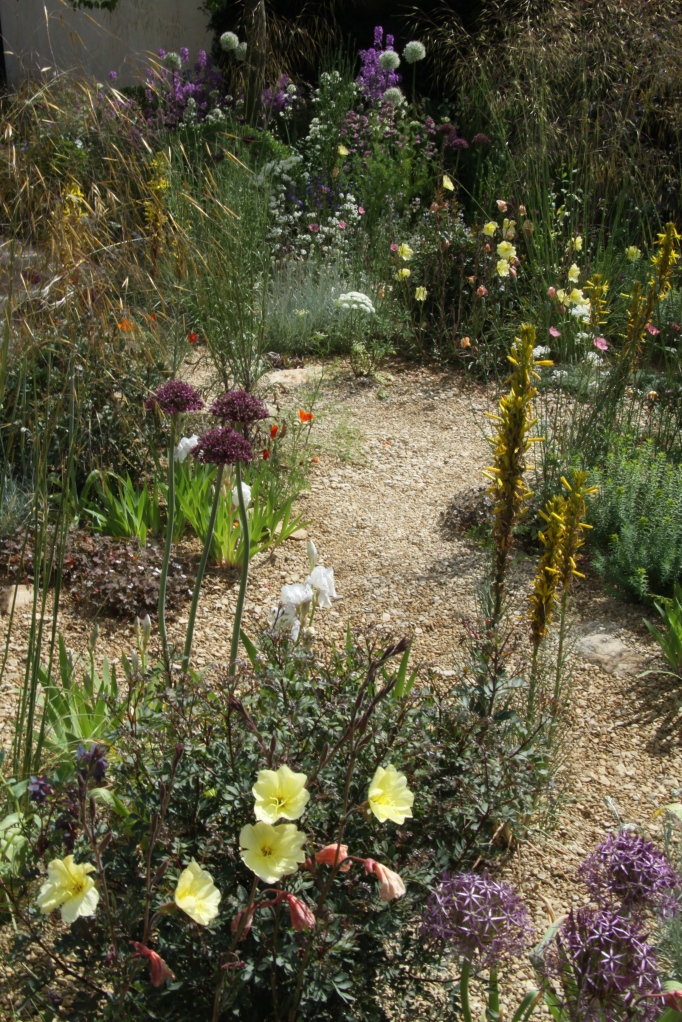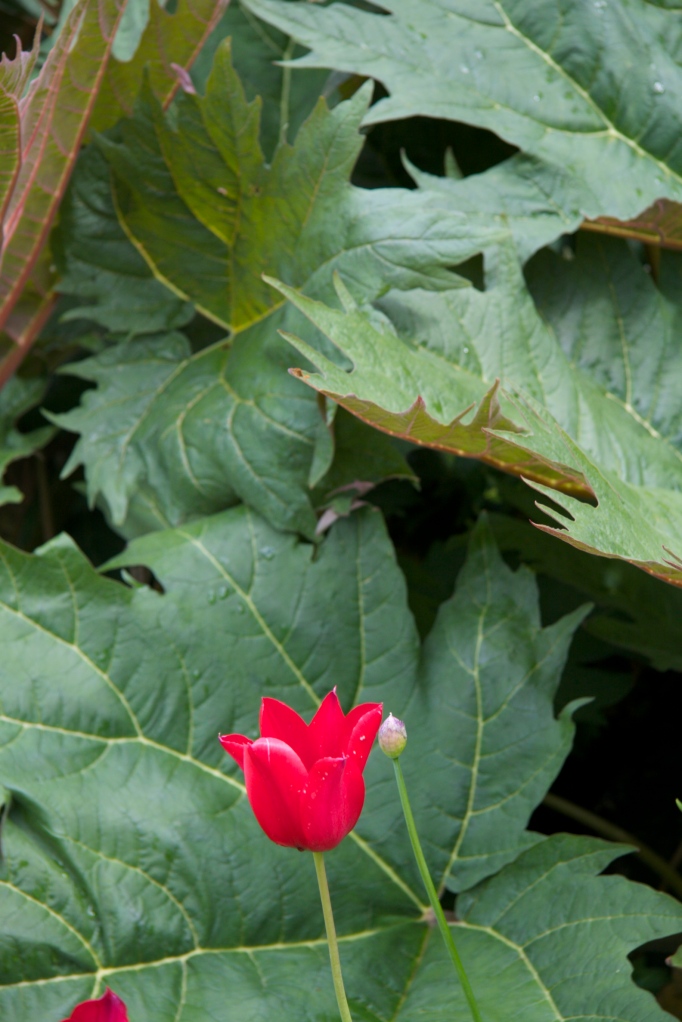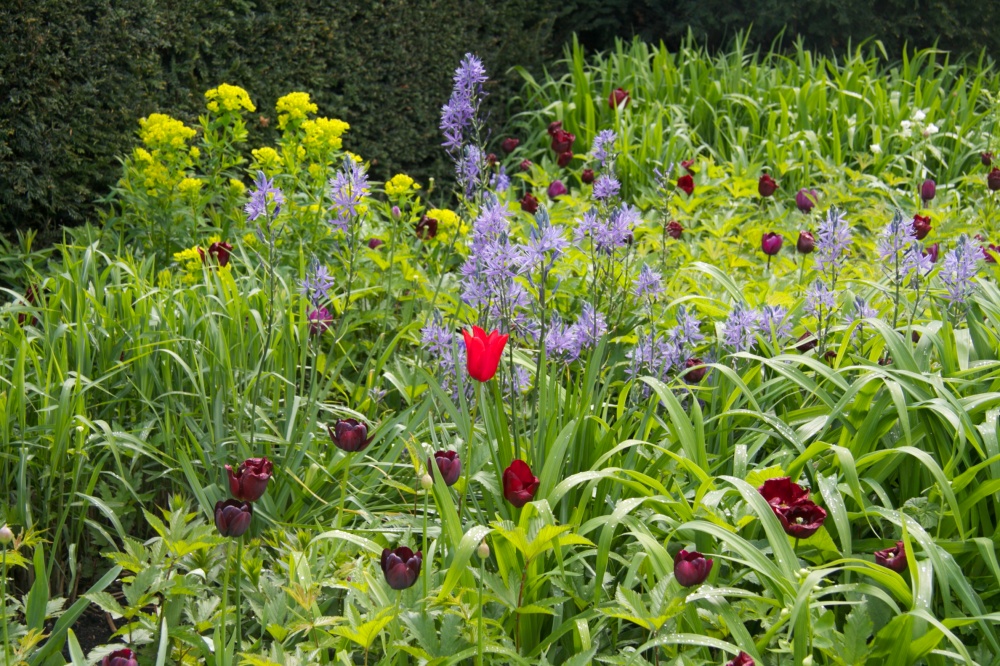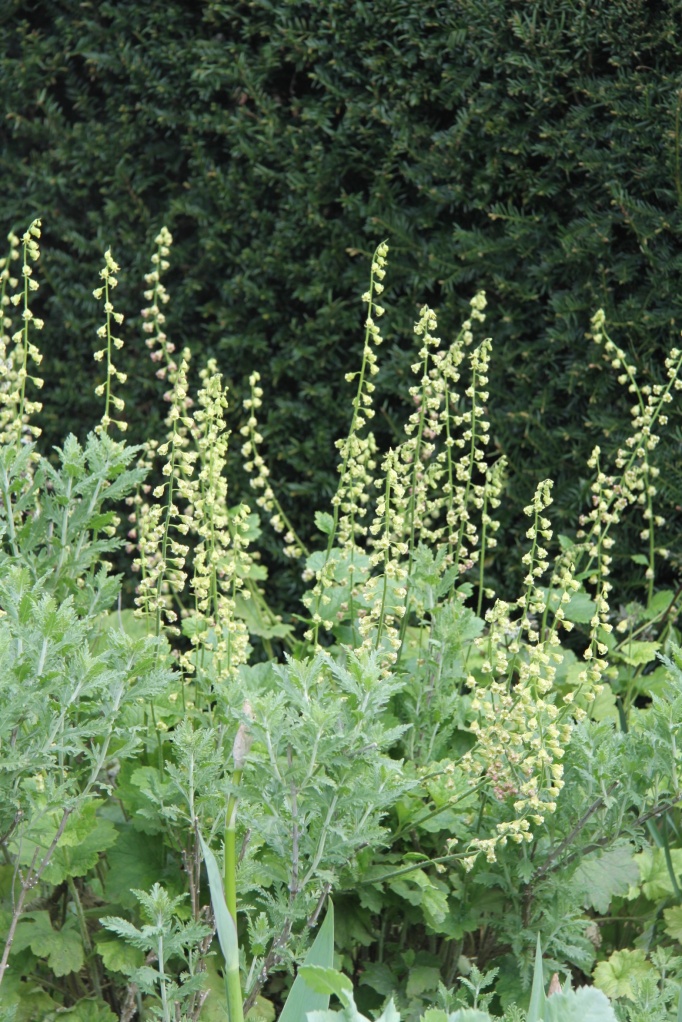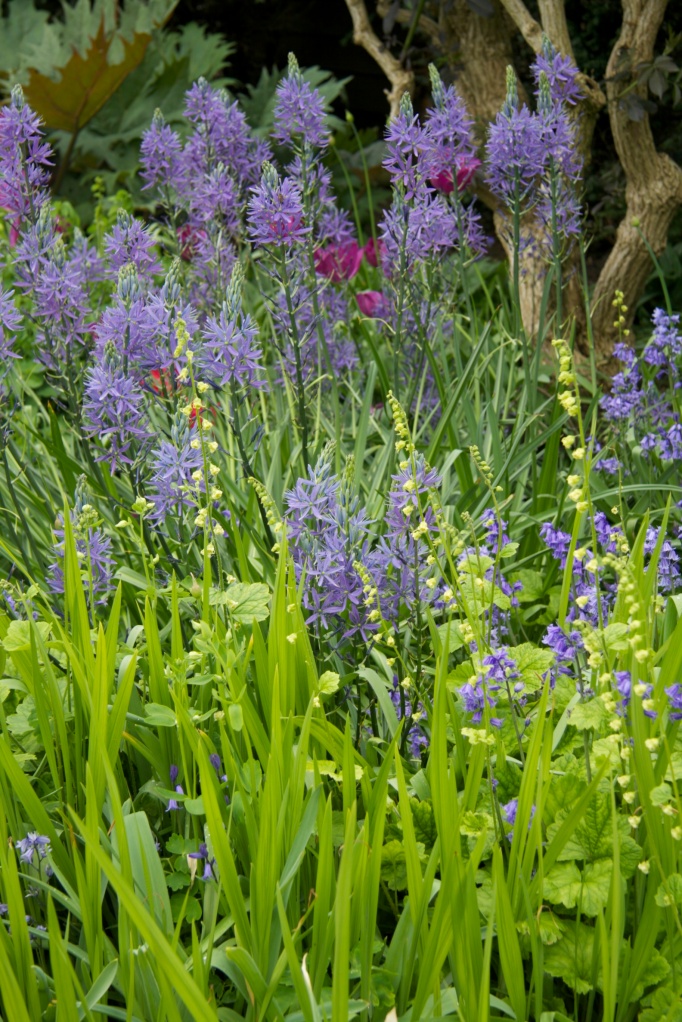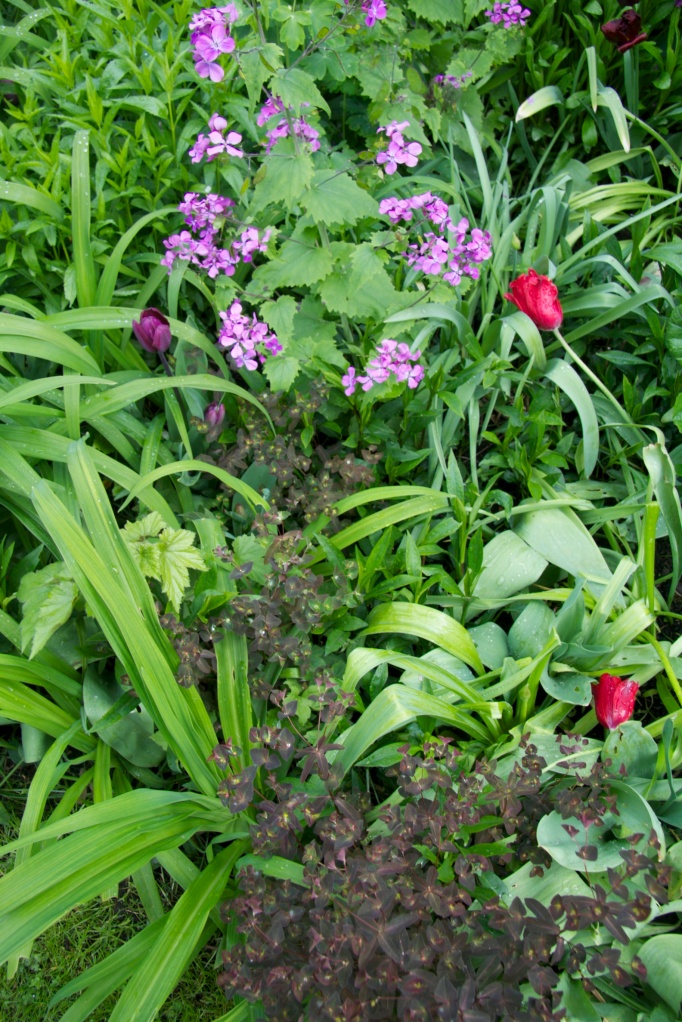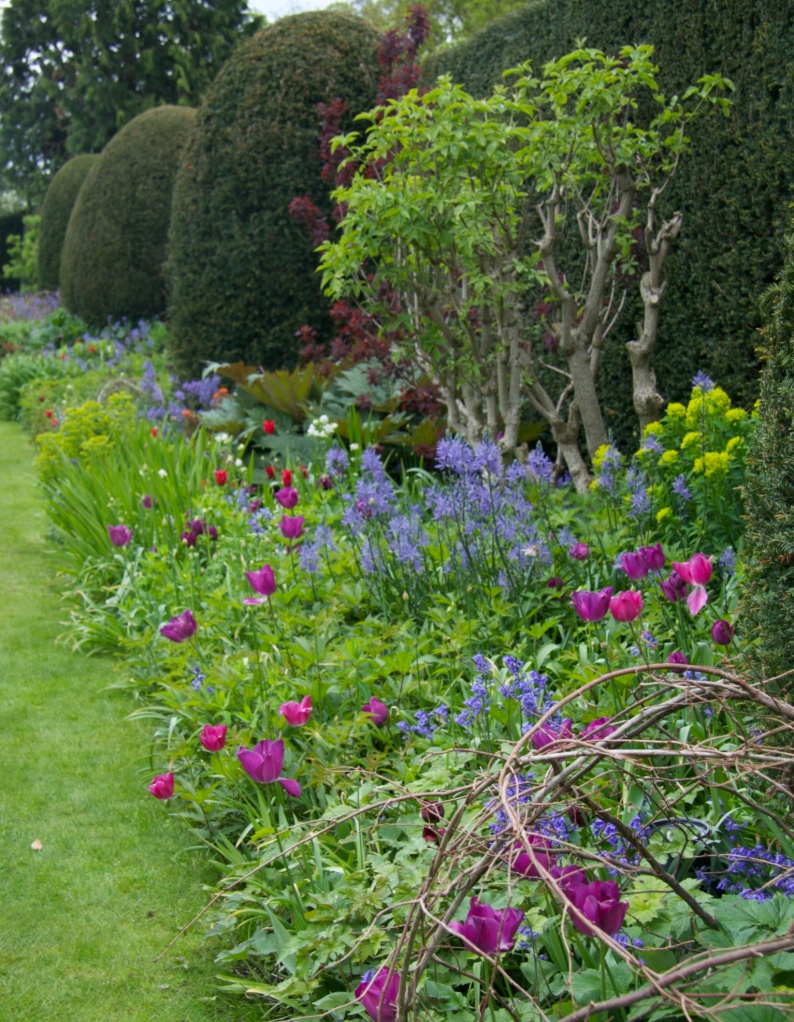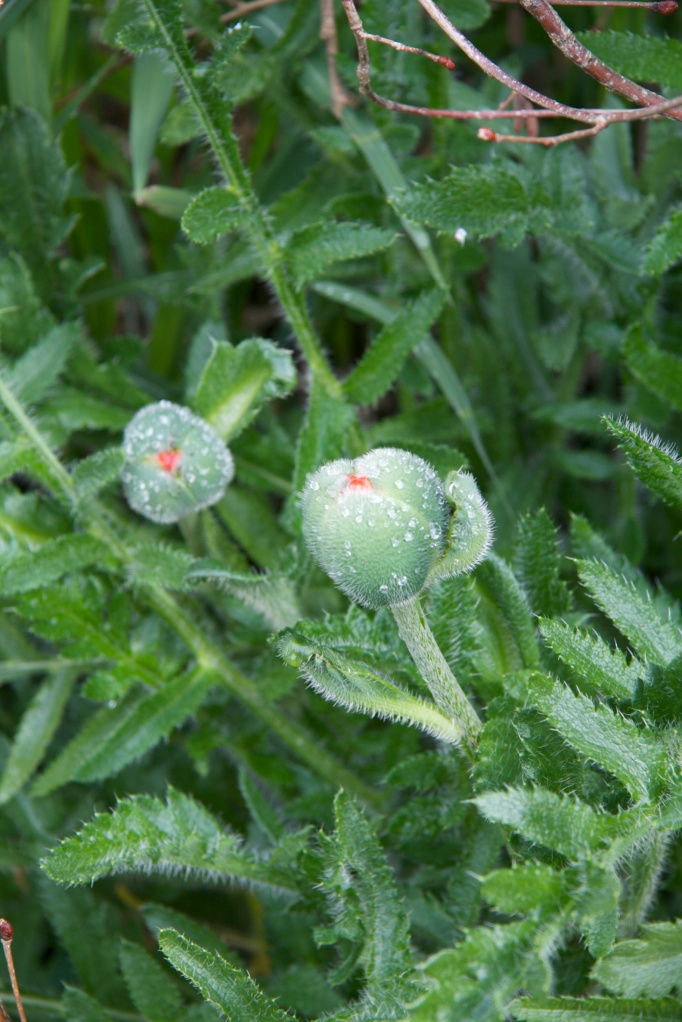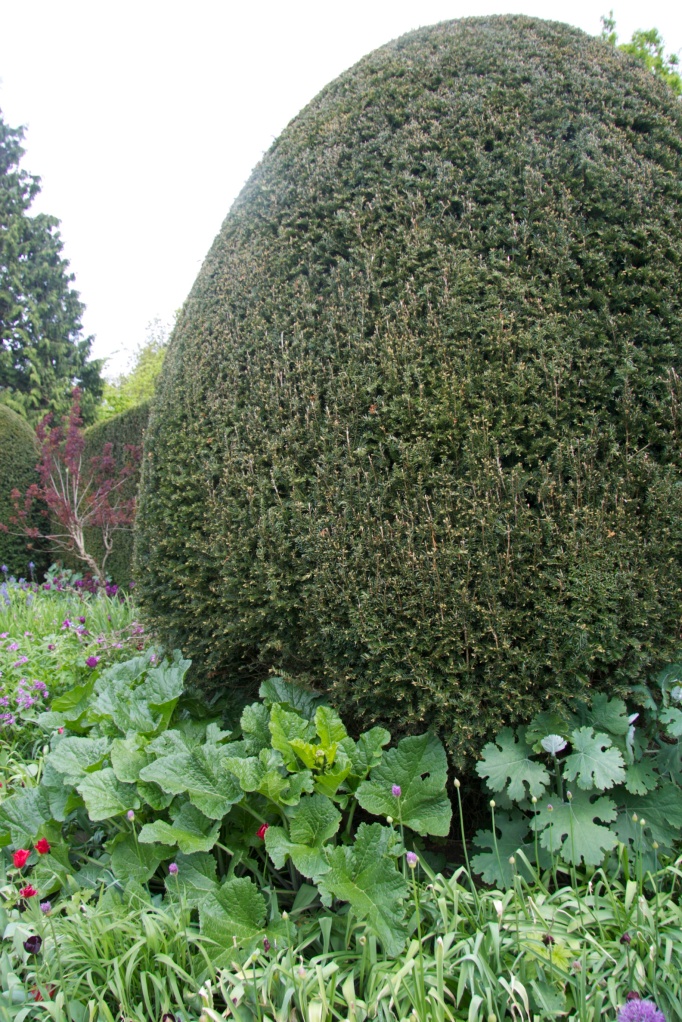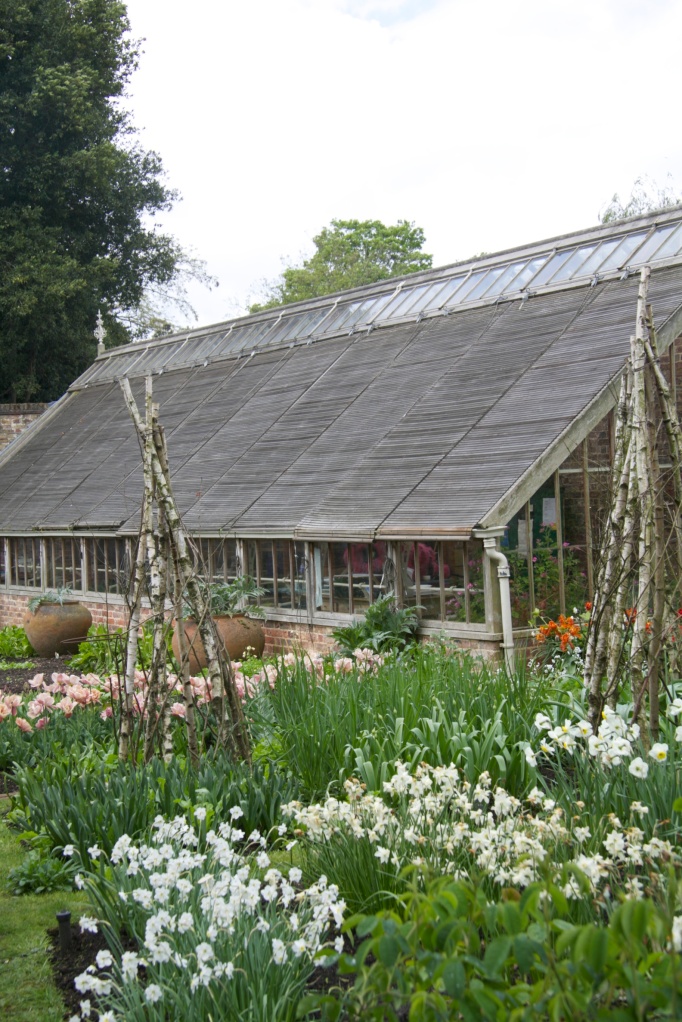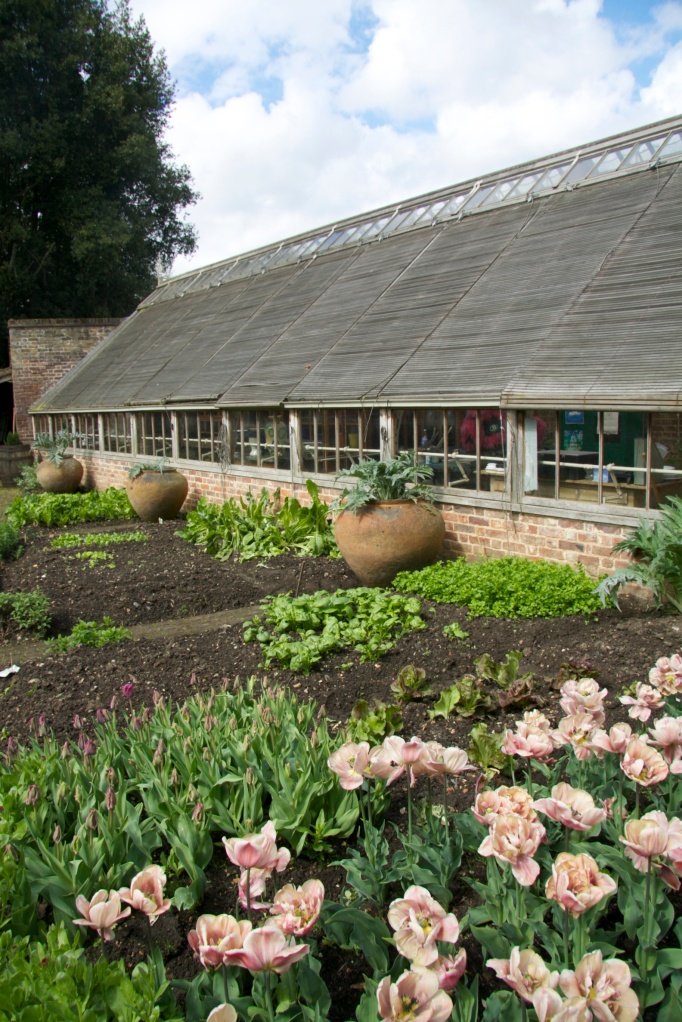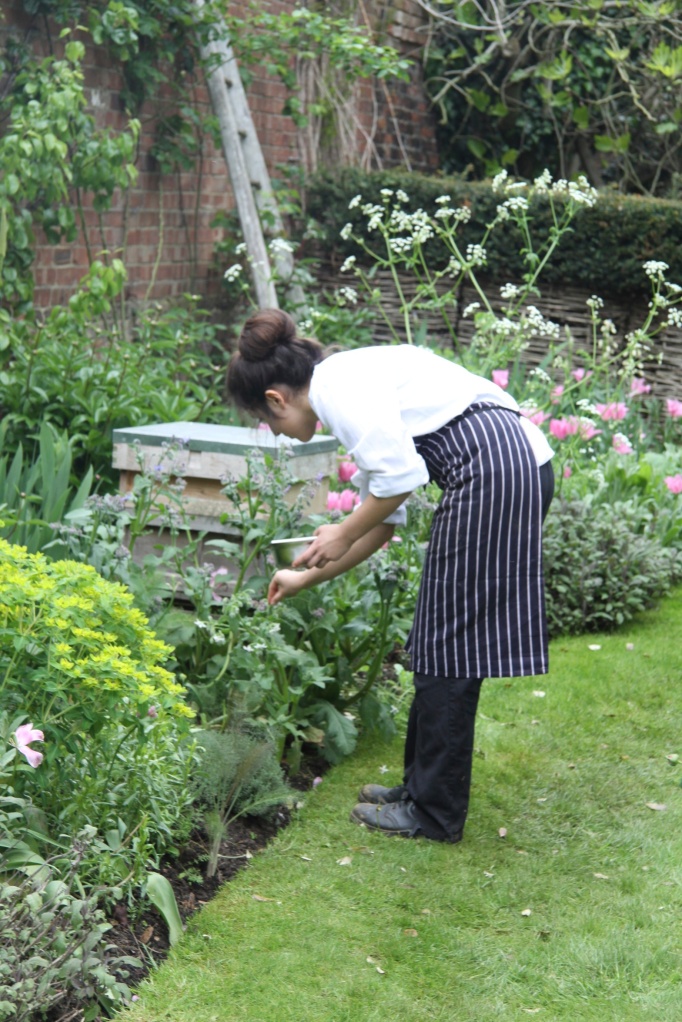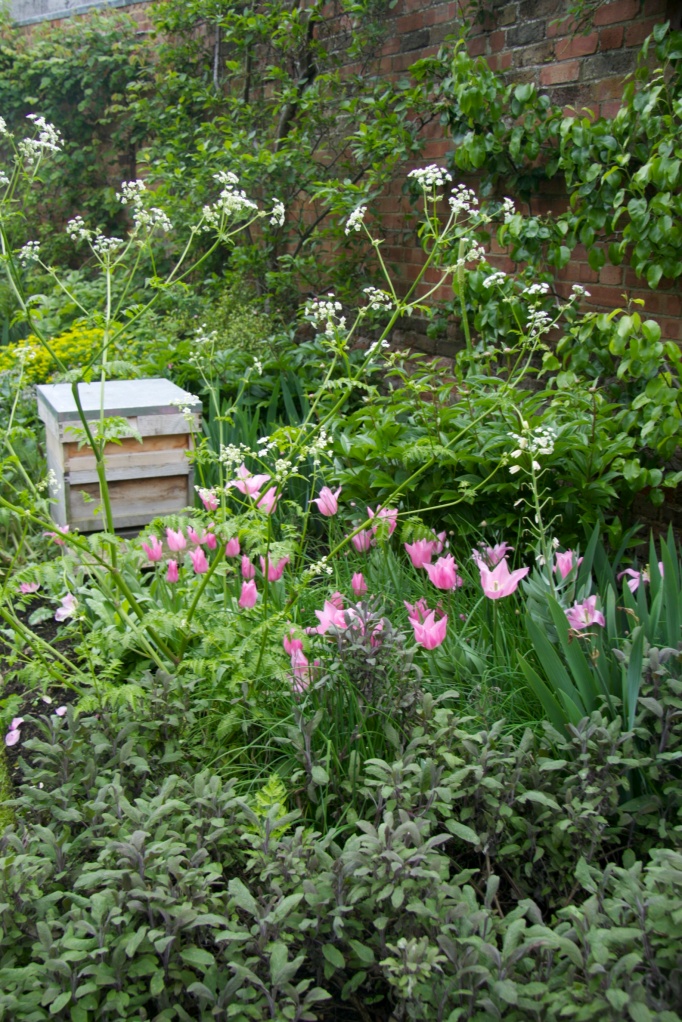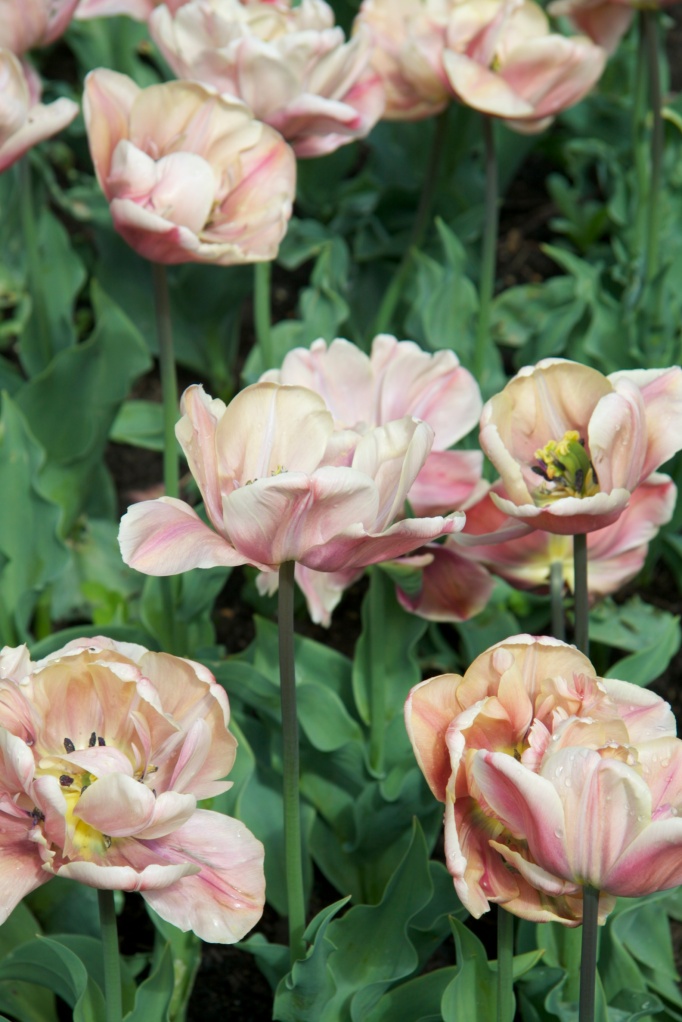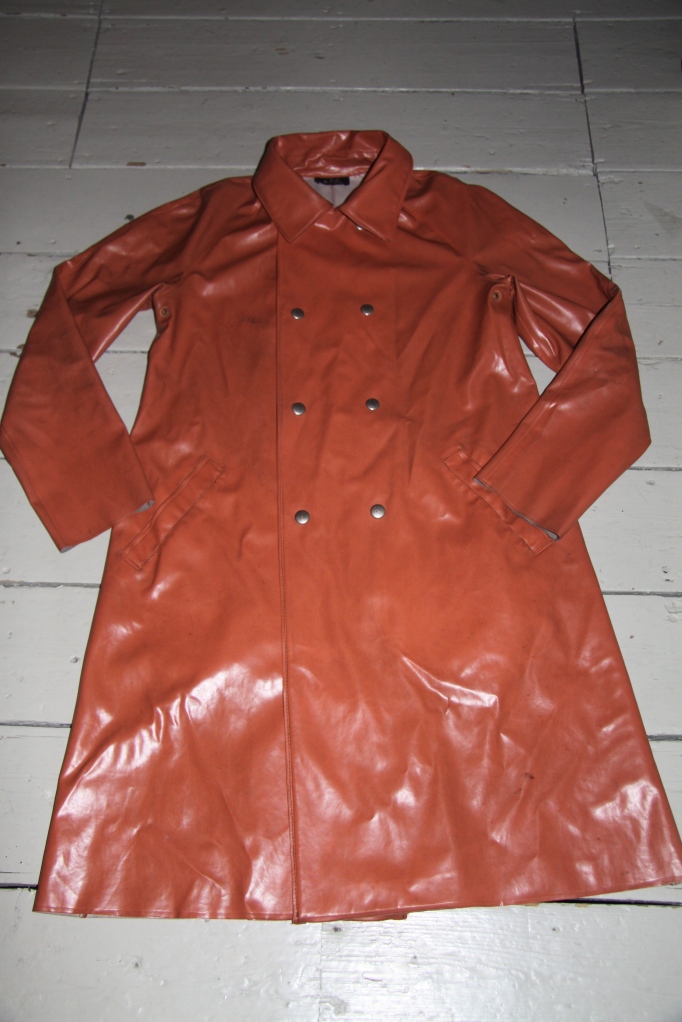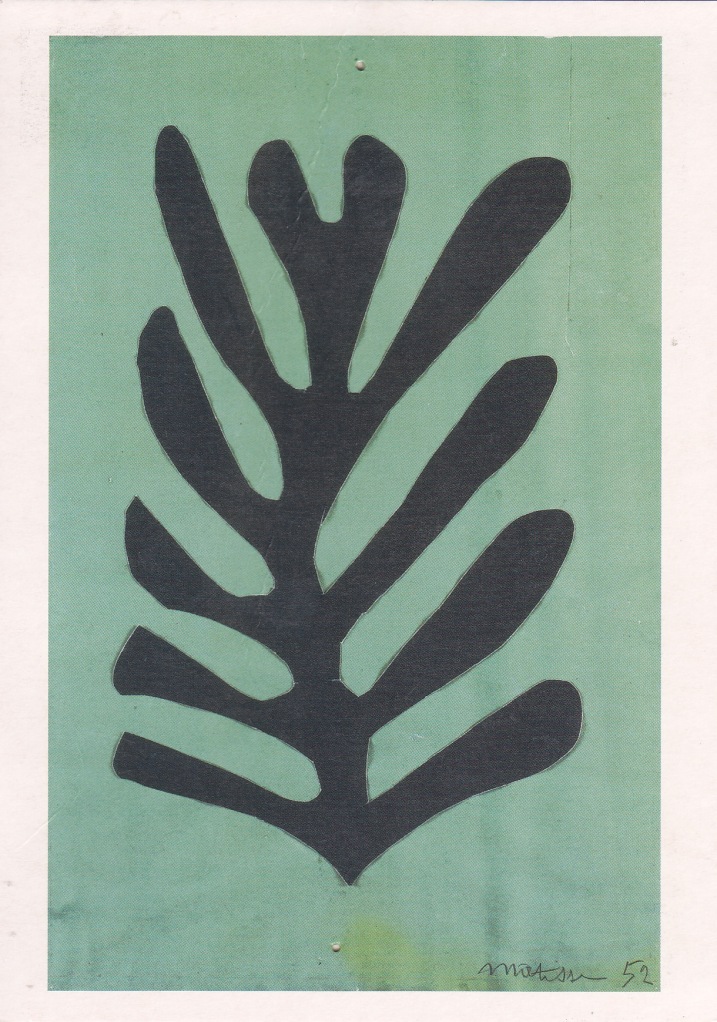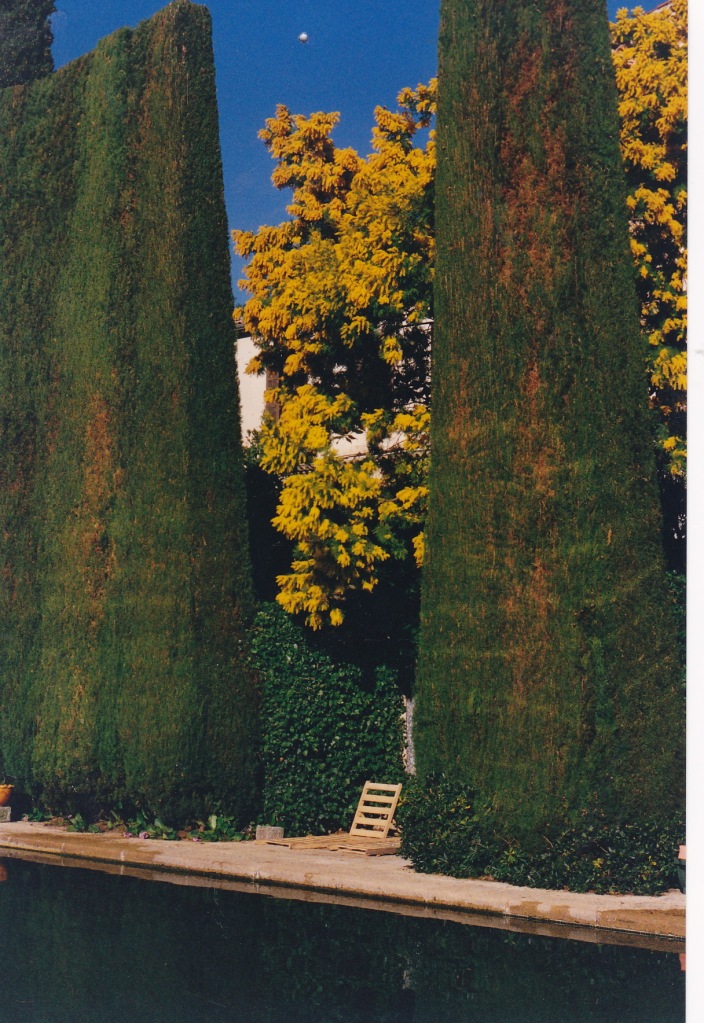AN INSPIRING RETURN VISIT TO A FINE SUSSEX GARDEN
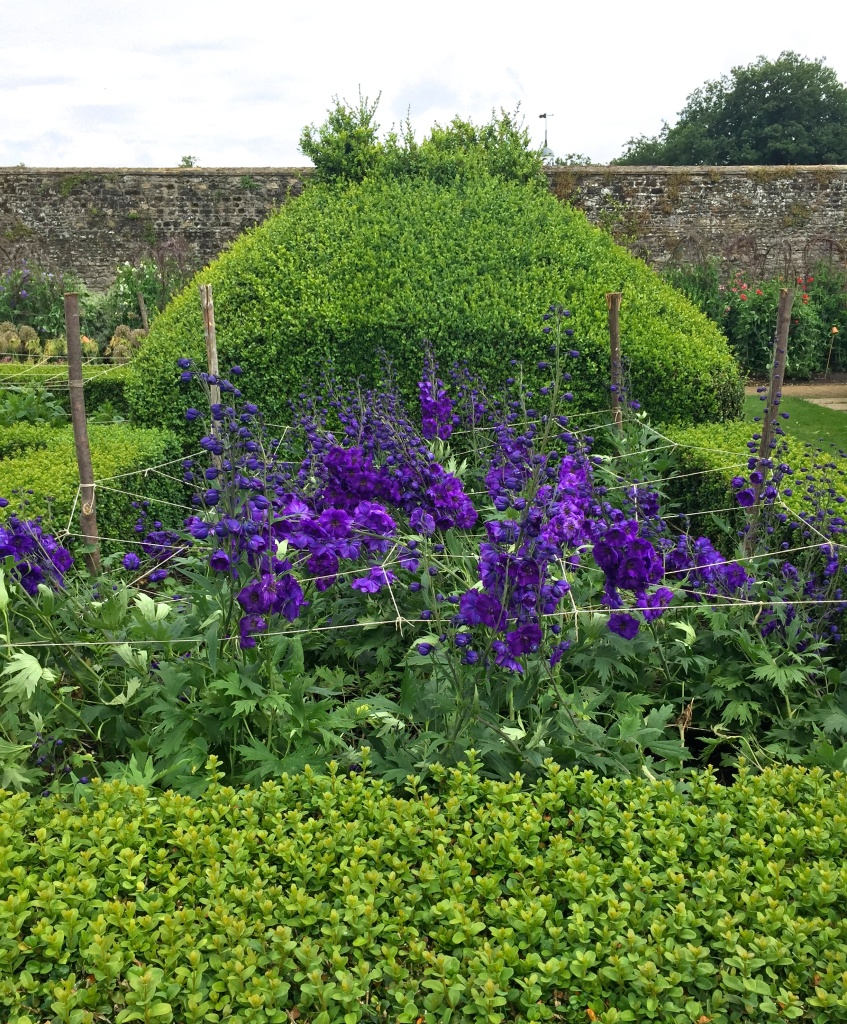 Electric blue delphiniums emerge from the box parterre in The Vegetable Garden, Parham
Electric blue delphiniums emerge from the box parterre in The Vegetable Garden, Parham
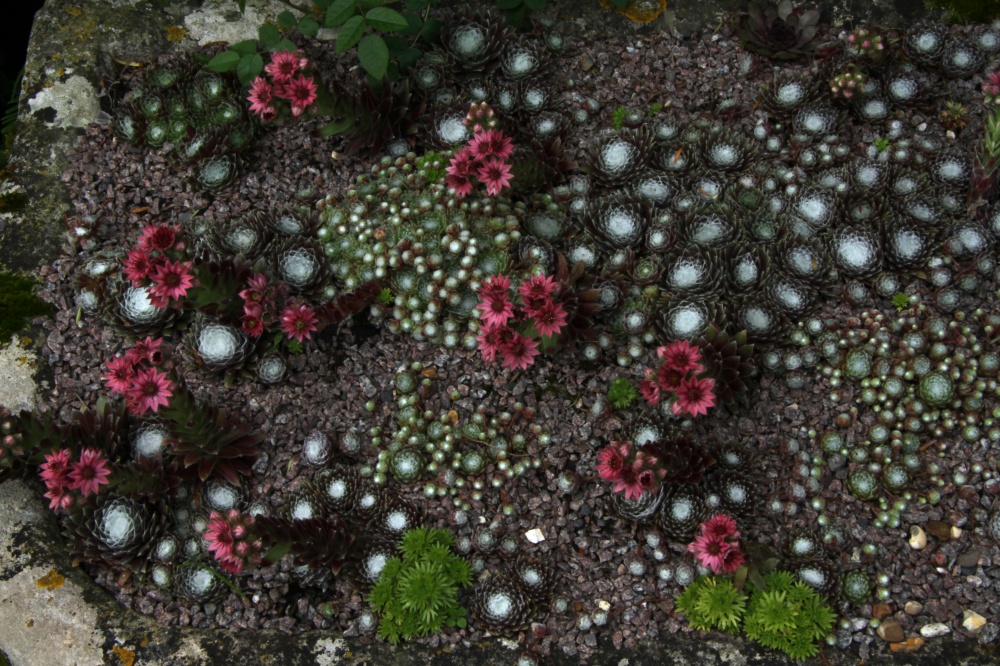 Quietly psychadelic succulents fill a stone trough in The Herb Garden
Quietly psychadelic succulents fill a stone trough in The Herb Garden
I must have visited the gardens of Parham House for the first time about ten years ago in the era of talented Head Gardeners Ray Gibbs and Joe Reardon-Smith. I remember the uplifting, overspilling opulence of the planting and trying to hold onto exactly what was making each group of plants sing. The dashes of white which turned out to be the palest blue Veronica gentianoides and the subtle interweaving of burnt – or not so burnt – orange and terracotta to jolt a border soft blues into something richer and more velvety.
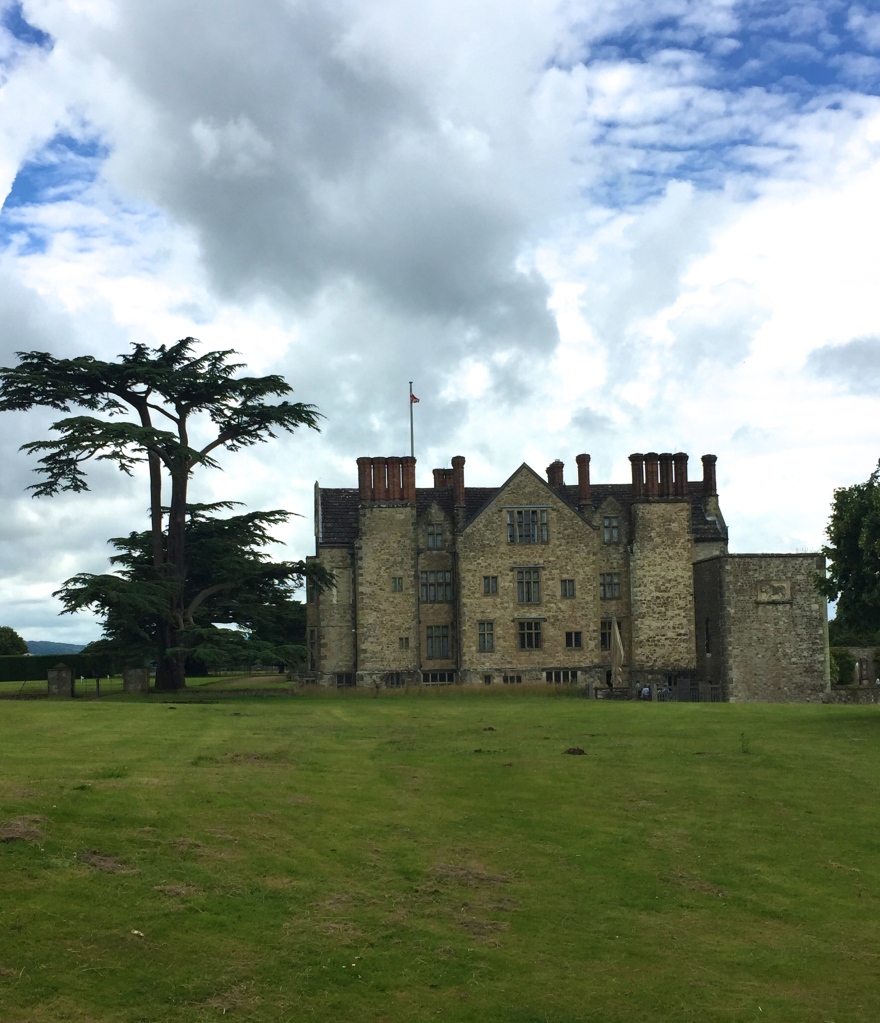 Parham House, West Sussex
Parham House, West Sussex
The 16th Century house at Parham has been owned and lived in by a member of the Pearson family since the early 1920’s. The Pearsons, together with architect Victor Heal and American garden designer Lanning Roper, did much to create the shape and atmosphere of the current garden and there was another big push in the 1980’s when, with the help of garden designer Peter Coats, the 18th century walled enclosure was moved one step further away from its original life as a productive garden for a large household and turned into a garden of mixed borders and lawns. The current Head Gardener is Tom Brown. A Sarah Raven article in the Telegraph about his recent allium trial – ‘How to Grow the most show-stopping alliums for your garden’ – triggered seductive memories of my earlier visit. The last day of June was one of brooding skies, but no rain, and I found myself heading towards the South Coast, hoping quietly to find some midsummer inspiration.
 St Peter’s Church, Parham
St Peter’s Church, Parham
 Parkland and views to rolling Sussex countryside, Parham
Parkland and views to rolling Sussex countryside, Parham
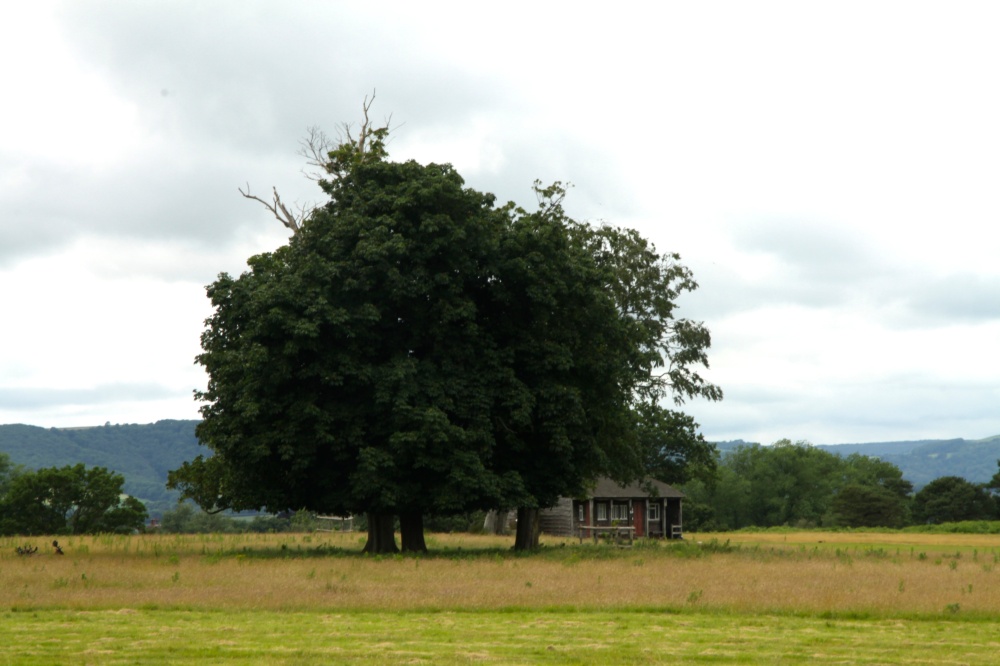 A stand of mature oak trees, Parham
A stand of mature oak trees, Parham
I am delighted by pretty much everything. The parkland around the house, stretching out to the rolling Sussex countryside, is exquisite, with views framed by the dipping branches of mature cedar and oak trees. The grass is still mostly green with just the beginnings of faded coral where bands of grass have allowed to grow tall.
I walk through the Clock Tower courtyard under glowering skies and enter the garden via a walkway of lovely multi-stemmed box and holly trees.
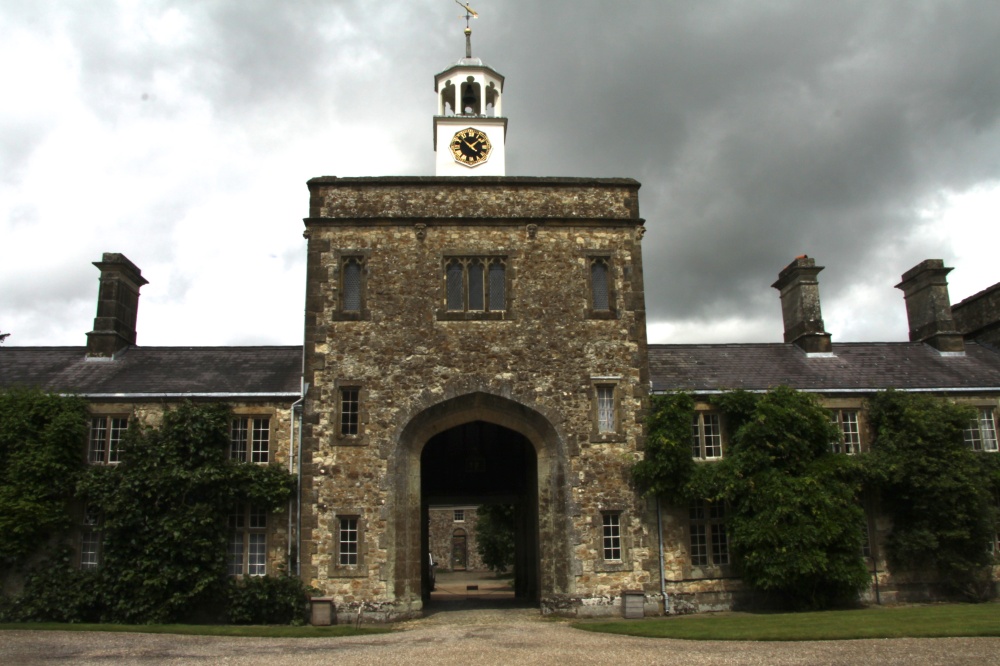 The Clock Tower, entrance courtyard, Parham
The Clock Tower, entrance courtyard, Parham
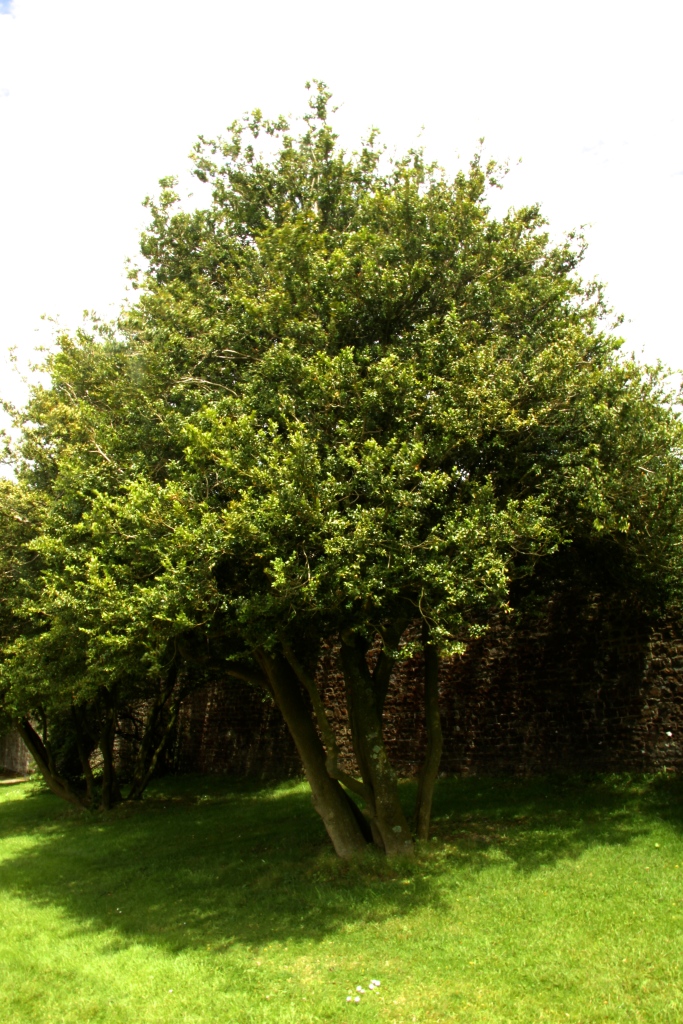 Multi-stemmed box trees lead the way into the garden.
Multi-stemmed box trees lead the way into the garden.
The Entrance Borders are just beginning to come into their own but I am thrilled to see the radiantly highlighted, bruised colouring I have been trying to recall. The borders are wide enough to accommodate a series of tree-like pineapple-scented philadelphus, and the famous tapestry-style planting uses claret coloured berberis and cotinus together with the bright greens of Alchemilla mollis and golden hops to frame the borders which are laced with fiery red marigolds, the cooler almost mint green of Sedum ‘Autumn Joy’ (in its June guise) and an almost apricot yellow daylily:
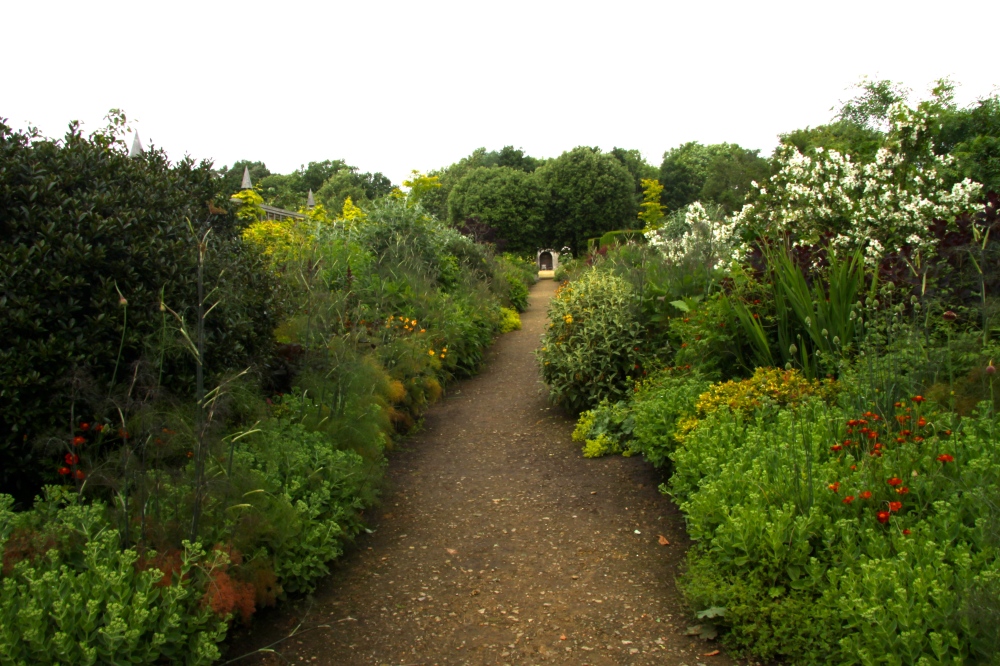 The dusky Entrance Borders, Parham, illuminated with spreading white Philadelphus
The dusky Entrance Borders, Parham, illuminated with spreading white Philadelphus
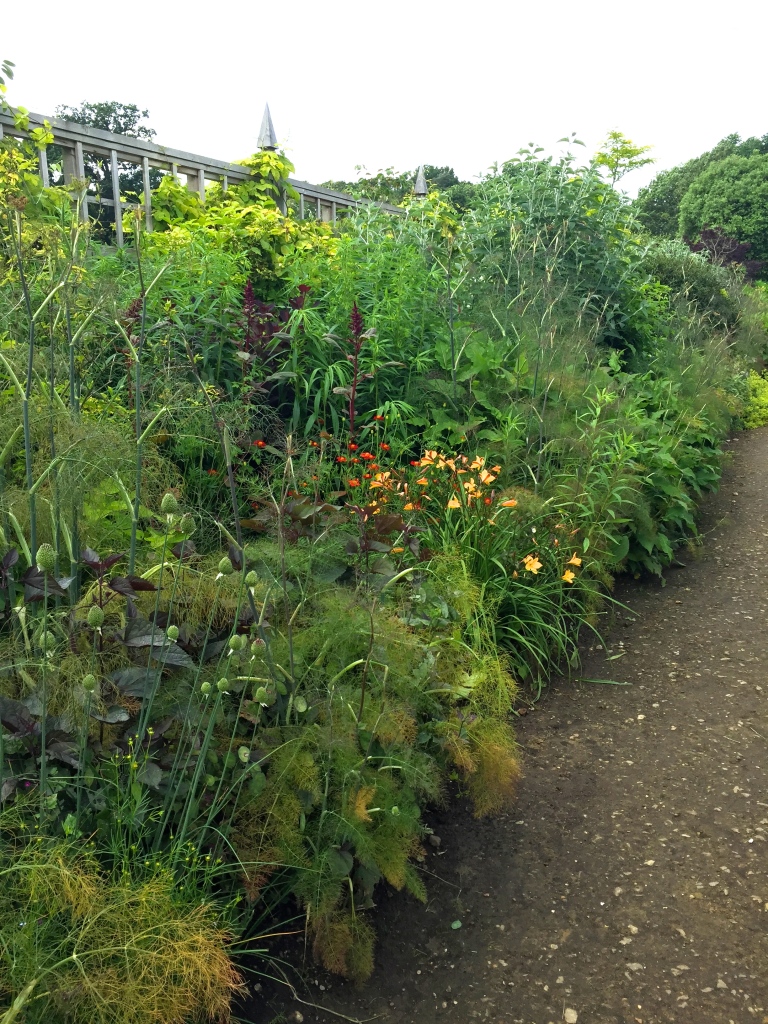 Golden hops, bronze fennel, apricot-yellow day lilies, and yet-to-ripen head of Allium sphaerocephalon, The Entrance Borders, Parham
Golden hops, bronze fennel, apricot-yellow day lilies, and yet-to-ripen head of Allium sphaerocephalon, The Entrance Borders, Parham
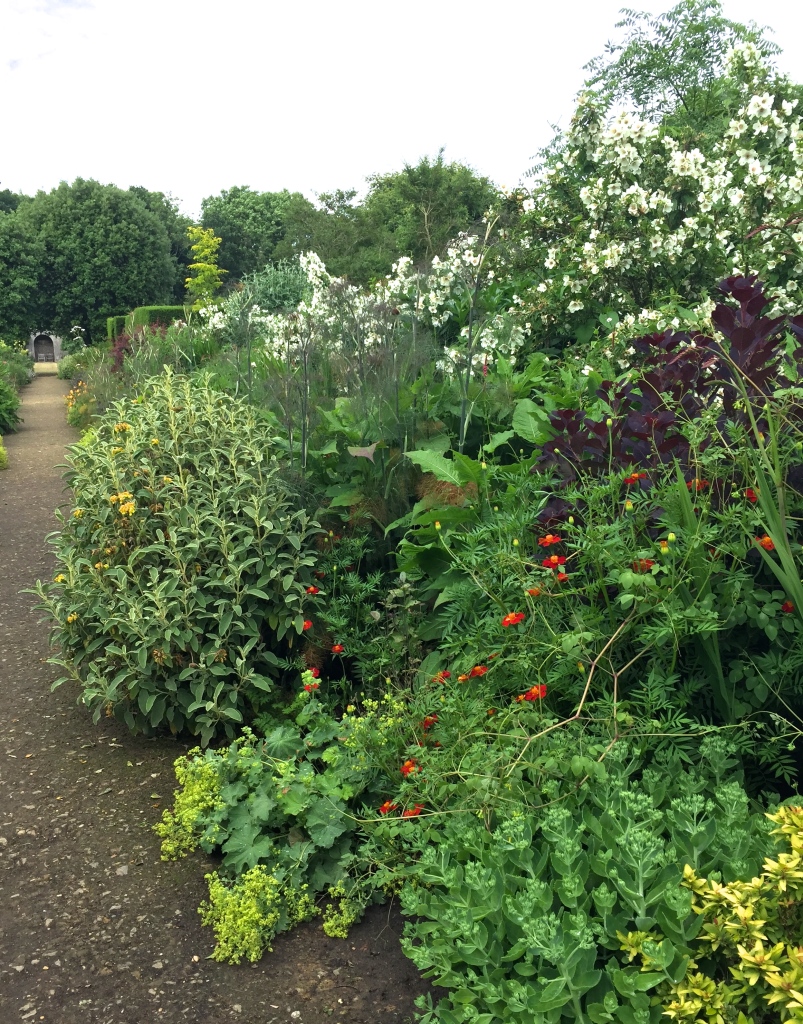
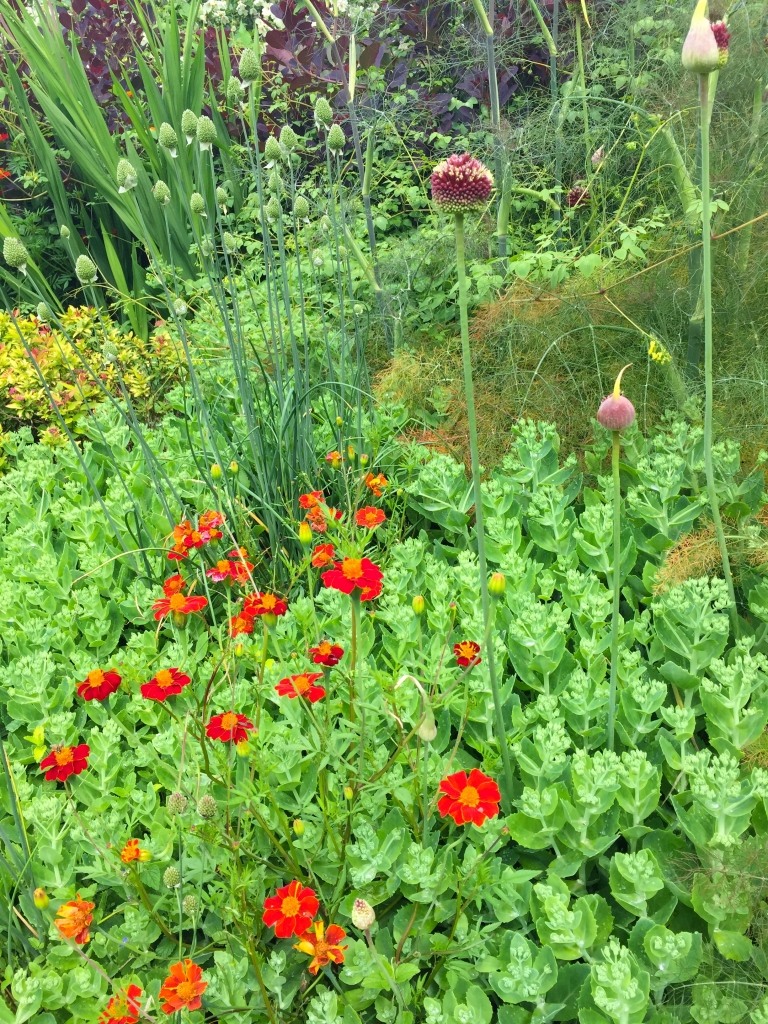
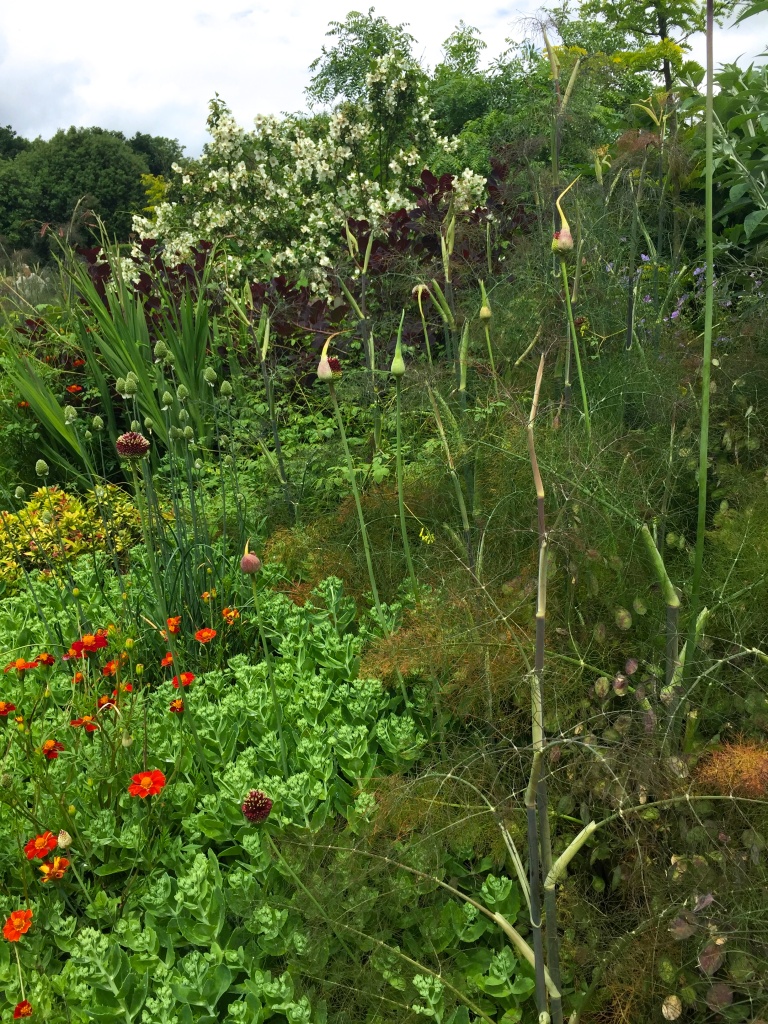
Philadelphus, Sedum ‘Autum Joy’ ( June stage!), Alchemilla mollis, aliums, marigolds, bronze fennel – Entrance Borders, Parham
As with all good planting the proportions of plants and the way they are combined is constantly and skilfully varied. There are more sombre areas – here a leggy mauve geranium is screened by a haze of bronze fennel with just a small quantity of red marigold at the base of the planting:
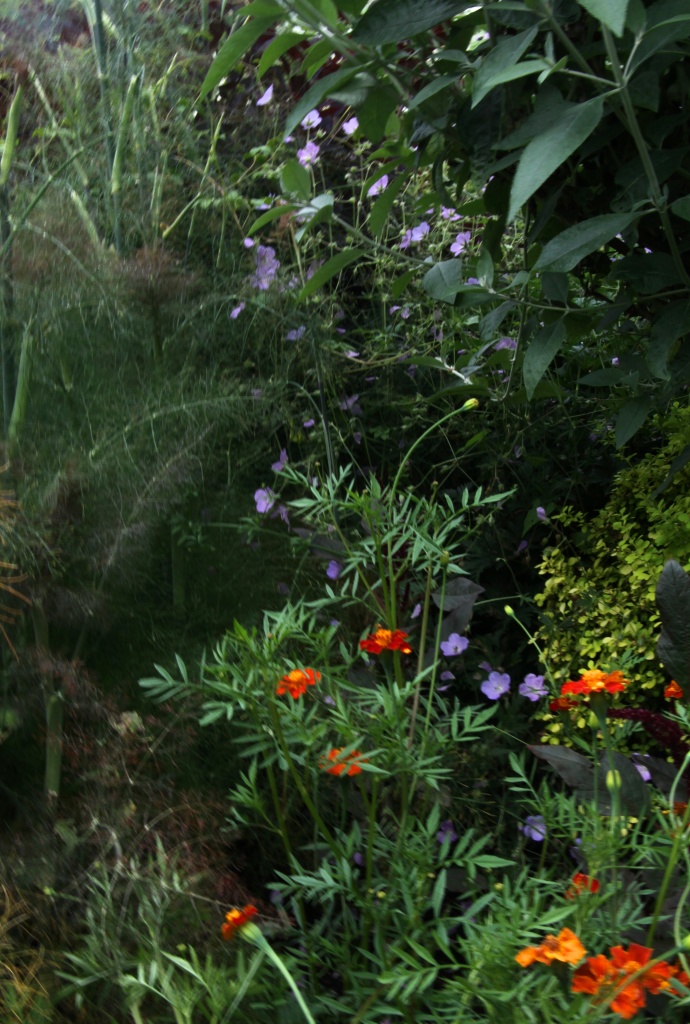 A sombre moment of geranium, bronze fennel and a flash of red marigold
A sombre moment of geranium, bronze fennel and a flash of red marigold
Elsewhere, a stretch of quiet green and white is lit up by a dazzling pocket of Berberis thunbergii “Aurea’:
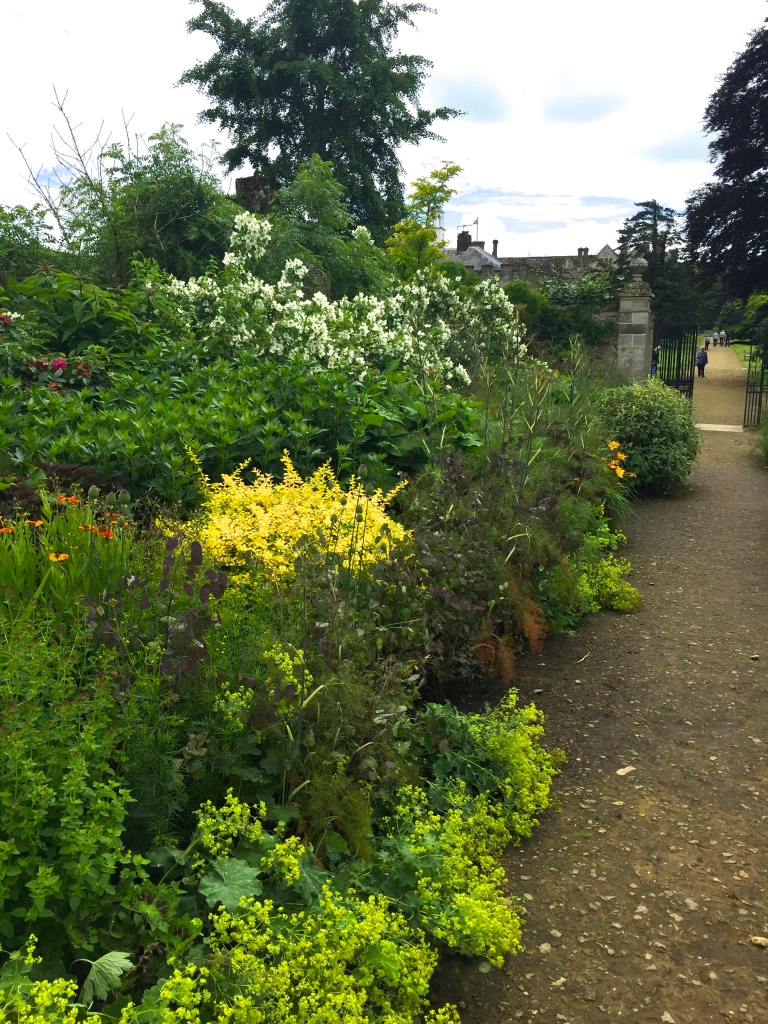 The border is lit up by a pocket of the shrub Berberis thunbergii ‘Aurea’
The border is lit up by a pocket of the shrub Berberis thunbergii ‘Aurea’
Berberis seems to me such an old-fashioned plant, but I am smitten by the way it works in this border and am tempted to try it myself. Here it is again as a fine contrast to a clear mauve geranium (possibly ‘Mrs Kendall Clarke’ ) which in turn sings out against the shady burgundy seed heads of honesty, Lunaria annua:
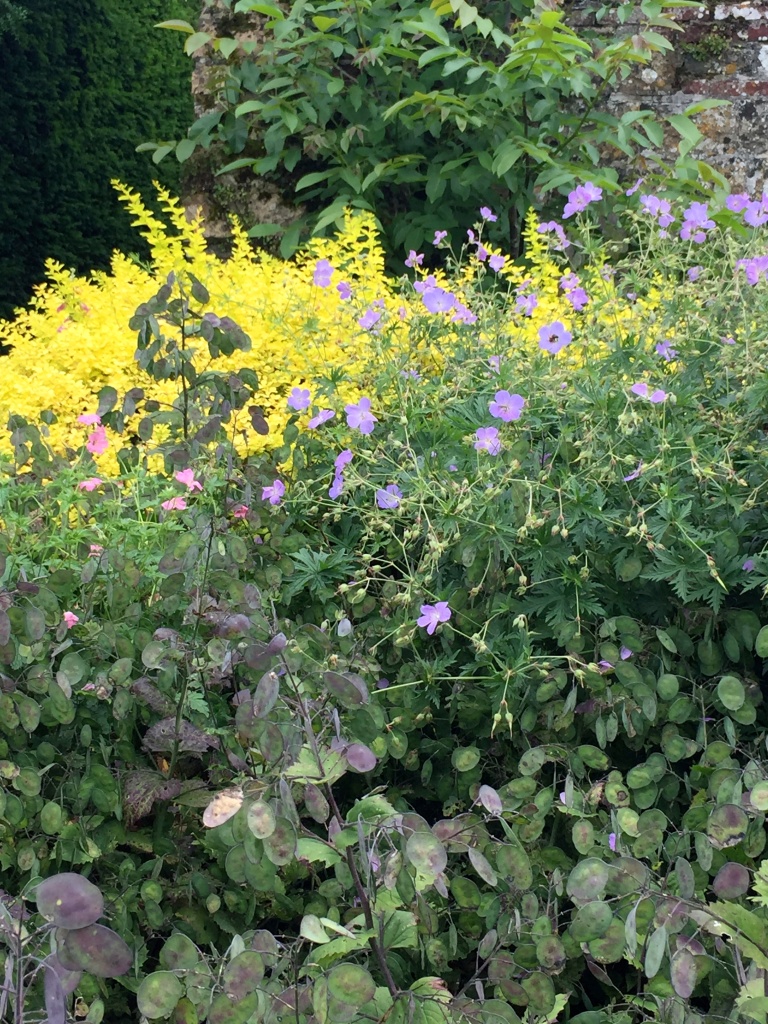 Berberis thunbergii ‘Aurea’ , mauve geranium and seed heads of Lunaria annua
Berberis thunbergii ‘Aurea’ , mauve geranium and seed heads of Lunaria annua
A little further up the same geranium is more intensely luminous against the rounded, deep red leaves of the smoke bush, Cotinus coggygria (probably ‘Royal Purple’):
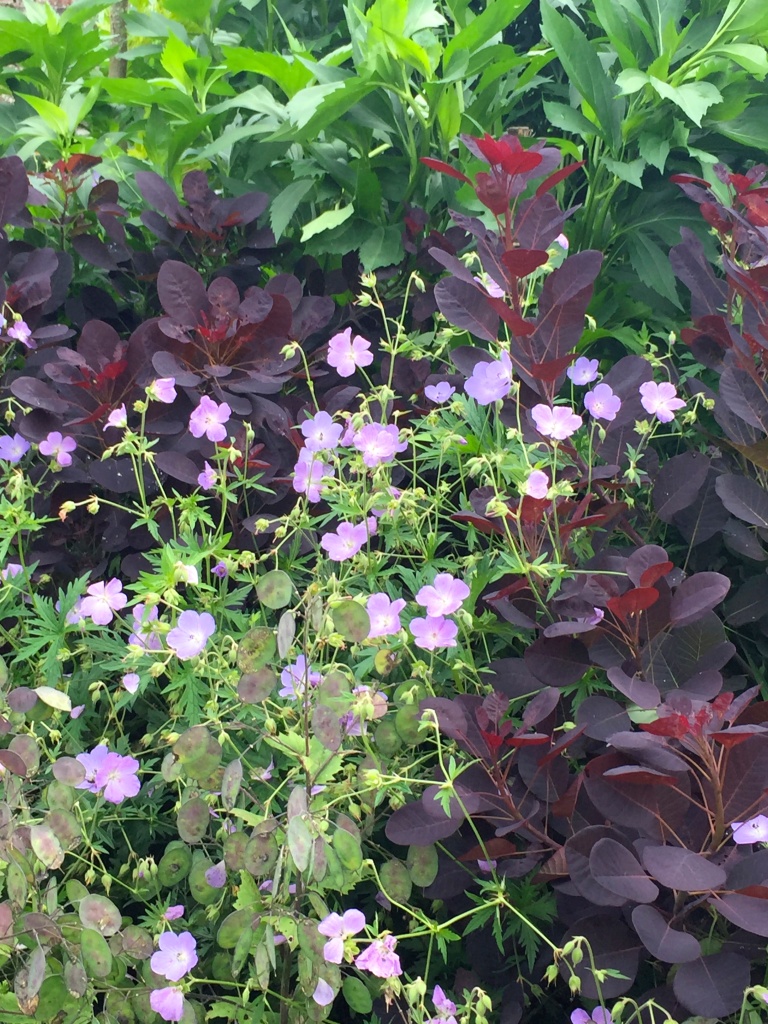
Geranium ‘Mrs Kendall Clarke’ against Cotinus coggygria ‘Royal Purple
And a little further on still, the Cotinus becomes more intense – almost black – when it is a foil to the bright green leaves and vivid pink-red tapers of persicaria amplexicaulis ‘Firetail’:
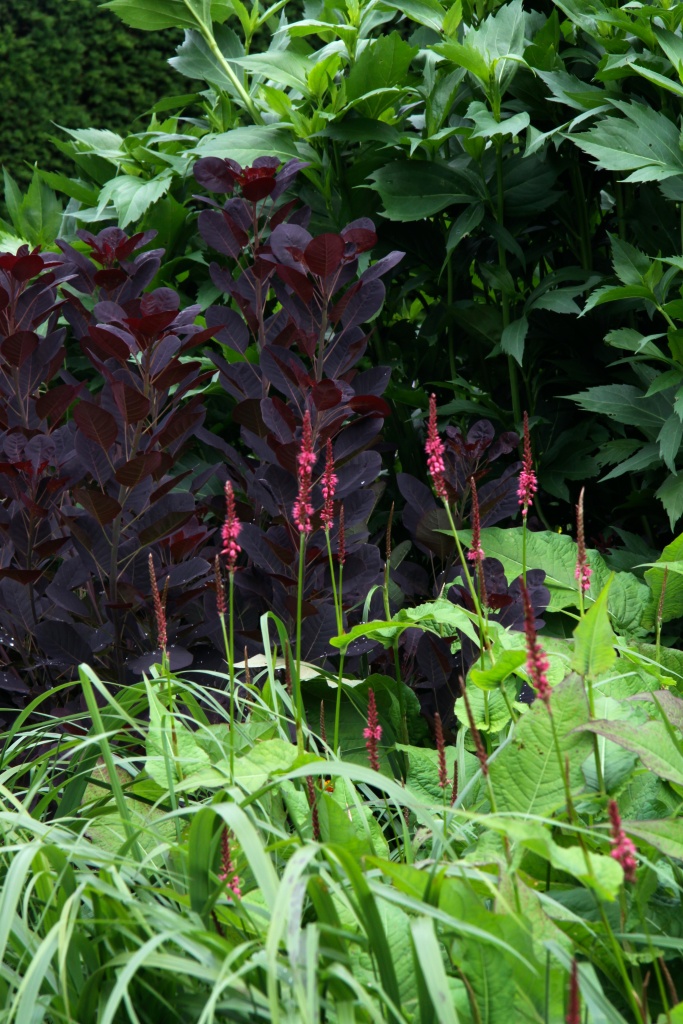 Persicaria amplexicaulis ‘Firetail’ against Cotinus coggygria ‘Royal Purple’
Persicaria amplexicaulis ‘Firetail’ against Cotinus coggygria ‘Royal Purple’
The smaller leaves of the equally dark red berberis, a form of Berberis thunbergii f. atropurpurea, catch the light more easily themselves and form a more balanced picture with the marigold, sedum and daylily in this group:
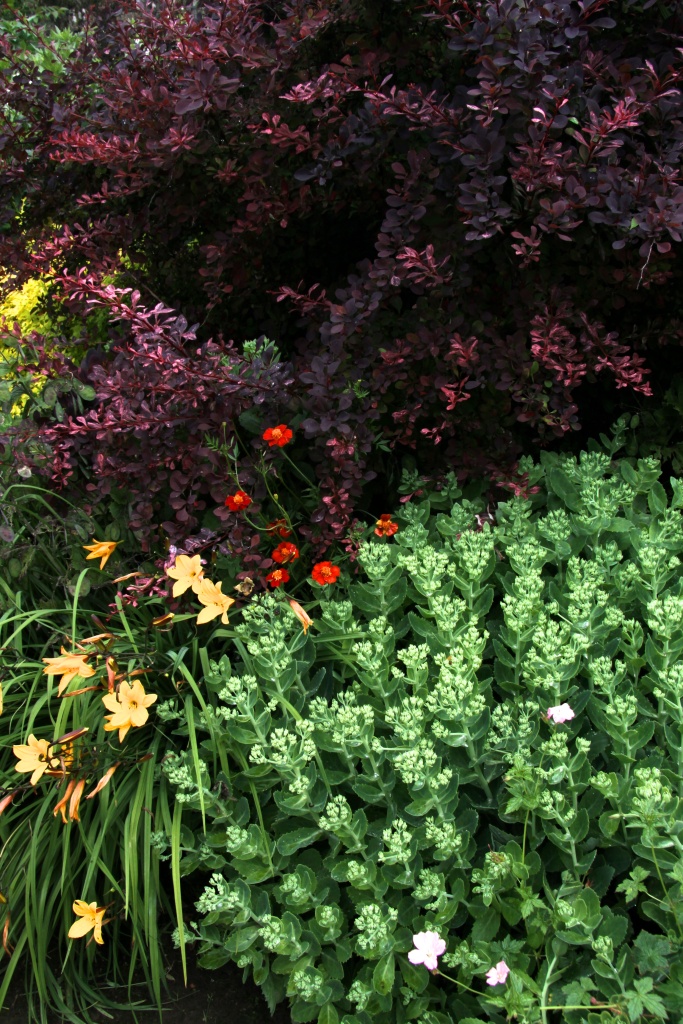 A balanced, light-catching group of Berberis thunbergii f. atropurpurea, red marigold, orange yellow day lily and Sedum ‘Autumn Joy’
A balanced, light-catching group of Berberis thunbergii f. atropurpurea, red marigold, orange yellow day lily and Sedum ‘Autumn Joy’
Looking up, I love the dirty gold-green of golden hops, Humulus lupus ‘Aureus’, and the way it is encouraged to loop and festoon its way over the handsome smudgy green trellis, casting a greenish light on the already not-completely-white Philadelphus.
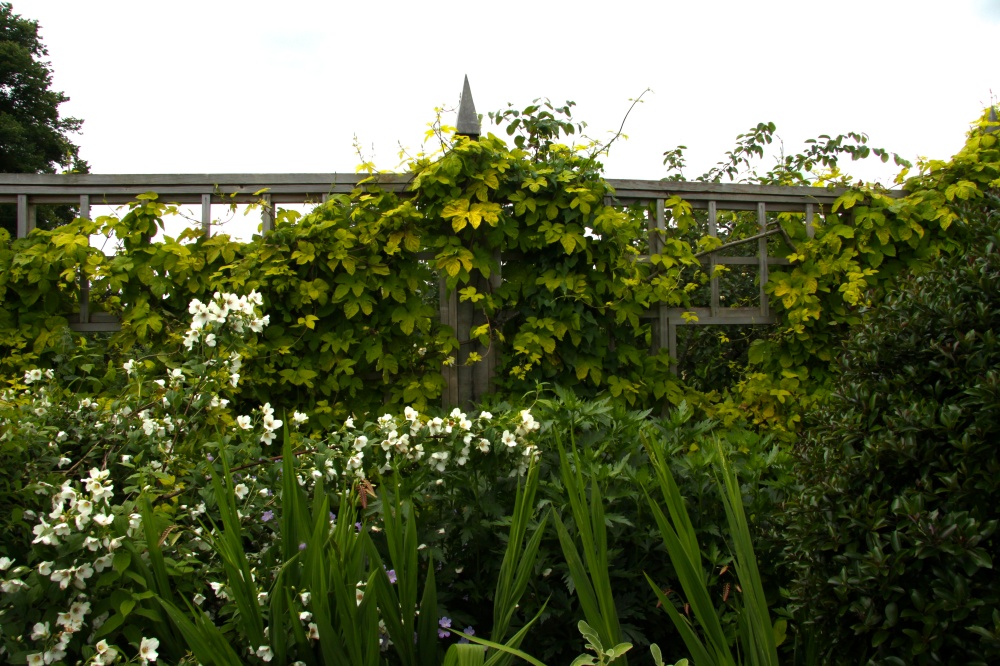 Golden hops festoons the trellis, with sweet-scented Philadelphus in the foreground
Golden hops festoons the trellis, with sweet-scented Philadelphus in the foreground
And I cannot help but be enchanted by the mushroom of brilliant green wisteria foliage that forms a fairy tale entrance into the nursery:
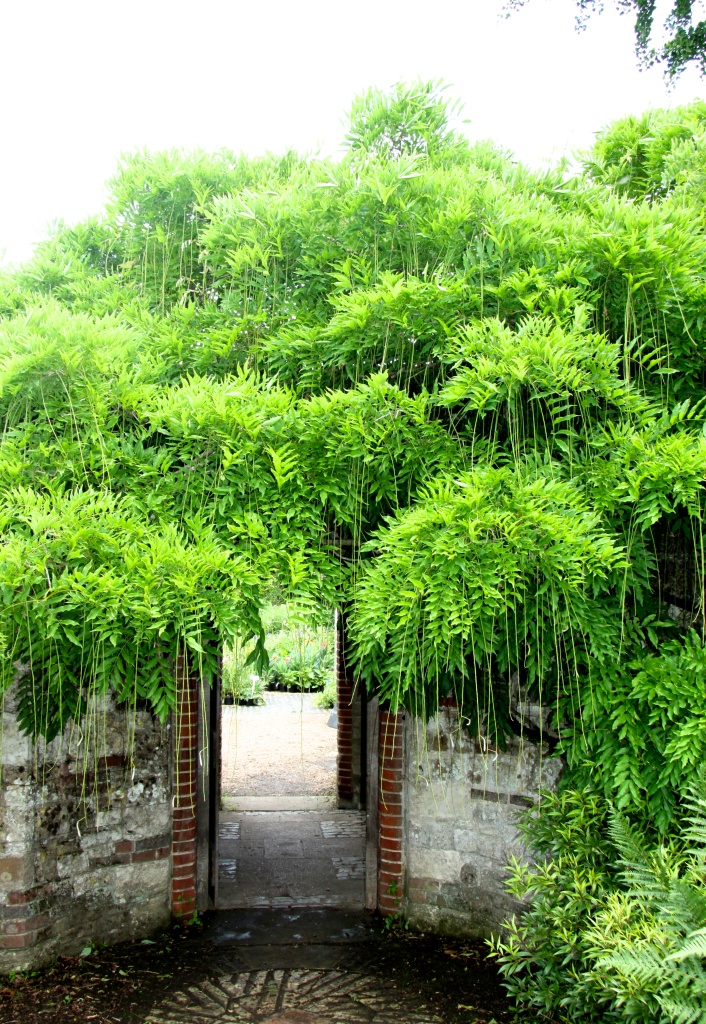
Wisteria foliage makes a fairy tale entrance into the nursery
Further along, another softly clothed opening in the border – alchemilla, pink geranium, red marigold: why not? – leads you through a brick opening into the Herb Garden: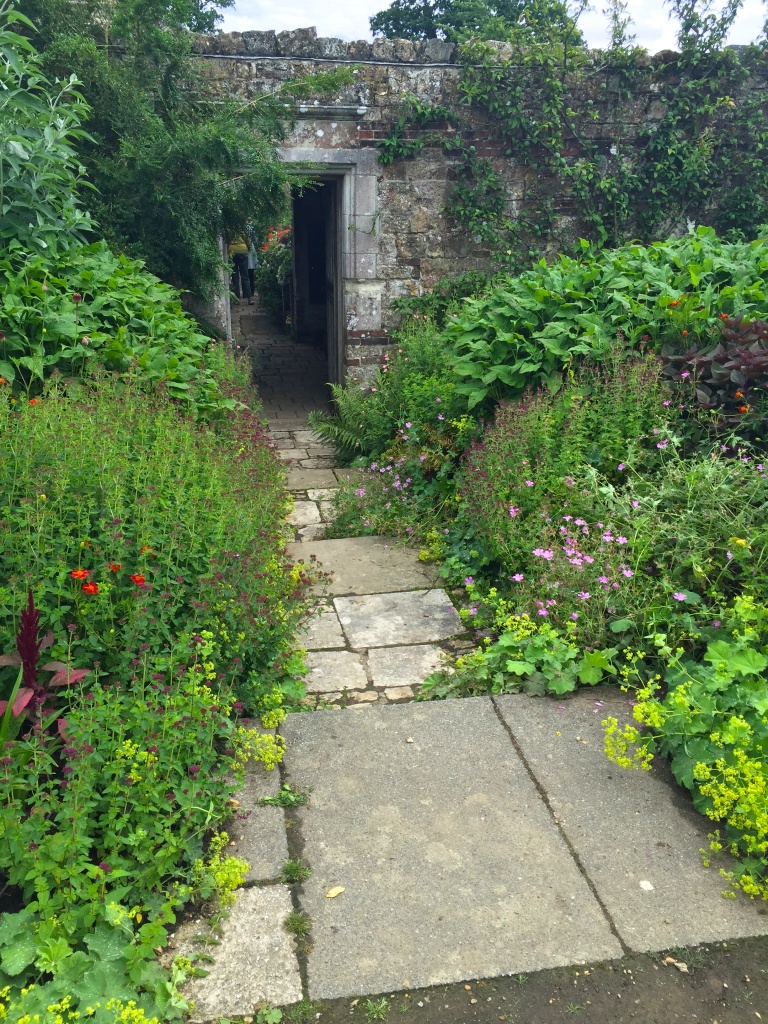 Softly clothed entrance into The Herb Garden
Softly clothed entrance into The Herb Garden
The Herb Garden at Parham is pretty perfect. There are four completely charming, immaculately proportioned, wooden benches, one in each corner of this voluptuous space enclosed in high hedges of clipped yew. Each bench is settled lightly and invitingly into its corner. I love the bench below with its patchwork apron of worn flagstones and Alchemilla mollis, its simple backdrop of upright ferns and its anchoring neighbour, a rectangular stone trough which is gently fizzing with slightly psychedelic pink and grey succulents.
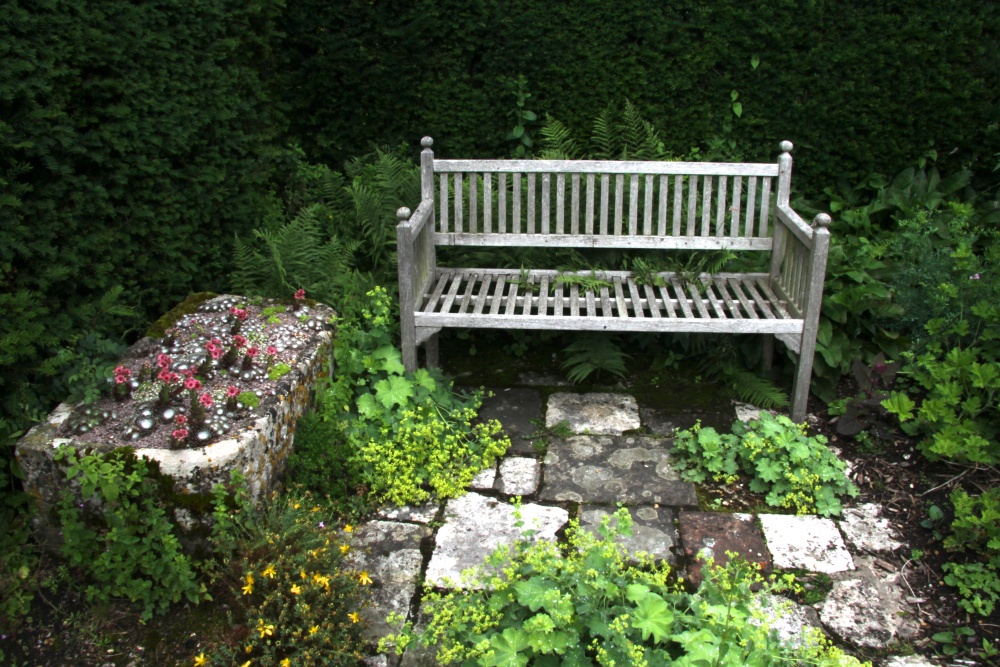
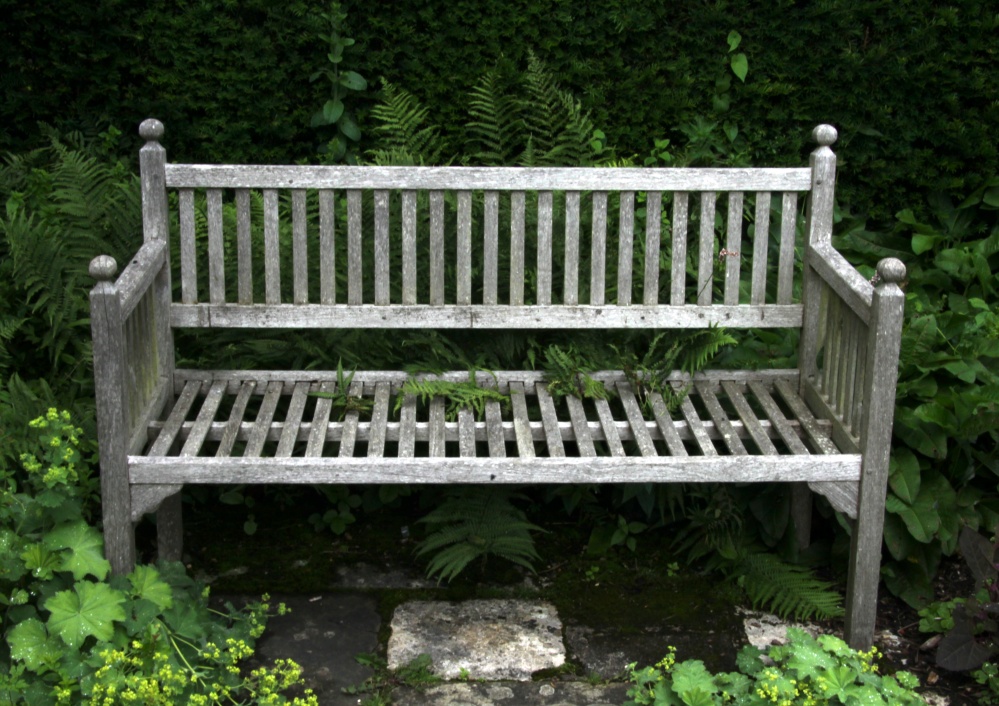
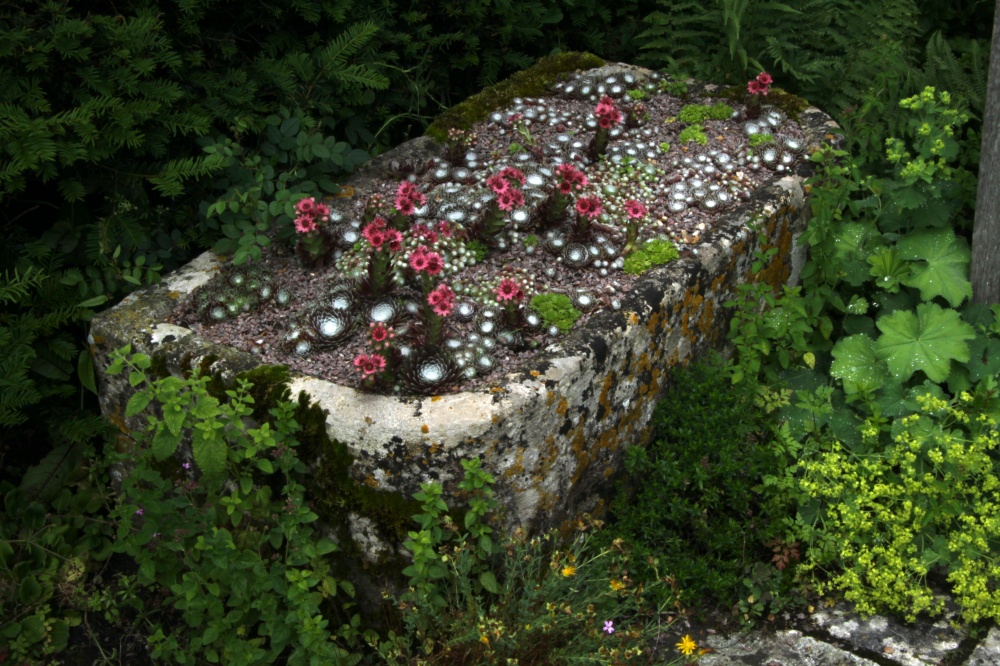
 One of four perfect benches in The Herb Garden – this one settled into its space with a stone trough planted with slightly psychedelic pink and grey succulents
One of four perfect benches in The Herb Garden – this one settled into its space with a stone trough planted with slightly psychedelic pink and grey succulents
Another bench is at the end of a small, winding green path brightened with tantalising spires of the slender cream foxglove, Digitalis lutea:
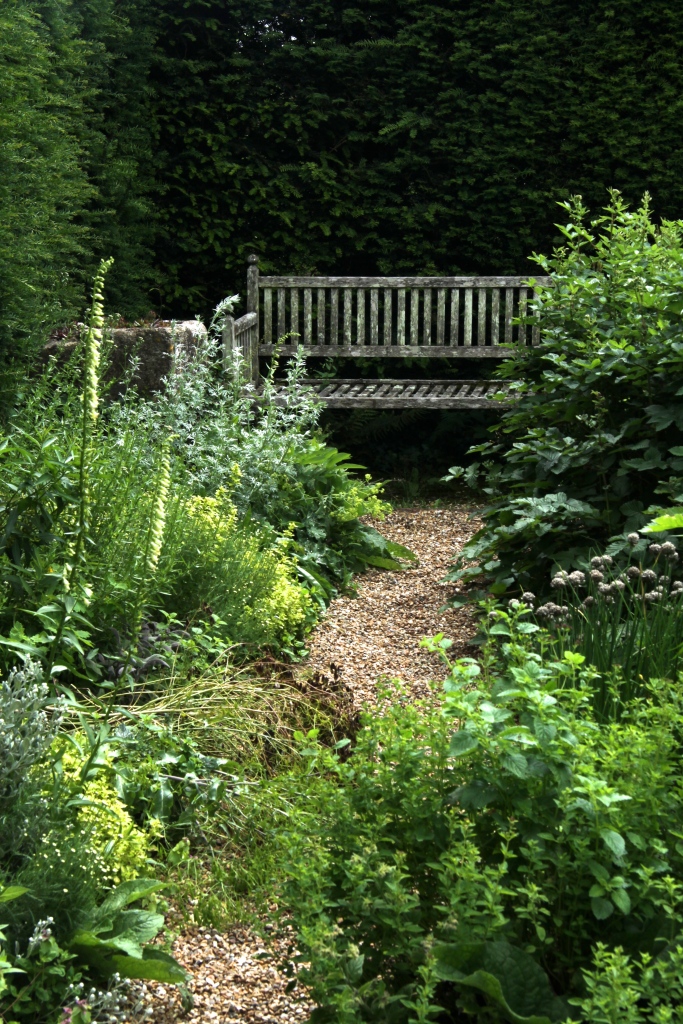 Winding gravel path to a second bench with slender spires of the creamy Digitalis lutea
Winding gravel path to a second bench with slender spires of the creamy Digitalis lutea
A third bench is satisfyingly deeply set in the shade of an old apple tree:
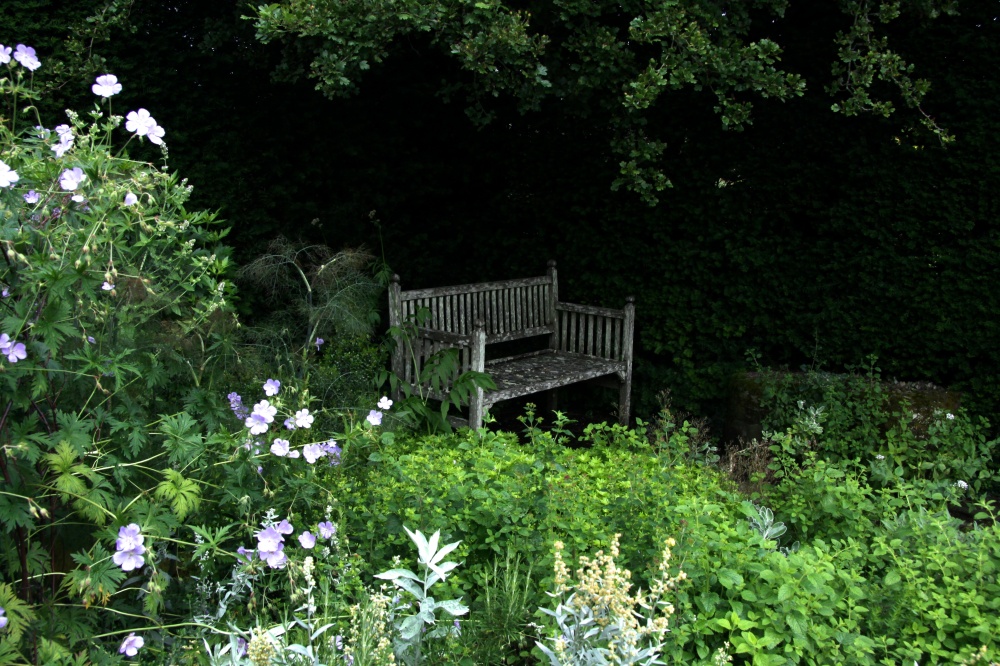 A third bench deep in the shade of an old apple tree
A third bench deep in the shade of an old apple tree
The centre of the Herb Garden is exuberantly planted with culinary herbs and herbaceous perennials. The almost decadently fading flowers of the towering Angelica archangelica take centre stage, with the tall daisy-like flowers of inula providing a fresher yellow, and the tiny button like lemon-yellow flowers of the green leaved santolina, Santolina pinnata subsp. neapolitana, making a handsome curved edging for the central pond.
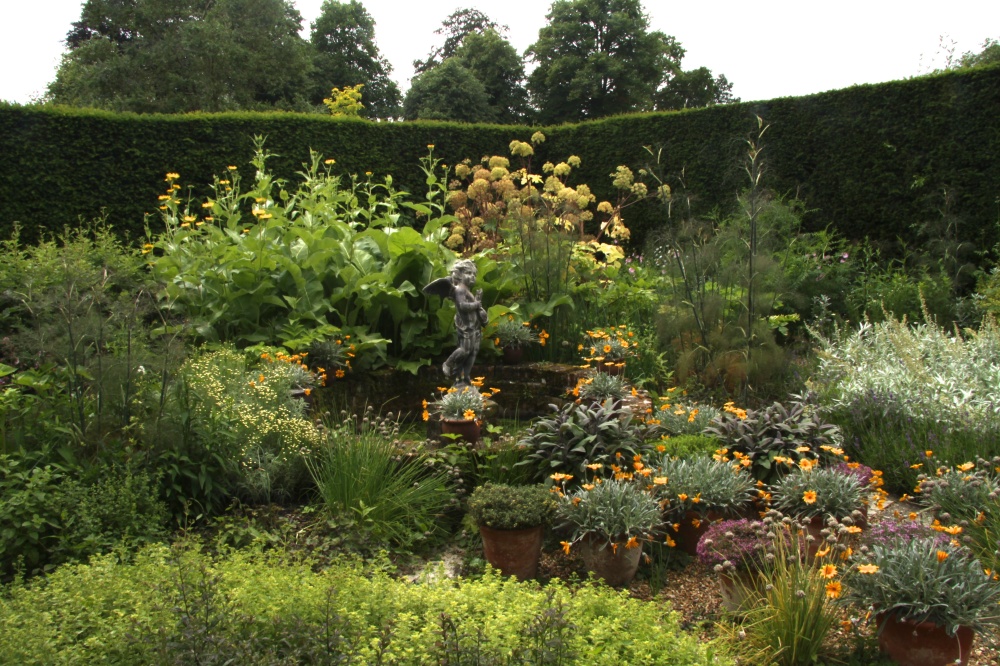
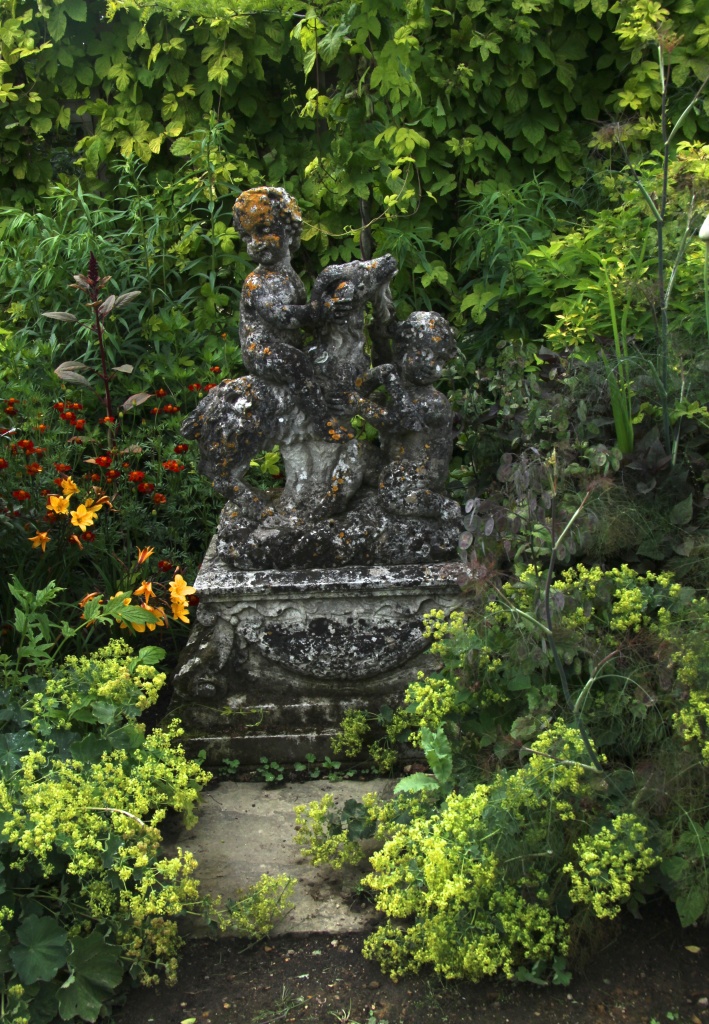
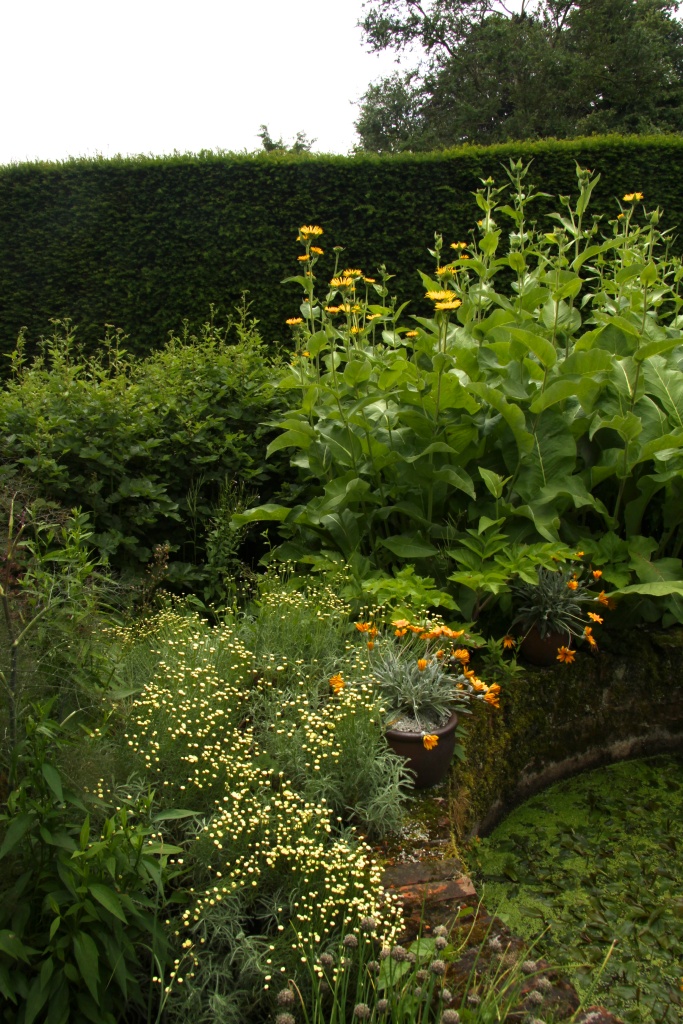
The centre of The Herb Garden with towering Angelica archangelica, Alchemilla mollis everywhere and the tiny lemon yellow flowers of Santollina pinnata subsp. neapolitana edging the pond.
The way out of the Herb Garden looks as richly enticing as the way in – you know you are in the hands of masterful gardeners:
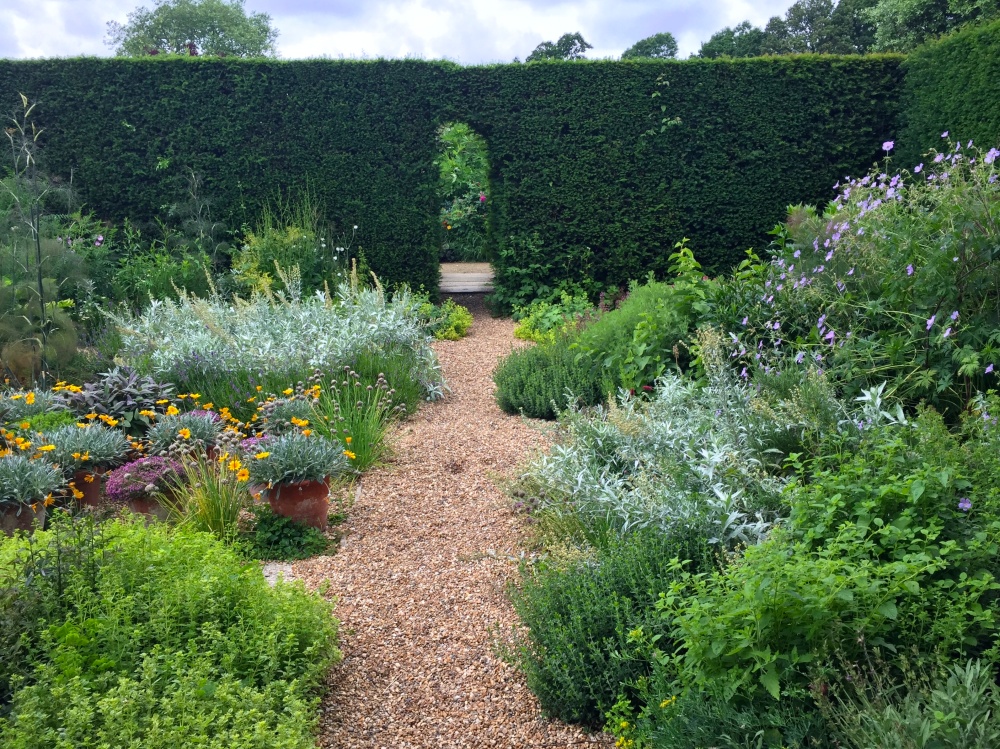 View as you leave The Herb Garden
View as you leave The Herb Garden
A central pair of borders, The Blue and Gold Borders, cross the entire walled garden, with cooler blue colours to the West and warmer gold colours to the East:
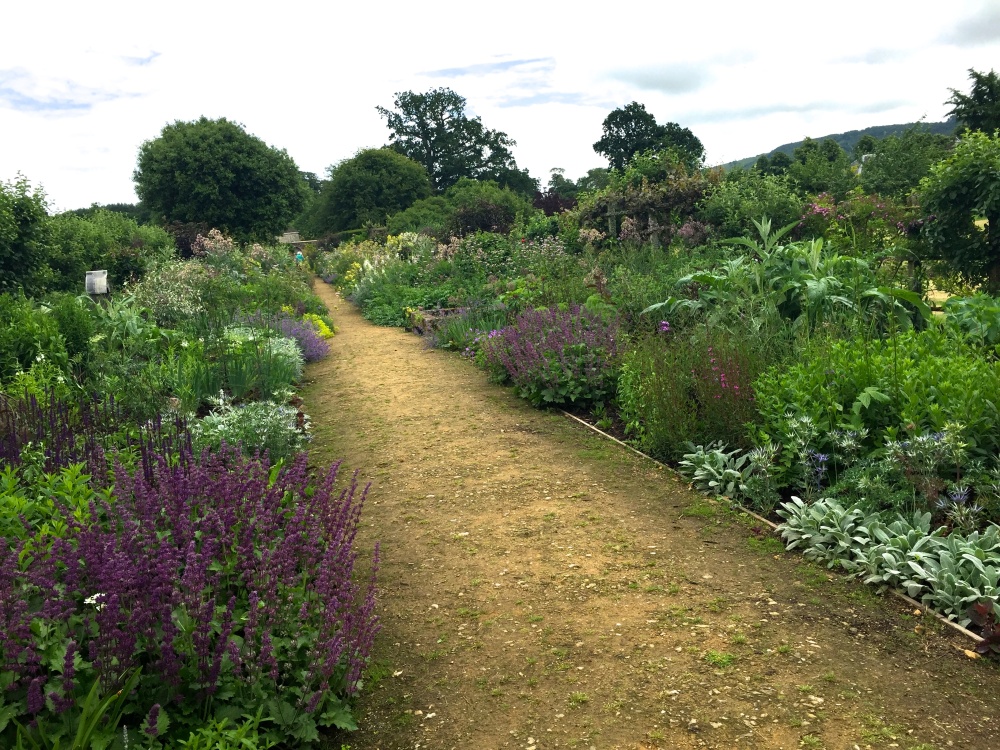 FIrst view of the Blue Border
FIrst view of the Blue Border
The borders are flanked at intervals by muscly espalier apple trees and elsewhere by simple wooden fencing which is cleverly broken up by basic wooden arches in a staggered art deco shape. These work brilliantly, especially as they age and become covered in lichen and, as here, host the purple leaved vine Vitis vinifera ‘Purpurea’:
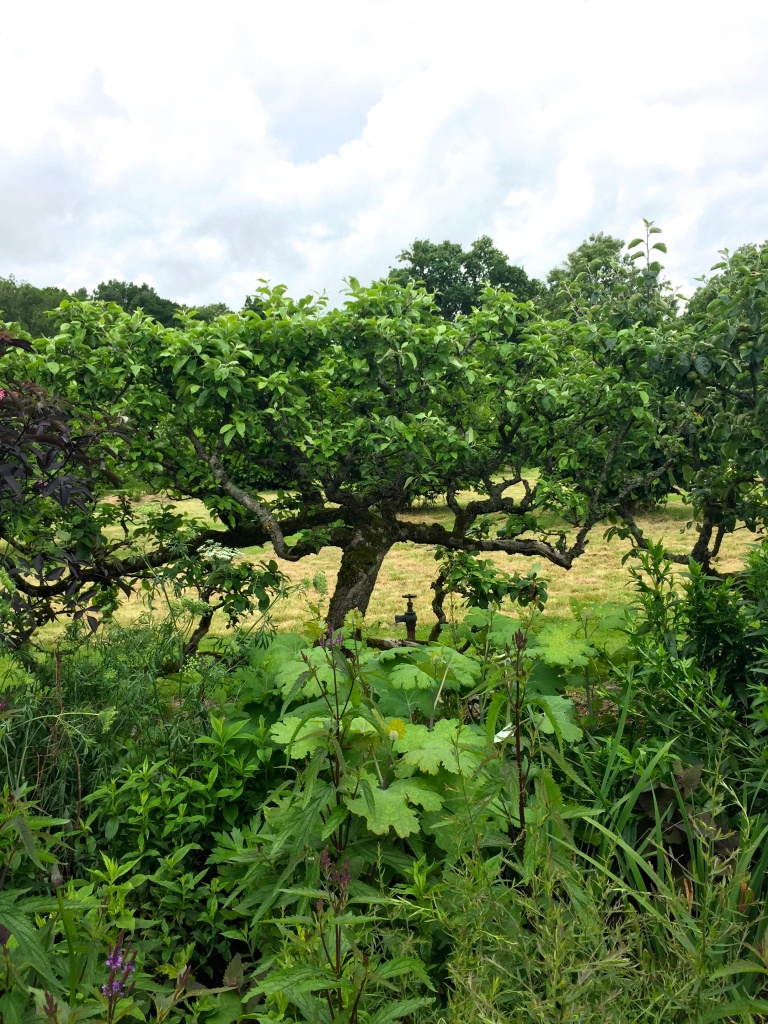 Espalier apple trees edge the border
Espalier apple trees edge the border
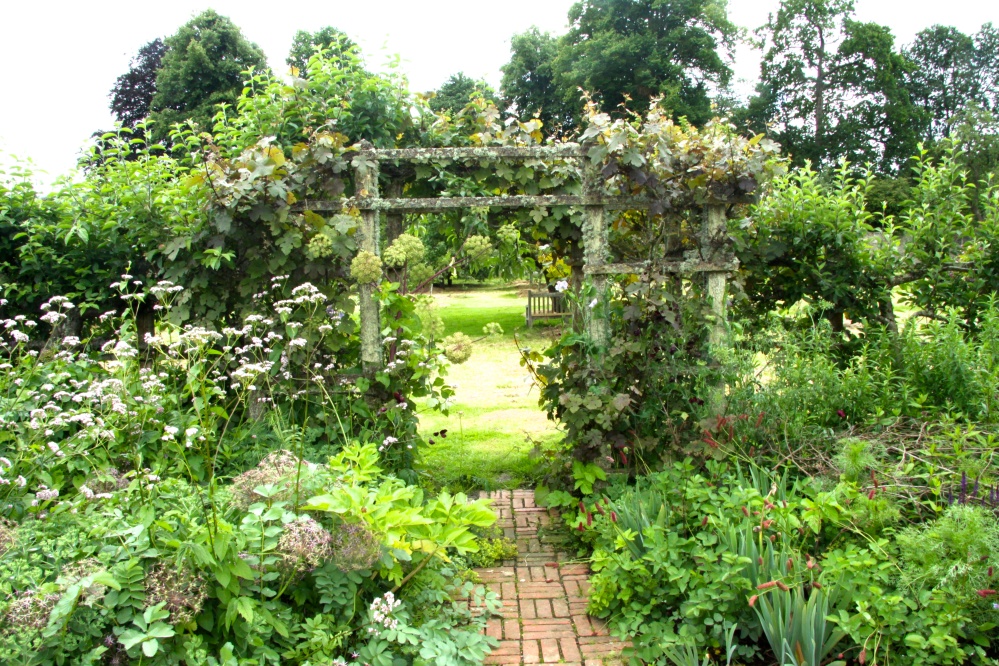
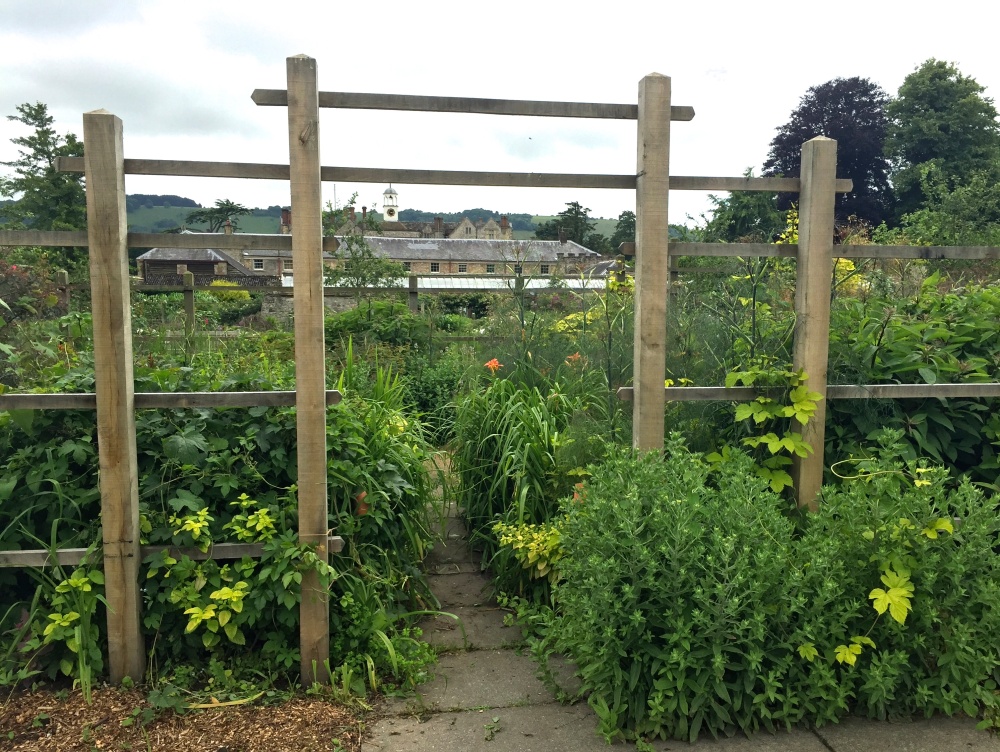 Art deco style arches act as pause points in the fence – the older lichen-covered arch above is clothed in Vitis vinifera ‘Purpurea’
Art deco style arches act as pause points in the fence – the older lichen-covered arch above is clothed in Vitis vinifera ‘Purpurea’
The planting at the ‘blue’ end is particularly inspiring. In this photograph, the white rosebay willow herb, Chamerion angustifolium ‘Album’, is planted with the palest lilac-flowered Valeriana pyrenaica. Tall stands of red orach, Atriplex hortensis var. rubra, pick up the maroon staining of the Valerian’s stems and allow the white and dusky lilac to be read. It is a gorgeous group of plants.
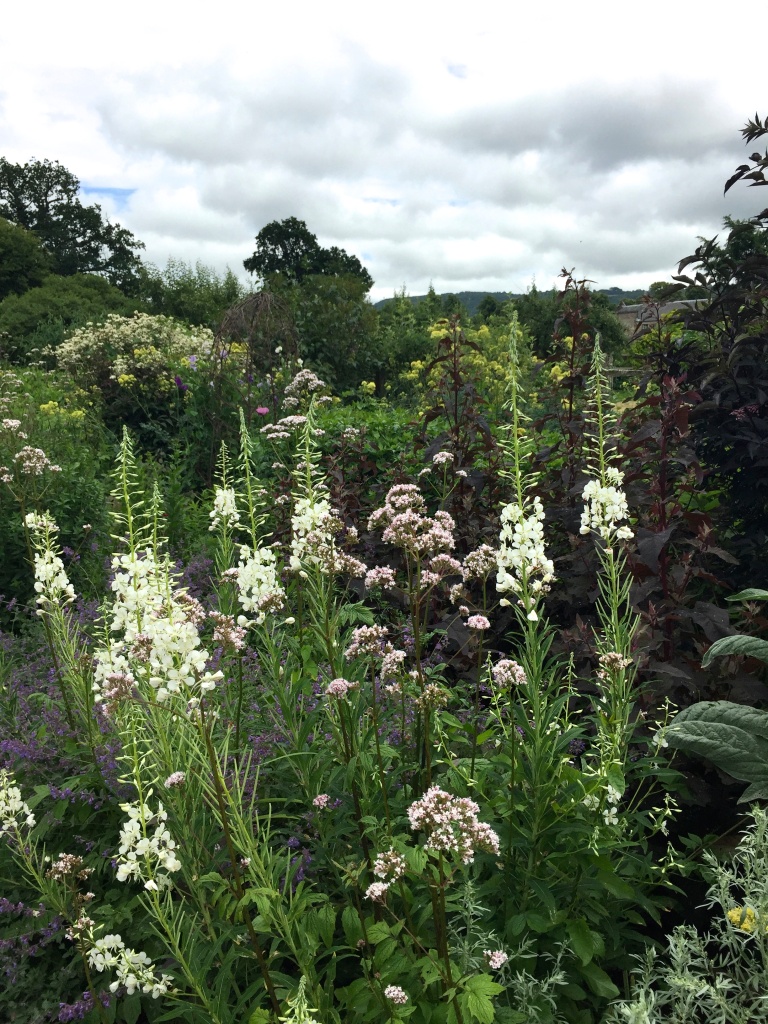 Chamerion angustifolium ‘Album’, Valeriana pyrenaica and red orach
Chamerion angustifolium ‘Album’, Valeriana pyrenaica and red orach
A little further on, the all-yellow, fluffy headed thalictrum, Thalictrum flavum subsp. glaucum (which I have never used, but faithful readers will know that I am becoming an unstoppable fan of the colour yellow in the garden) provides a soft foil for the vibrant Persicaria amplexicaulis ‘Firetail’:
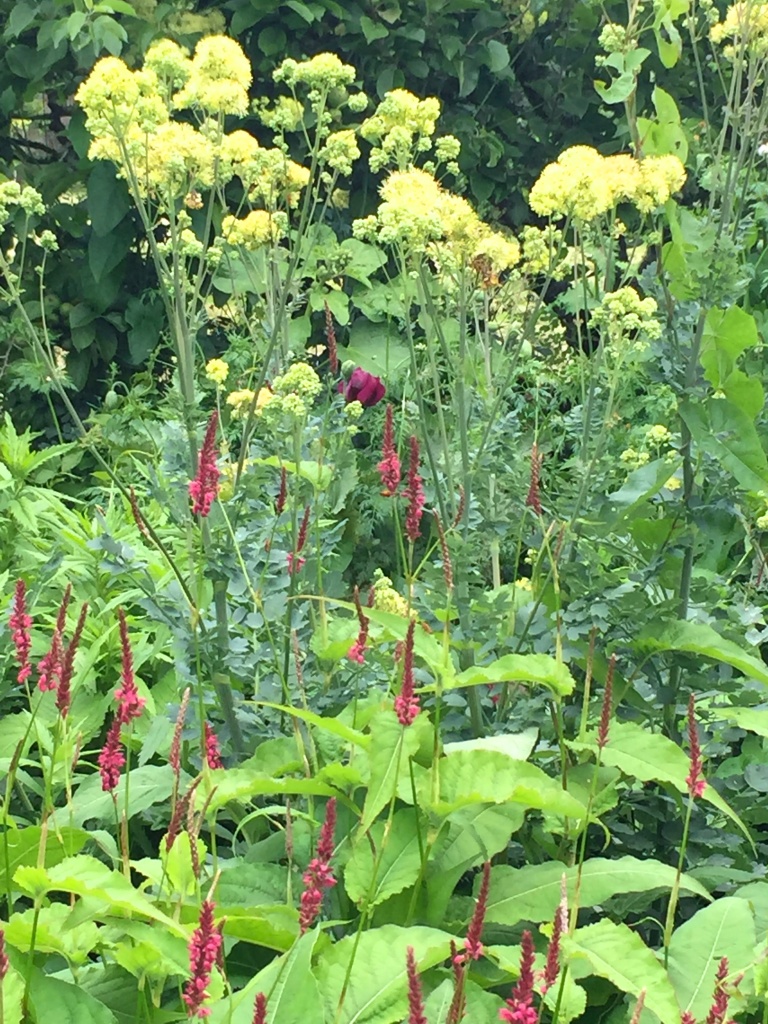 Thalictrum flavum subsp. glaucum and Persicaria ‘Firetail’
Thalictrum flavum subsp. glaucum and Persicaria ‘Firetail’
And elsewhere, the bicolour taller thalictrum, Thalilctrum ‘Elin’, is an intriguing combination of soft yellow and purple:
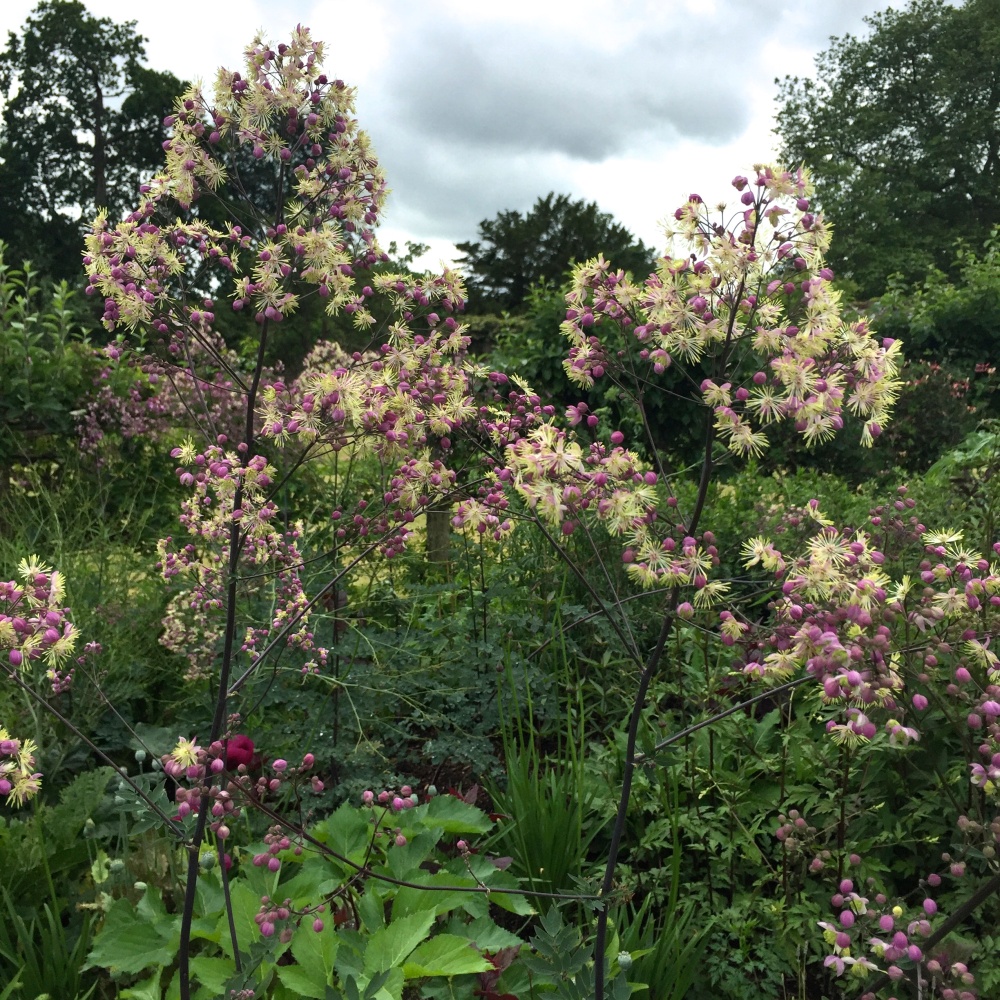 Thalictrum ‘Elin’
Thalictrum ‘Elin’
At this point in the border, the mix of low-key yellow, faded pink and white have a seductive 70’s polaroid quality:
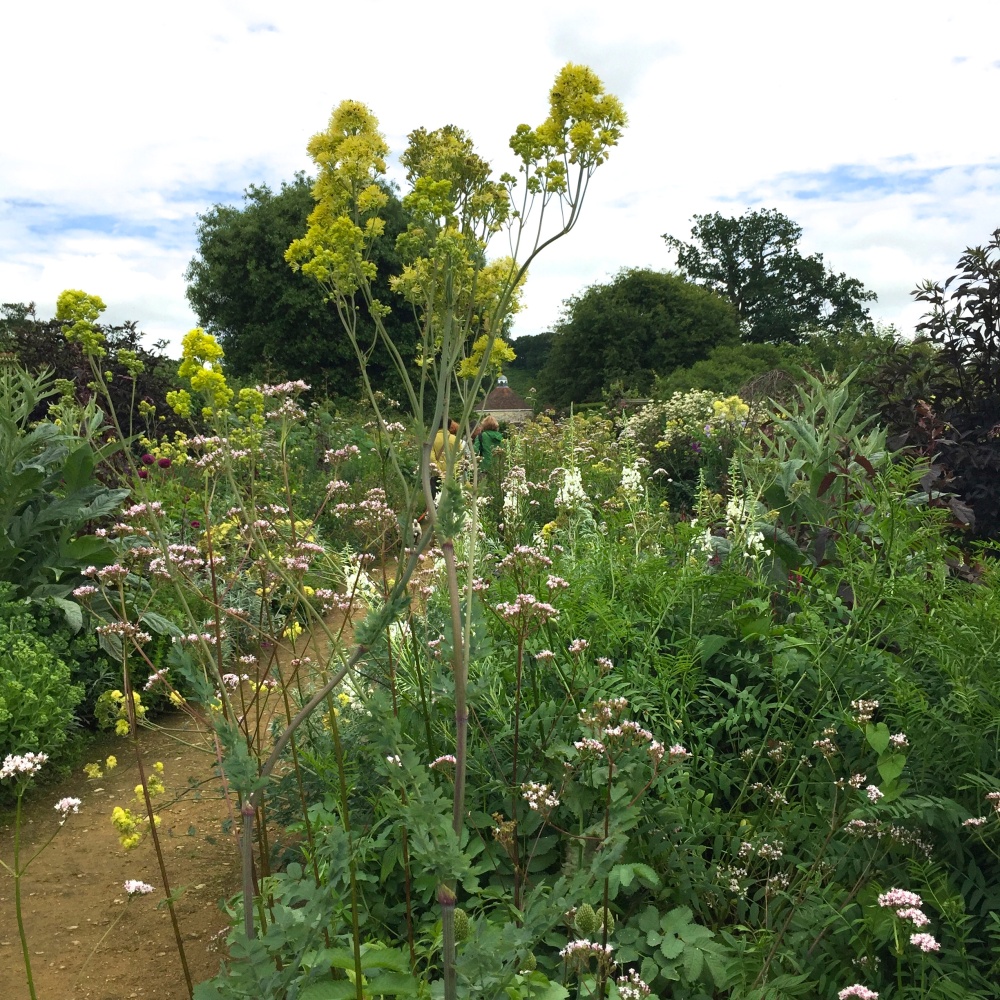 Thalictrum flavum subsp. glaucum, Valeriana pyrenaica, Chamerion angustifolium ‘Album’
Thalictrum flavum subsp. glaucum, Valeriana pyrenaica, Chamerion angustifolium ‘Album’
The classic, mound-forming, silver foliage plant, Artemisia ludoviciana ‘Valerie Finnis’ is one that has definitely moved higher up my list of plants to try to bring a border together with a gentle sparkle. It is used throughout the garden and is a wonderful foil for both bright and more subtle colours.
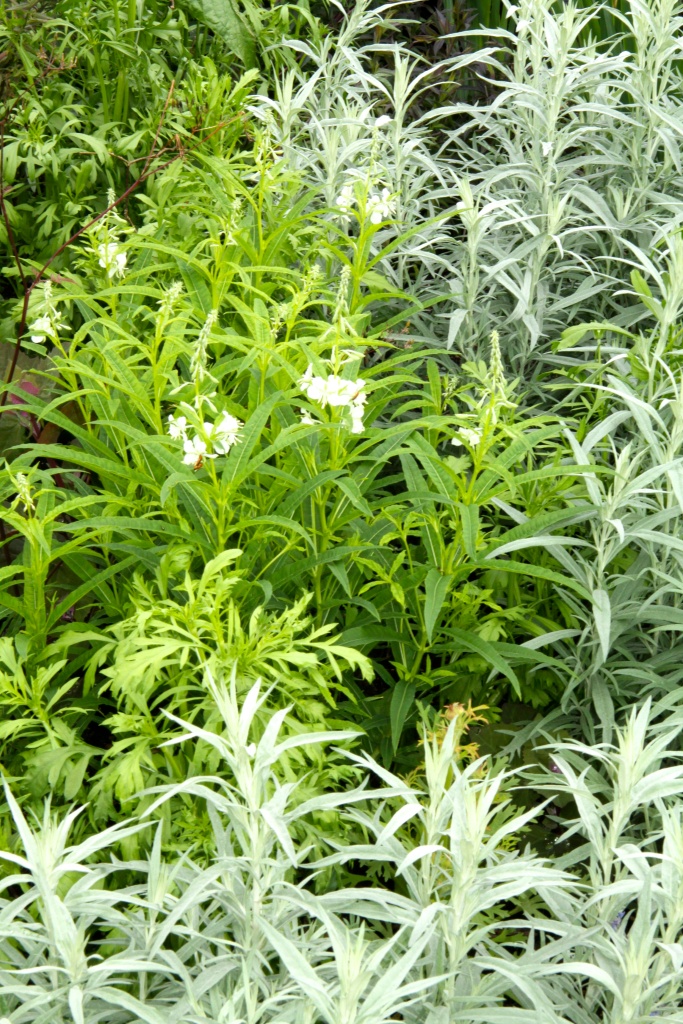
The silver foliage of Artemisa ludoviciana ‘Valerie Finnis’ with the just emerging Chamerion angustifolium ‘Album’
Elsewhere there are the rich purple uprights of Salvia nemerosa ‘Caradonna’ together with the dreamier mauve-pink catmint (probably) Nepeta grandiflora ‘Dawn to Dusk’ – the opposing qualities of each plant work surprisingly well when put next door to each other.
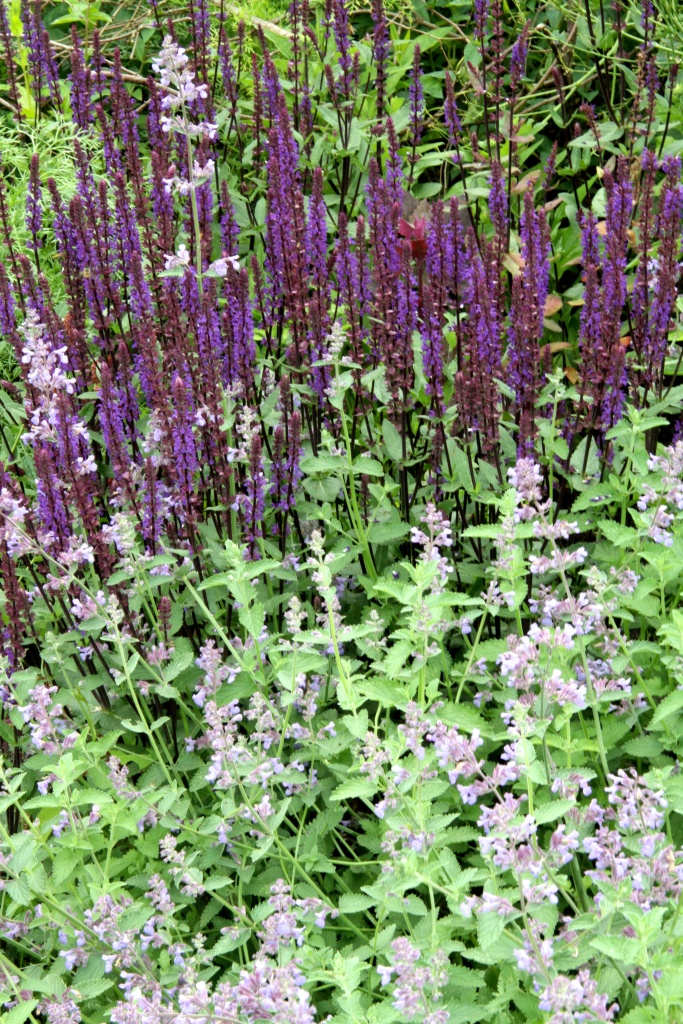
Salvia nemerosa ‘Caradonna’ with Nepeta grandiflora ‘Dawn to Dusk’
The salvia, together with classic blue catmint and a rich blue geranium, anchor the border and keep it just about in the blue/purple spectrum!
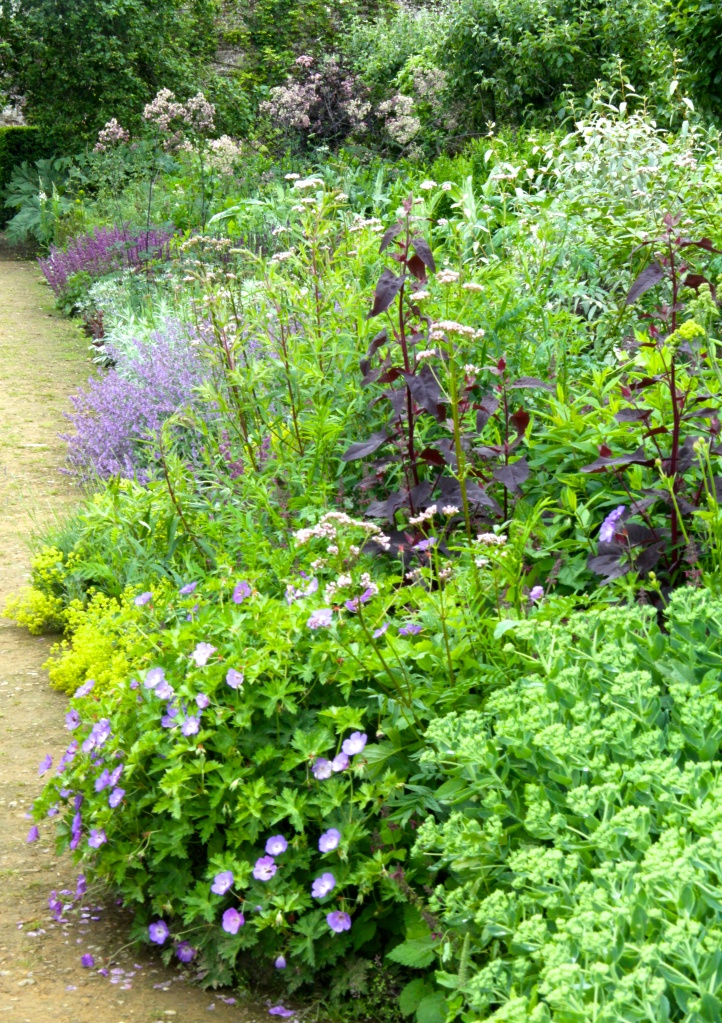 Mounds of salvia, catmint and blue geranium anchor the border
Mounds of salvia, catmint and blue geranium anchor the border
There is an immediate colour shift as you approach the Gold Border. Stipa gigantea erupts with its usual brilliancy into a series of fine bronze fireworks and, here, the sword-like foliage and pale yellow flowers of Sisyrinchium striatum anchors the planting:
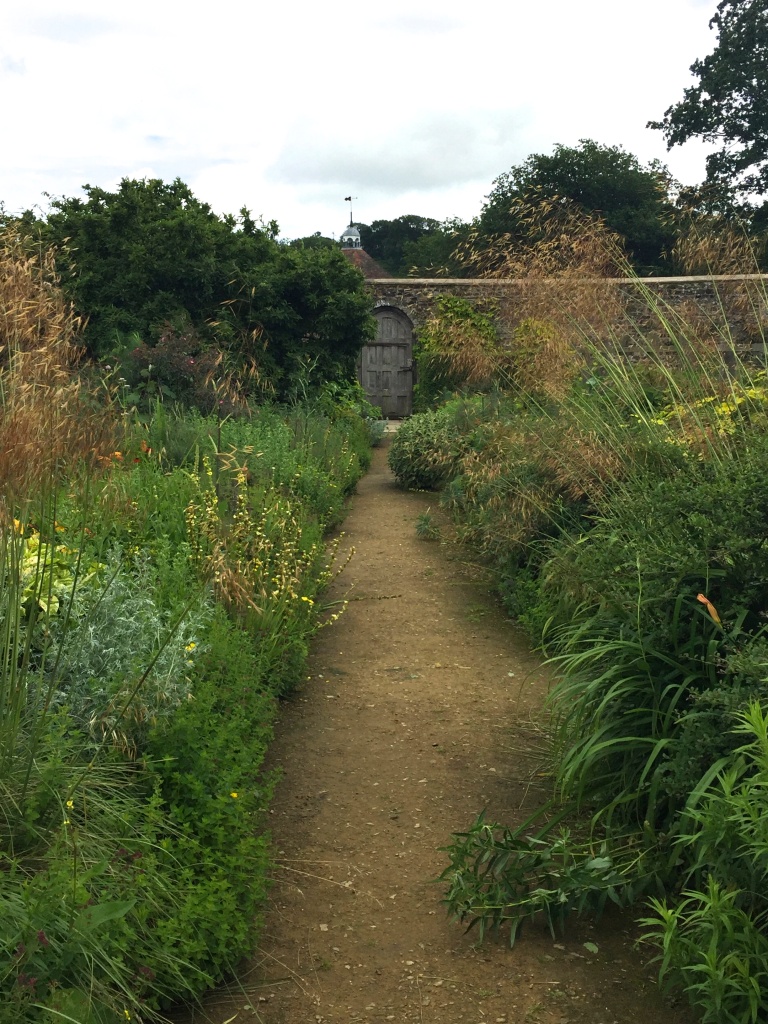
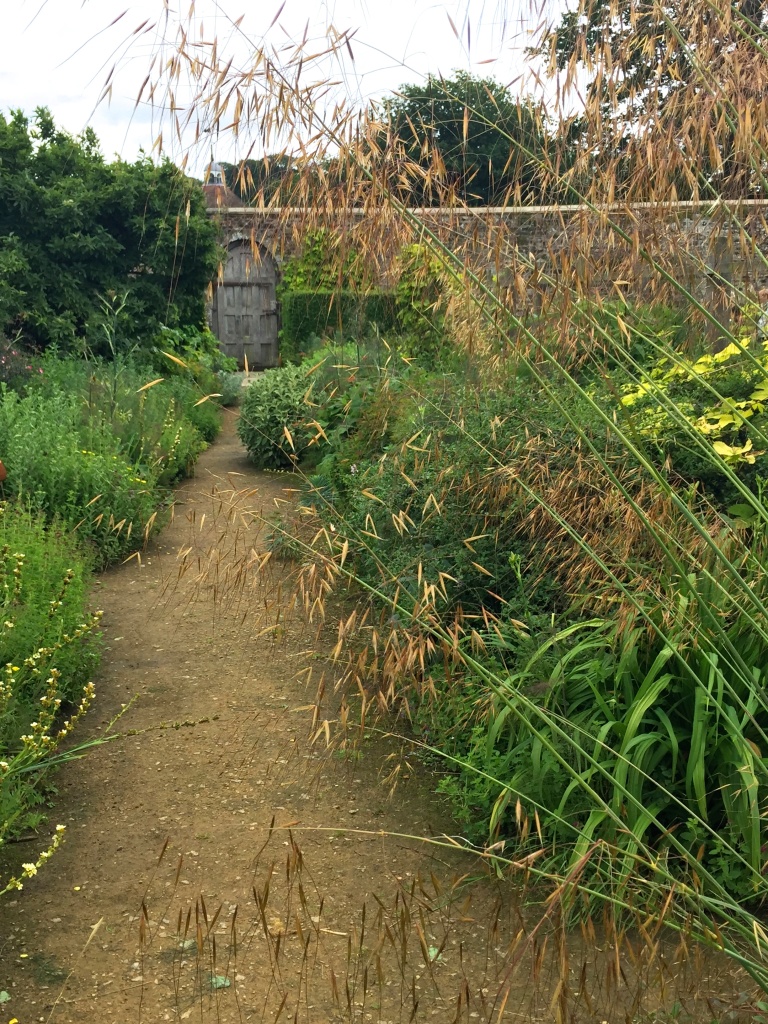
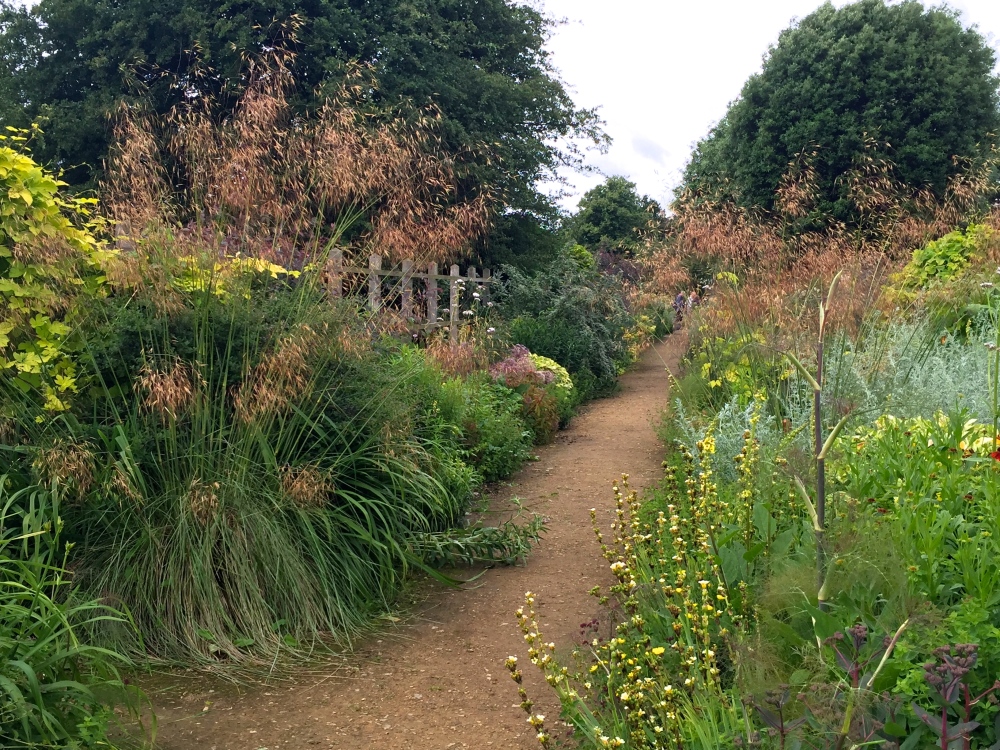 The bronze fireworks of Stipa gigantea are anchored by the swordlike foliage and pale yellow flowers of Sisyrinchium striatum in the Gold Border
The bronze fireworks of Stipa gigantea are anchored by the swordlike foliage and pale yellow flowers of Sisyrinchium striatum in the Gold Border
The subtle colouring continues with the coppery mauve foliage of Rosa glauca acting as a foil for pale lilac Valeriana pyrenaica – with the dirty gold of Humulus lupulus ‘Aureus’ above and golden marjoram below lighting up the scene.
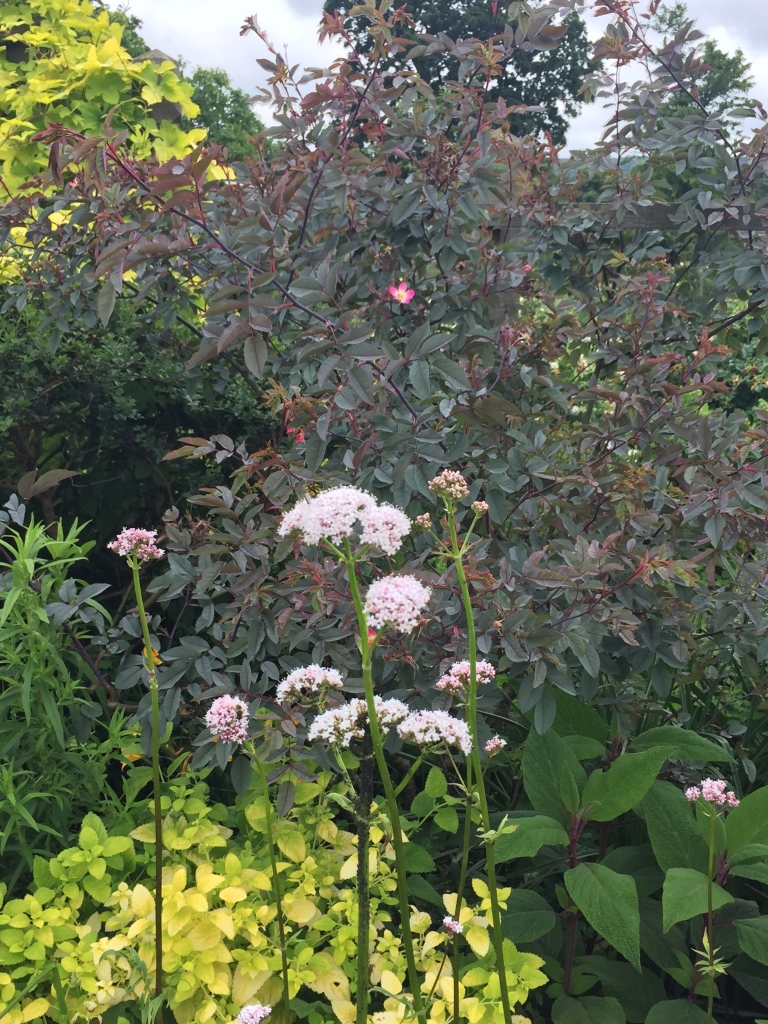
Rosa glauca with Valeriana pyrenaica, Humulus lupulus ‘Aureus’ and Origanum vulgare ‘Aureum’
The dusky mauve Sedum ‘Matrona’ – my favourite sedum – is introduced as a deft rhythmic base plant and then little shocks are introduced: more golden hops threaded though at low level, a burnt orange knifophia singing out from a haze of bronze fennel, and then a flotilla of flat red brown heads amongst the mauves: Achillea millefolium ‘Terracotta’:
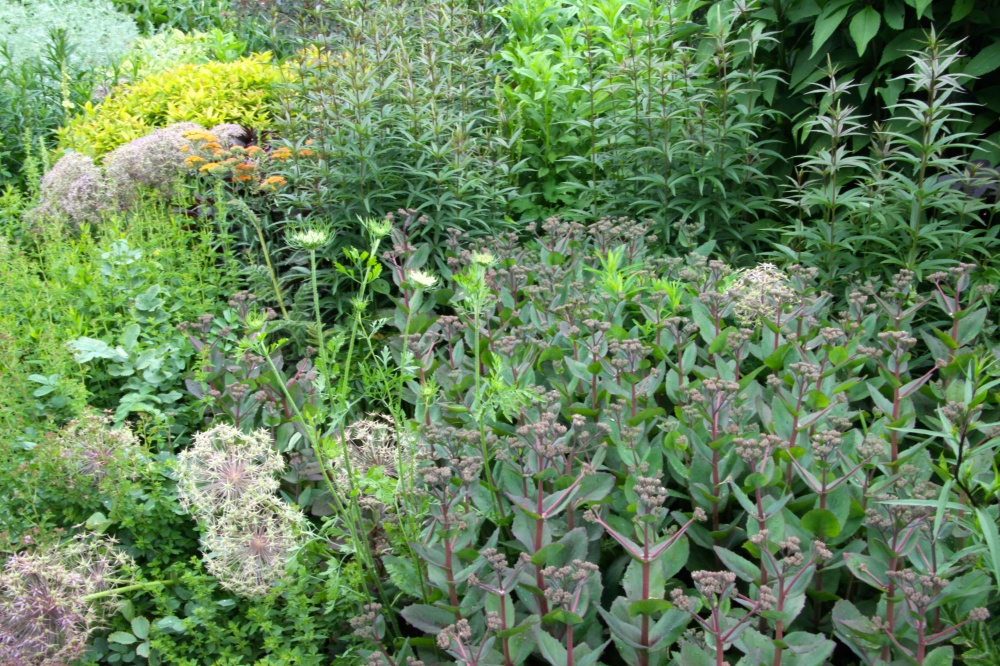
Sedum ‘Matrona’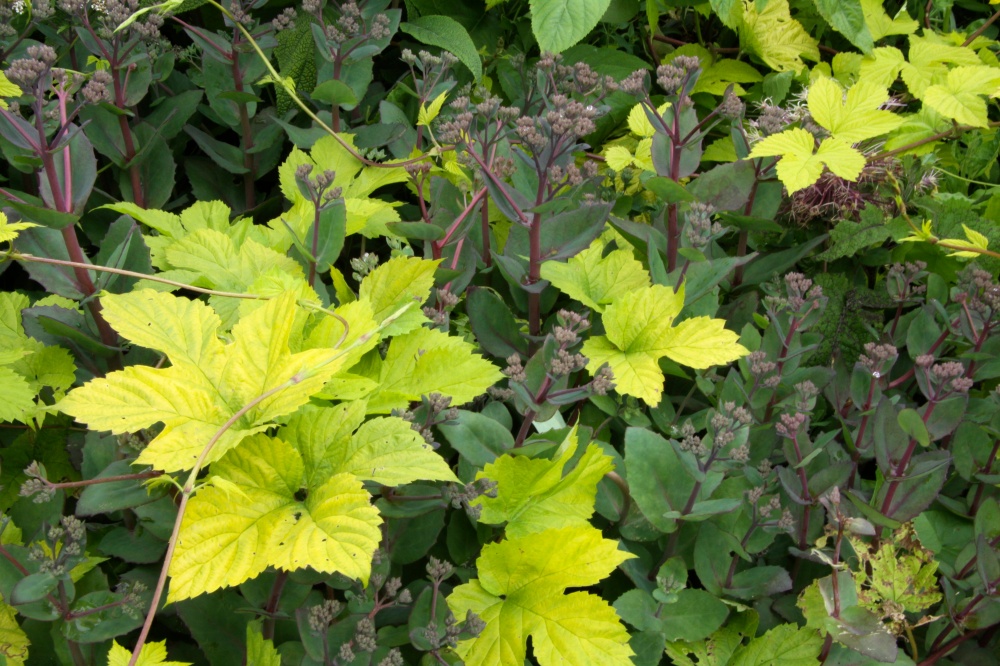 Sedum ‘Matrona’ with golden hops
Sedum ‘Matrona’ with golden hops
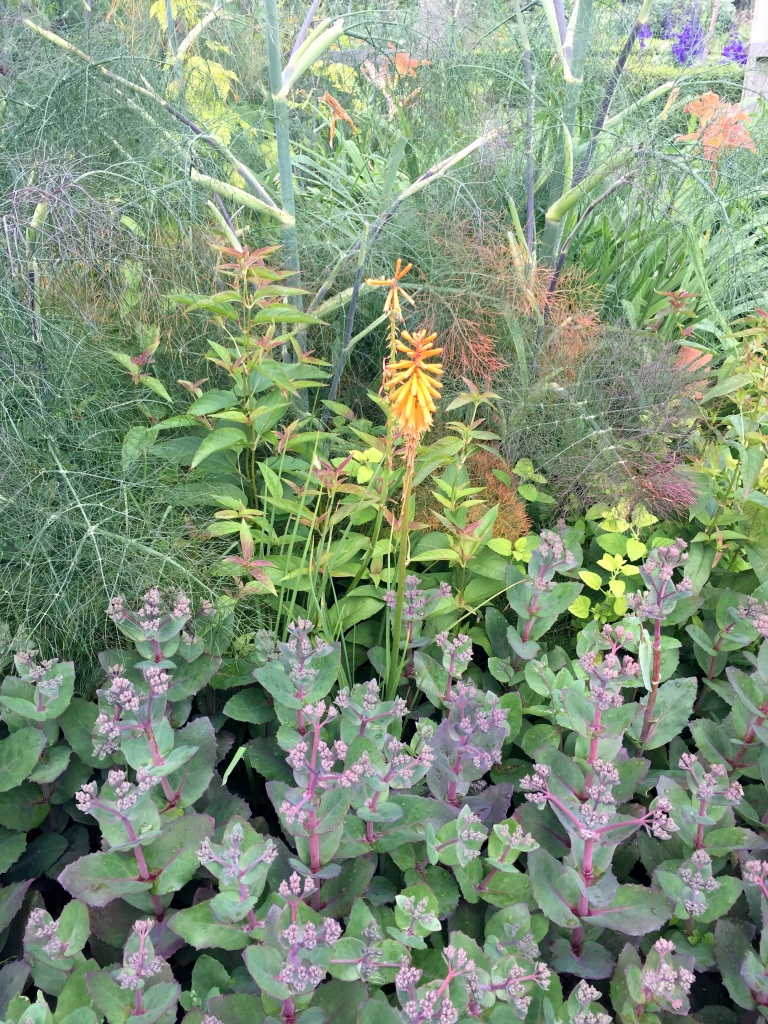 An orange Kniphofia amongst sedum and bronze fennel
An orange Kniphofia amongst sedum and bronze fennel
 The flat heads of Achillea millefolium ‘Terracotta’ with Sedum ‘Matrona’
The flat heads of Achillea millefolium ‘Terracotta’ with Sedum ‘Matrona’
Next to the Blue and Gold borders is The Vegetable Garden – a huge box parterre for growing cut flowers so there are sudden bursts of electric blue delphinium, cloudy white heads of Amni magus, or pokey heads of the last-to-flower giant allium from the June allium trials.

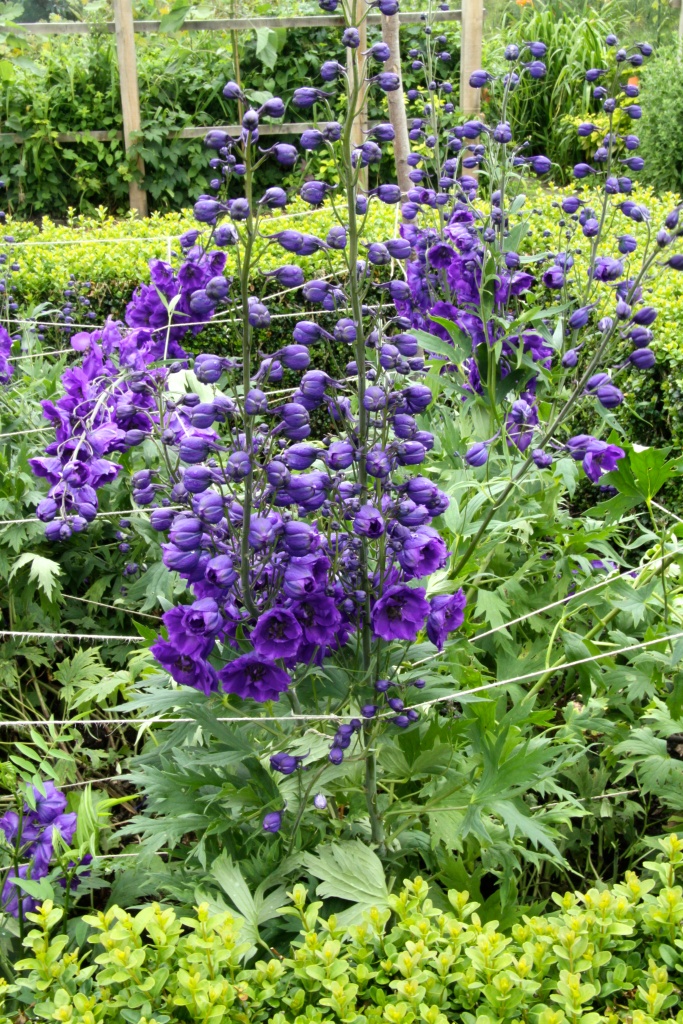
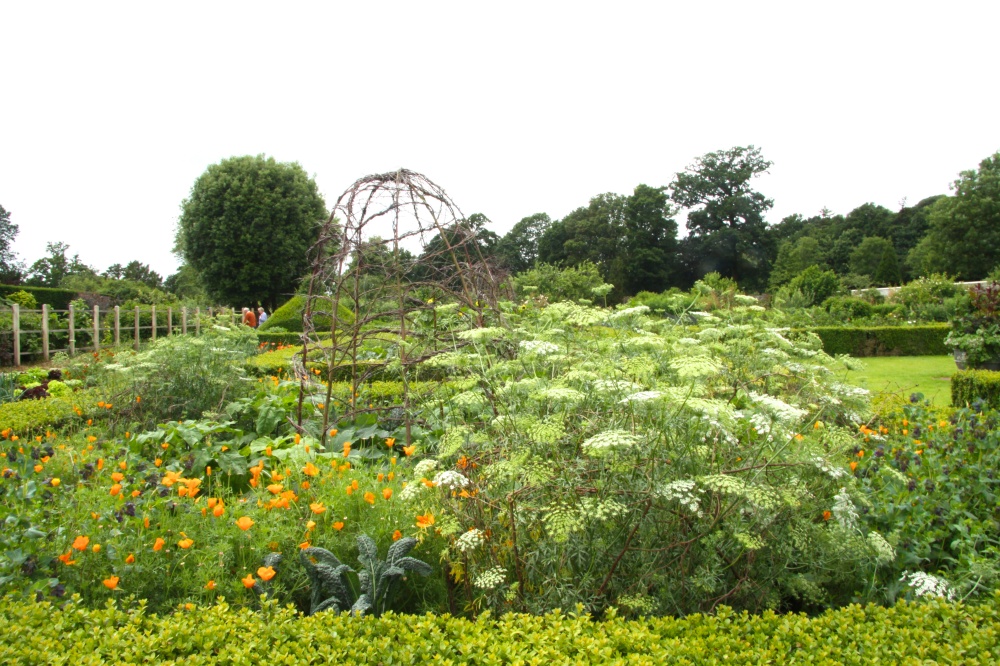
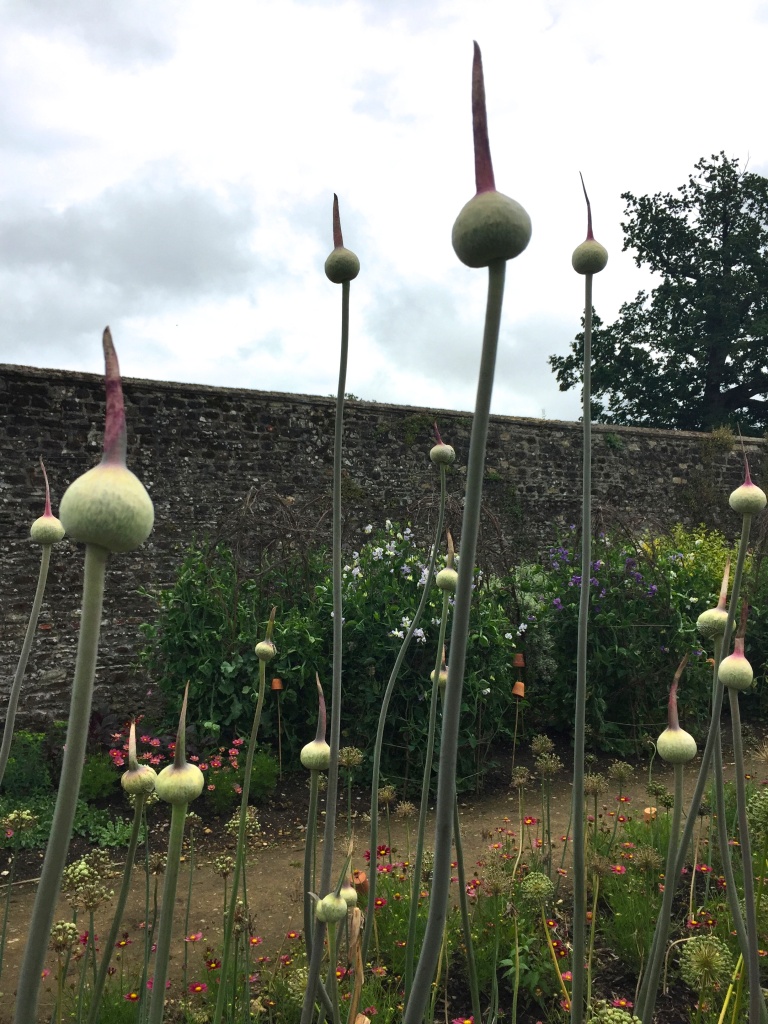 Clipped box, electric blue delphinium, Amni majus, and giant allium in bud
Clipped box, electric blue delphinium, Amni majus, and giant allium in bud
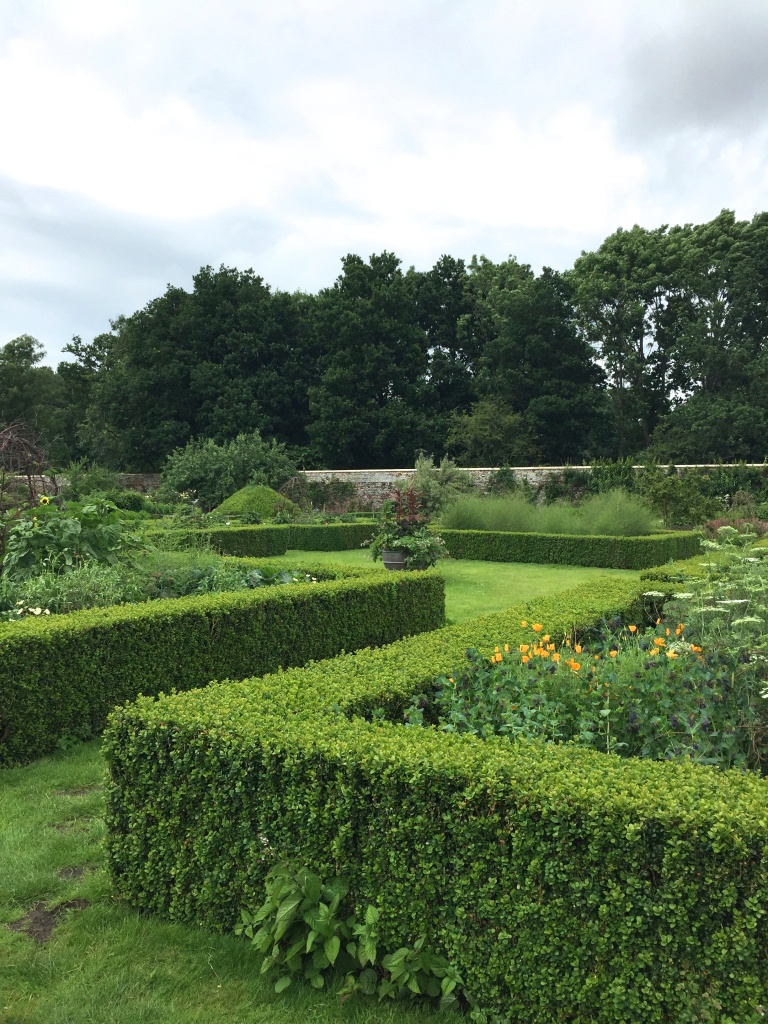 The Vegetable Garden Parterre
The Vegetable Garden Parterre
The spring meadow grass around a pair of charismatically ageing medlar trees has been raked into stook-like piles at the base of the trees. I am suddenly transported to the South of France and summer holidays:
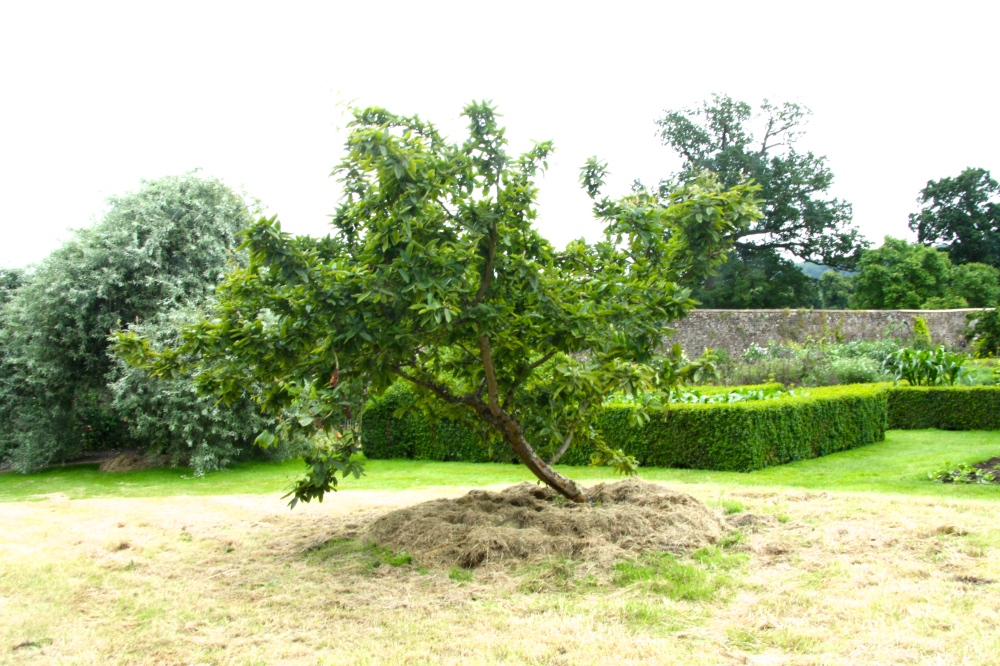
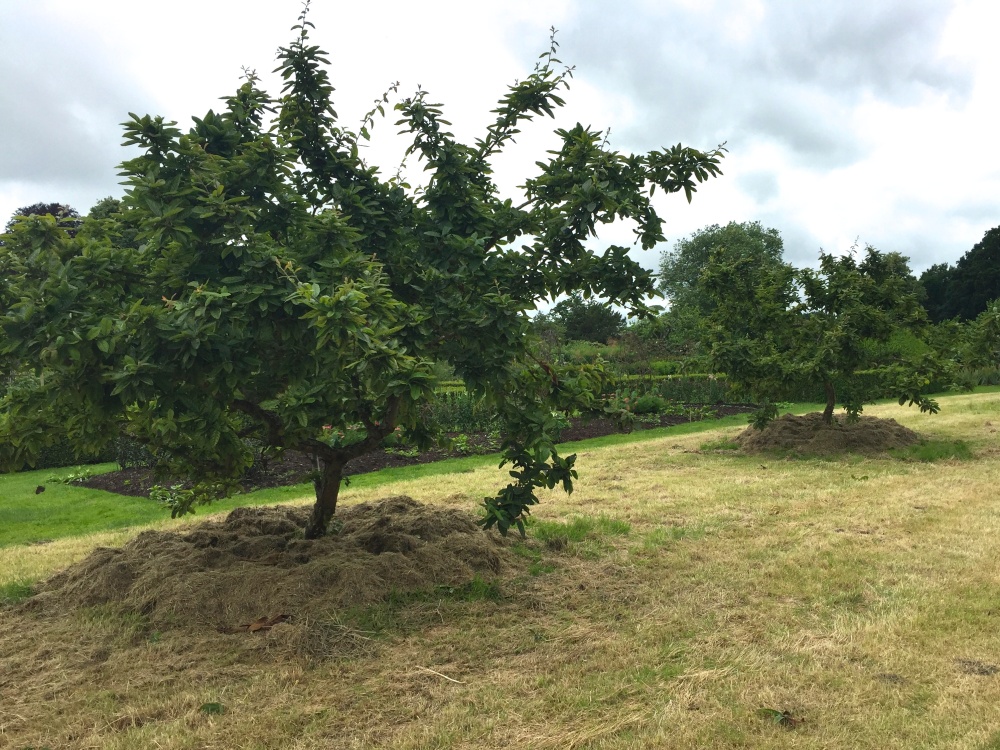
Medlar trees with raked meadow grass
There is the charming wendy house built in 1928 by Clive Pearson for his three daughters – a perfectly detailed two storey cottage built into the garden wall – and there is the rather less impressive photographic record of me hopelessly trying help you work out the scale of the perfectly formed wendy house for yourself…. I love the idea that the family still have an annual tradition of spending one summer night here, lighting the fire, cooking sausages and telling ghost stories.
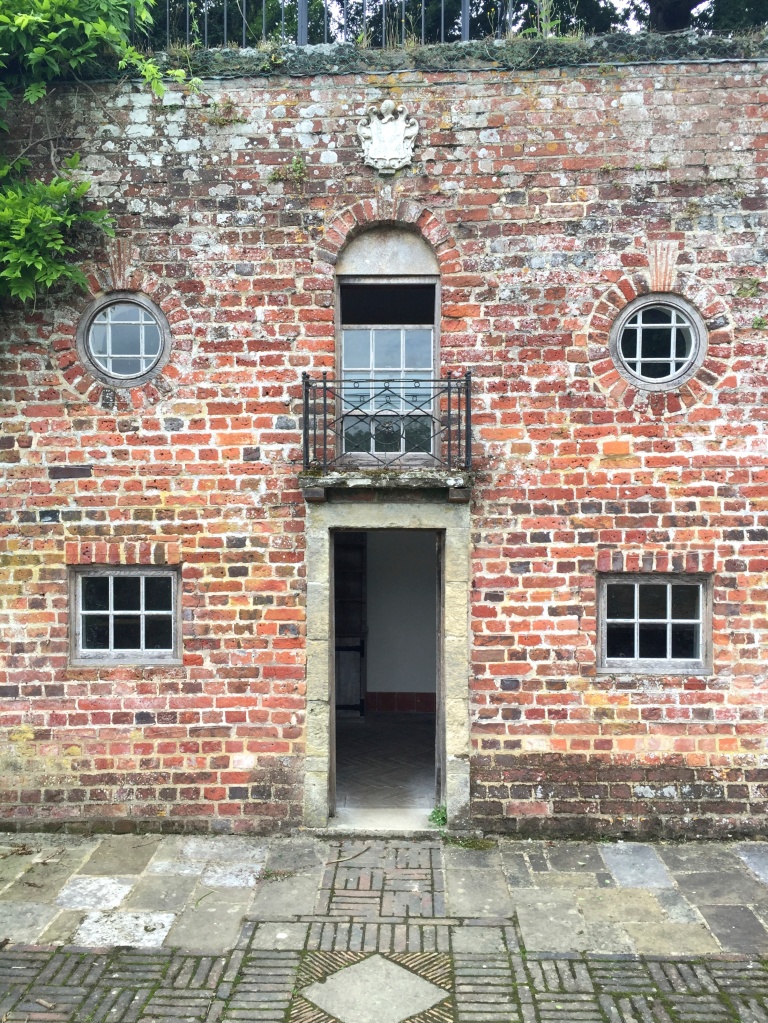 The 1928 Wendy House
The 1928 Wendy House
 A not very helpful selfie to show the scale of Wendy House …
A not very helpful selfie to show the scale of Wendy House …
Next to the wendy house, another perfectly lichened bench surrounded by ferns and mounds of silver Artemisia ludoviciana ‘Valerie Finnis’:
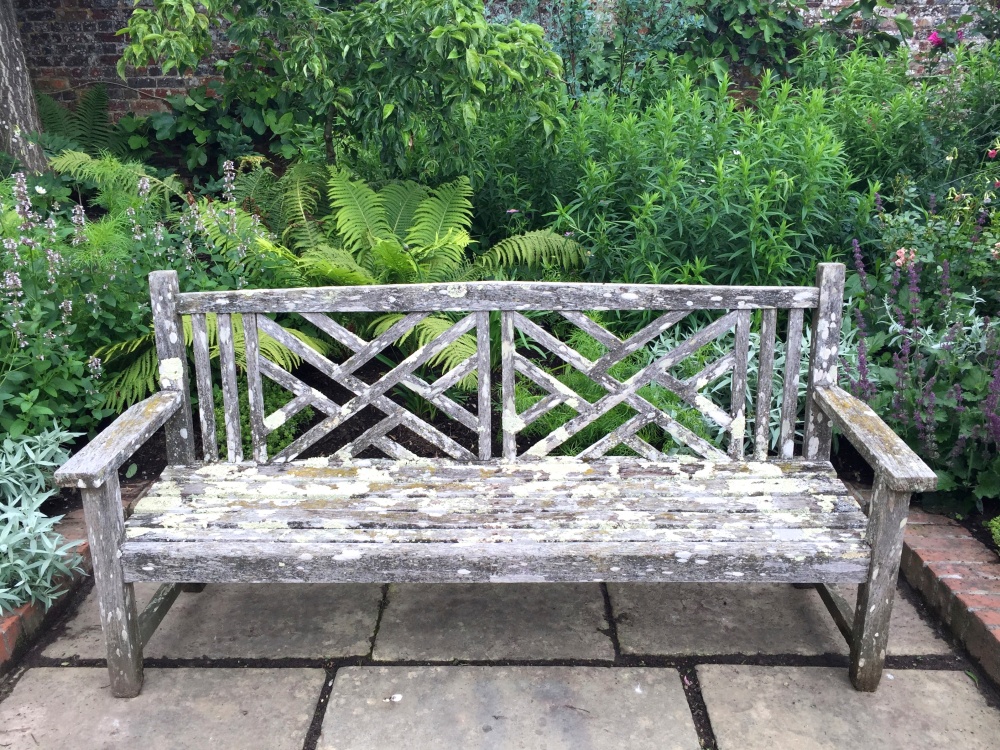
And then a lovely stretch of old brick and flint wall, gates painted with red estate paint and confident shady planting of Digitalis lutea, hosta, Alchemilla mollis, and the rather brilliant addition of sea holly – Eryngium giganteum ‘Silver Ghost’? – which at this point of the year is a pale silvery green (it will turn to silver blue as it matures) and a fantastic counterpoint to the acid green of the alchemilla: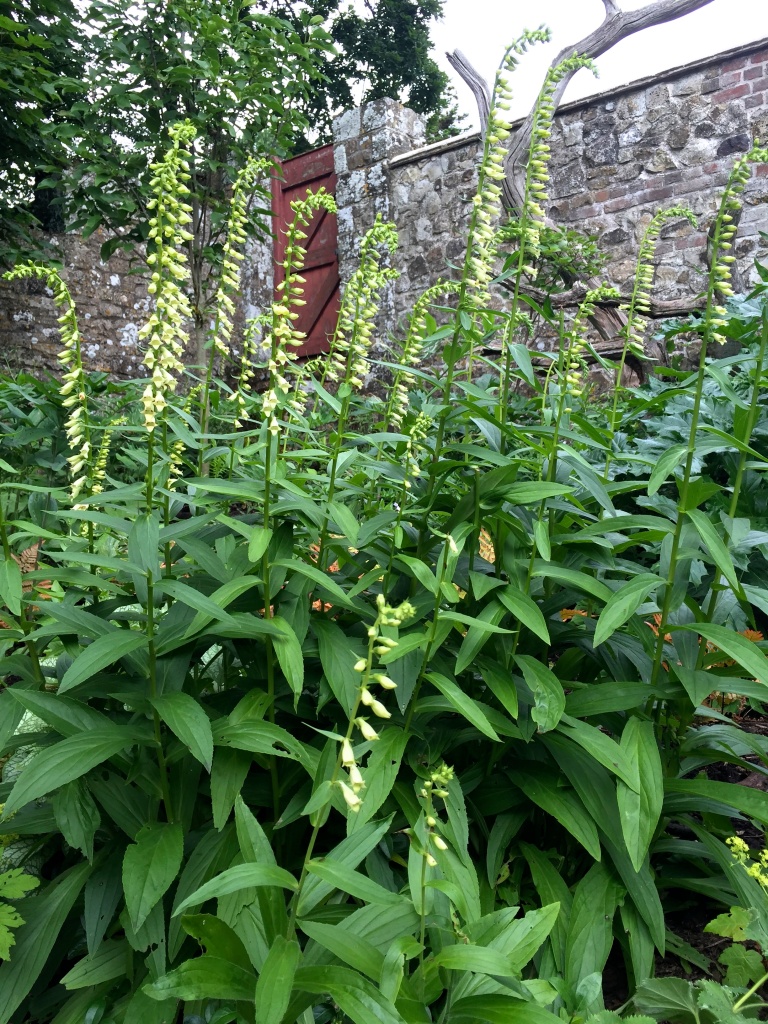 Digitalis lutea
Digitalis lutea
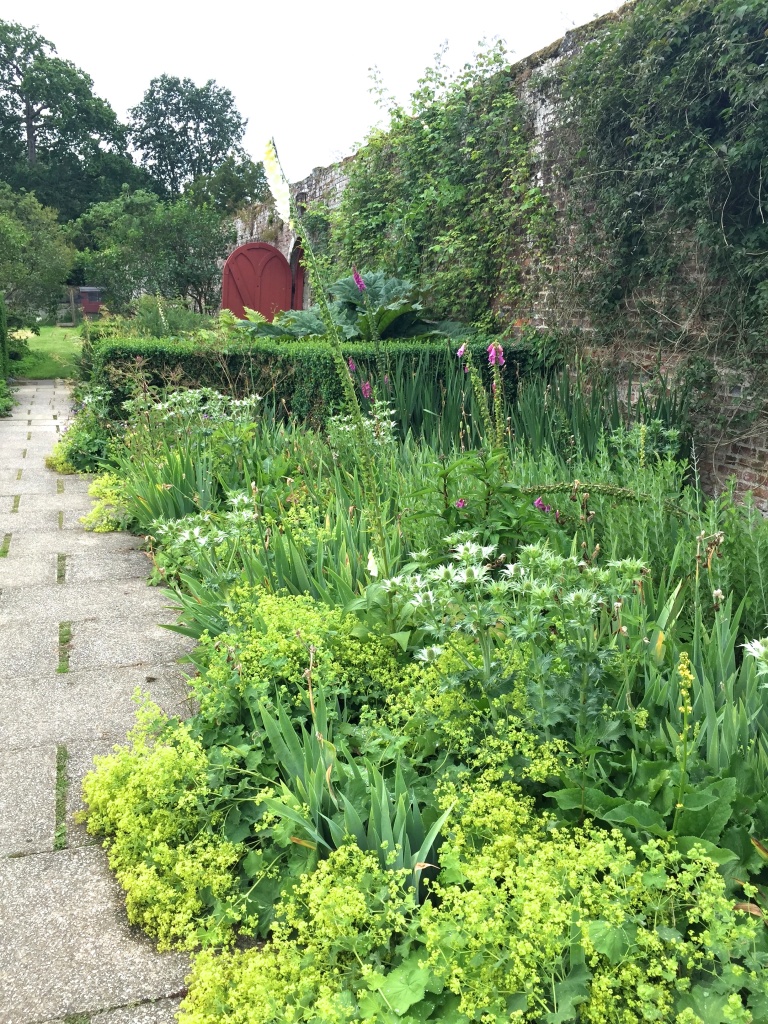
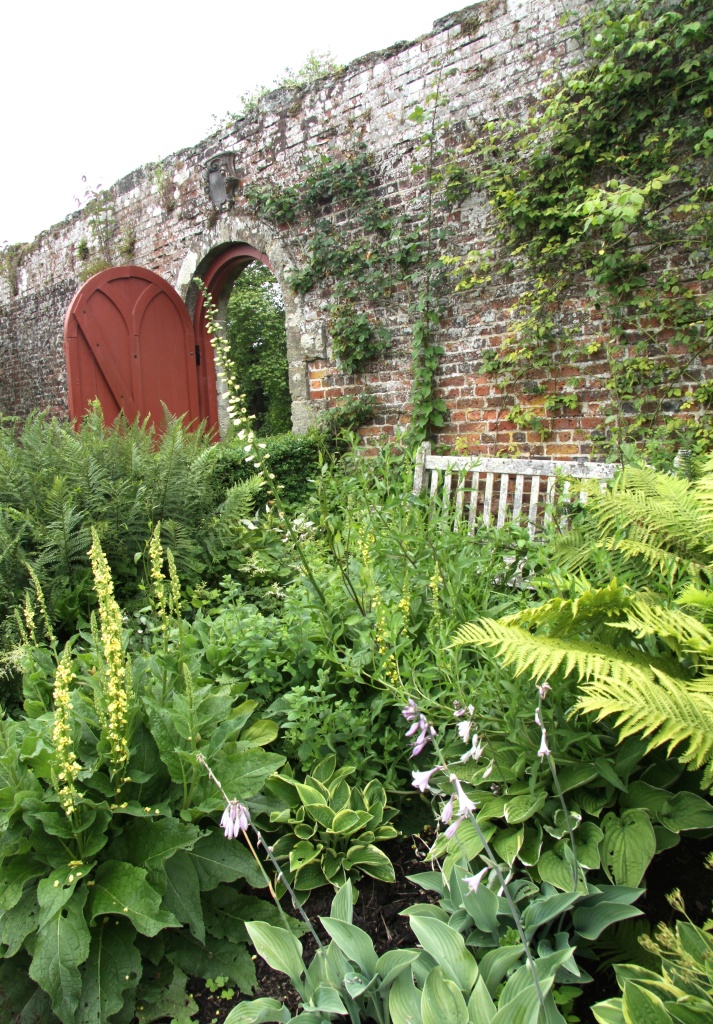
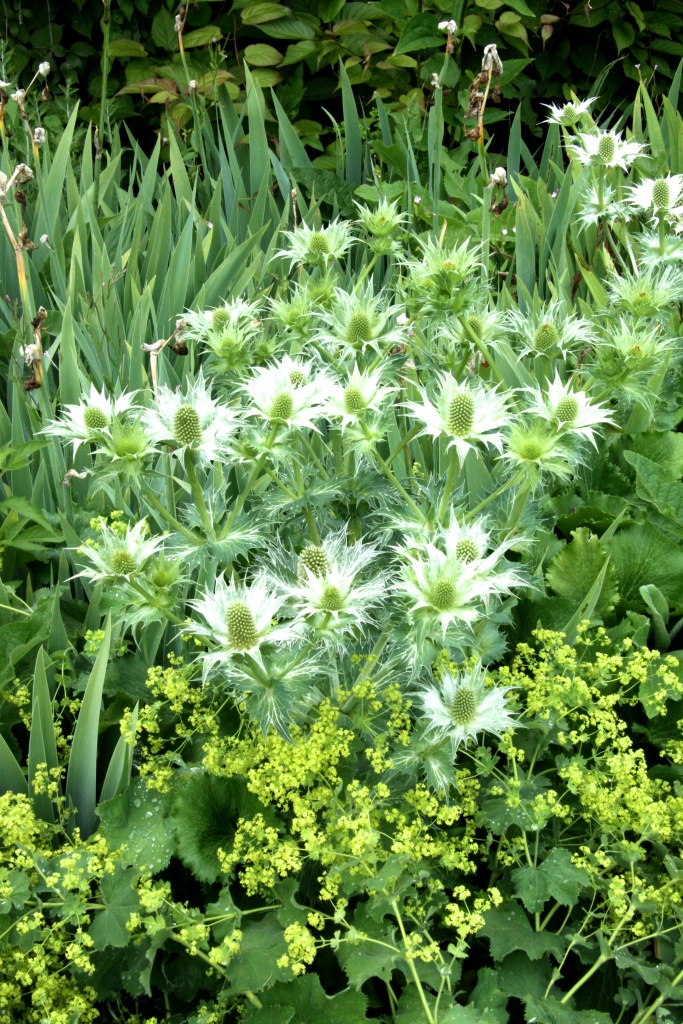 A fine stretch of shady planting – the bottom photo shows the acid green of Alchemilla mollis and the pale silvery green of the young Eryngium giganteum ‘Silver Ghost’
A fine stretch of shady planting – the bottom photo shows the acid green of Alchemilla mollis and the pale silvery green of the young Eryngium giganteum ‘Silver Ghost’
Moving round the garden, the orchard has also been mown and neatly raked, and is ready for summer. There is a feisty wildlife-friendly strip of ferns and stinging nettles against the orchard wall: proof that wild life friendliness and a sense of order can be happy bedfellows.
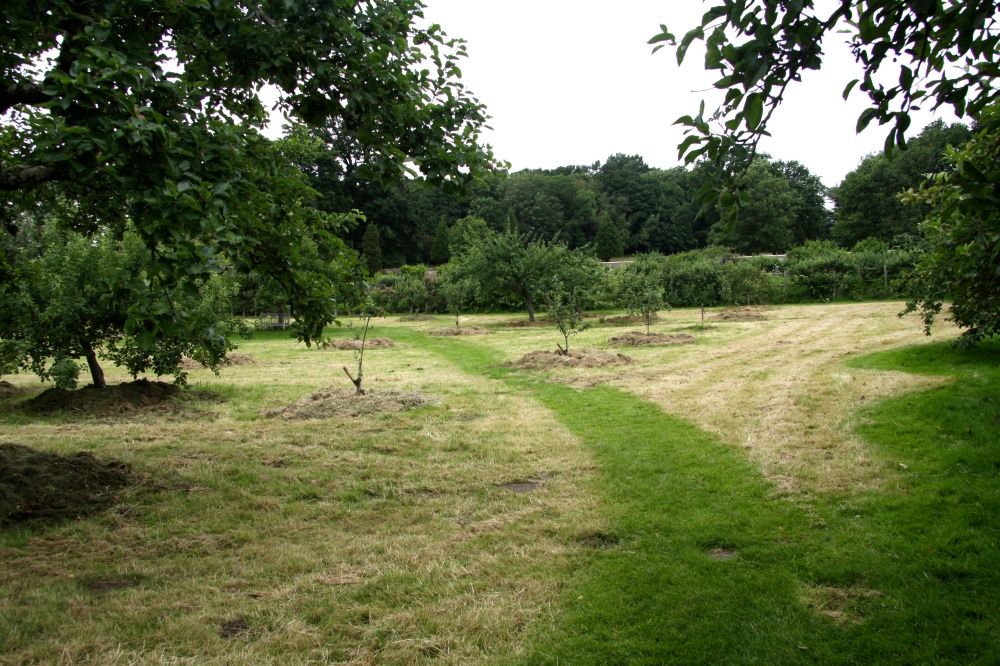
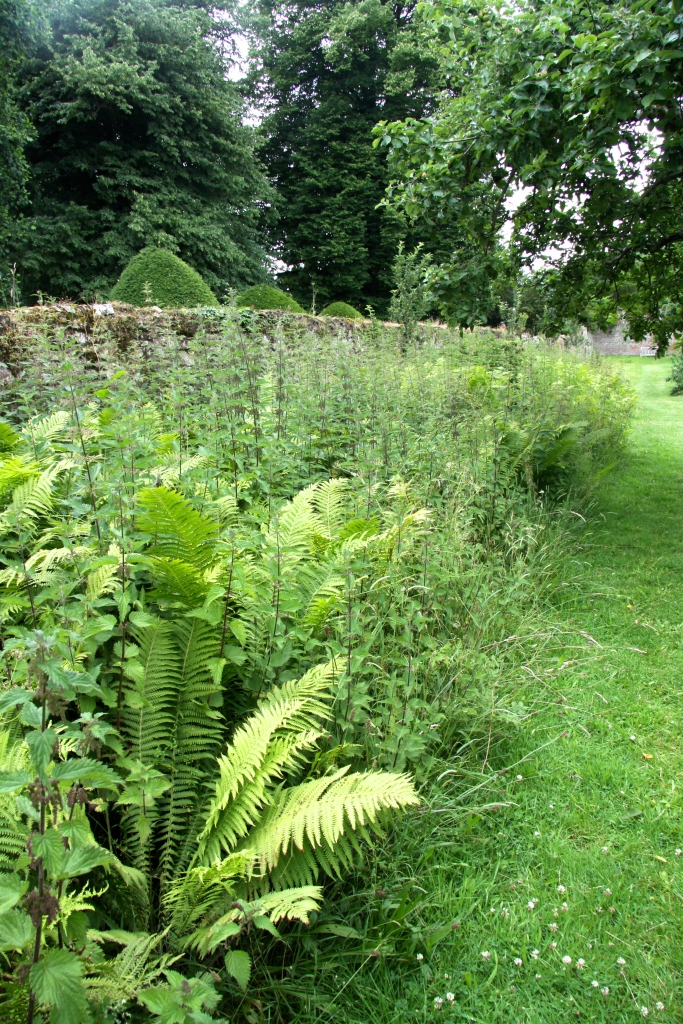 The orchard with a strip of wild-life friendly nettles at its edge
The orchard with a strip of wild-life friendly nettles at its edge
I pass the elegant lake with its latticed wall and views out to the Sussex hills:
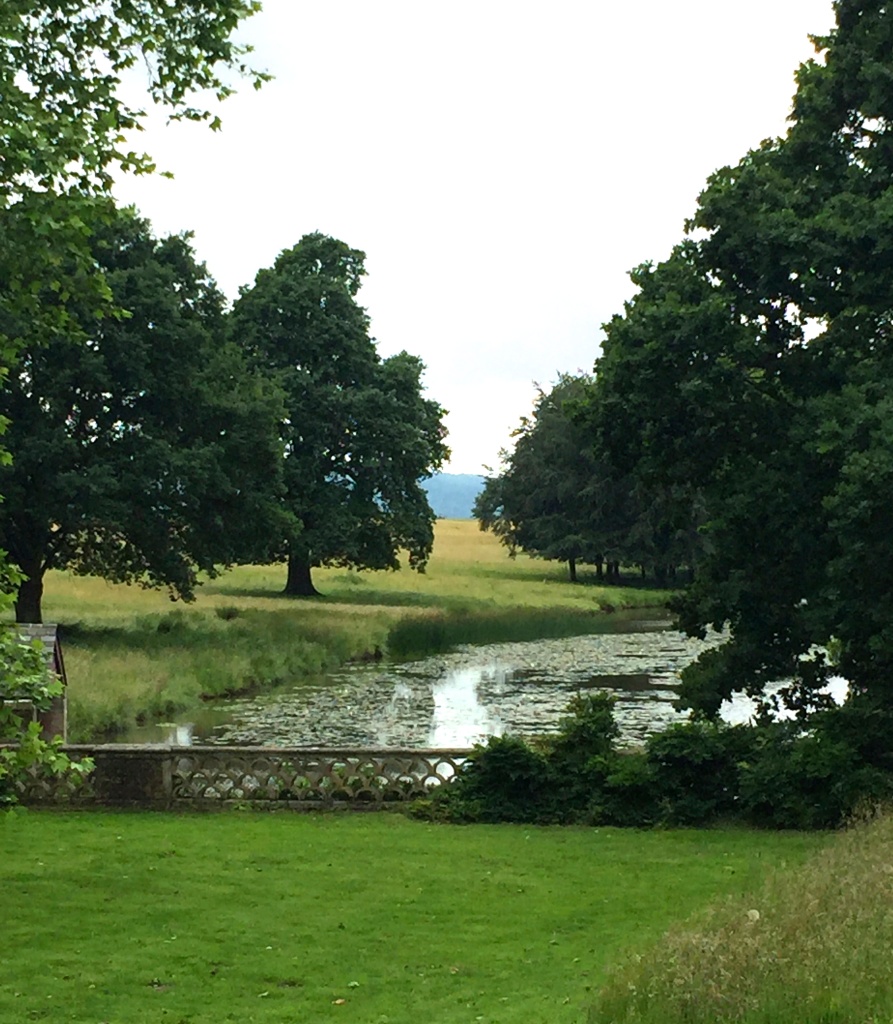 The lake at Parham
The lake at Parham
And as I leave the main part of the garden I notice this excellent combination of plants for shade – Begonia evansiana ssp. evansiana whose heart shaped leaves will be joined by simple shell pink flowers in late summer – and Tiarella ‘Spring Symphony’ with its starry pale pink flowers and purple blotched leaves which will carpet the ground all summer.
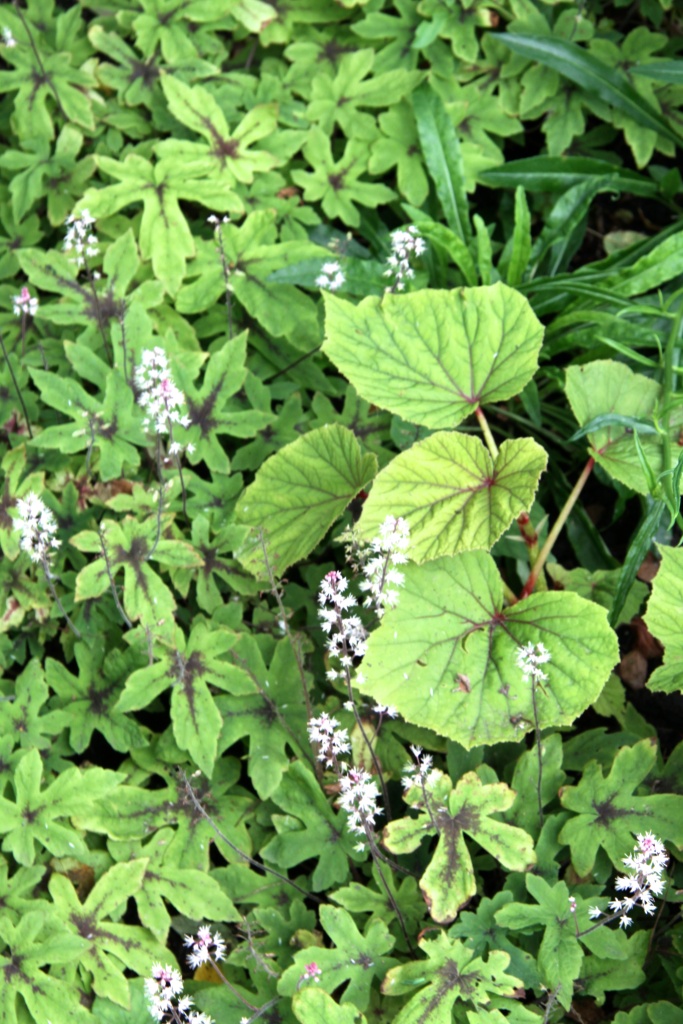
Begonia grandis sbsp. evansiana and Tiarella ‘Spring Symphony’
One final leg to my tour. I pass through a shadowy room with lead paned windows where jewel coloured pelargonium flowers are collected in simple glass vases:
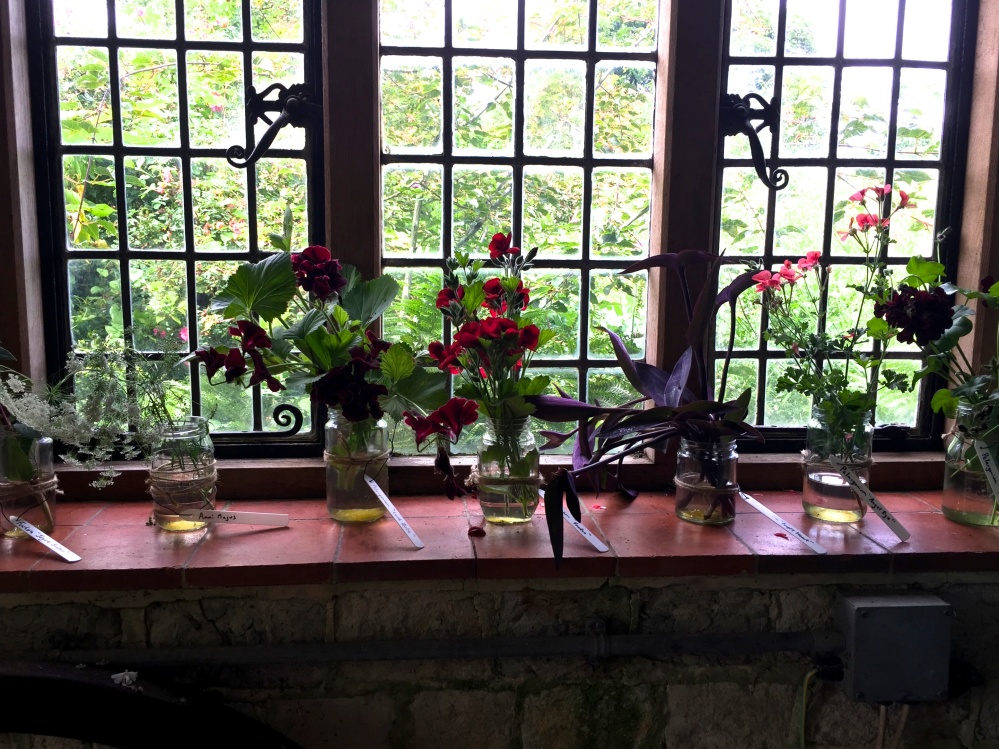
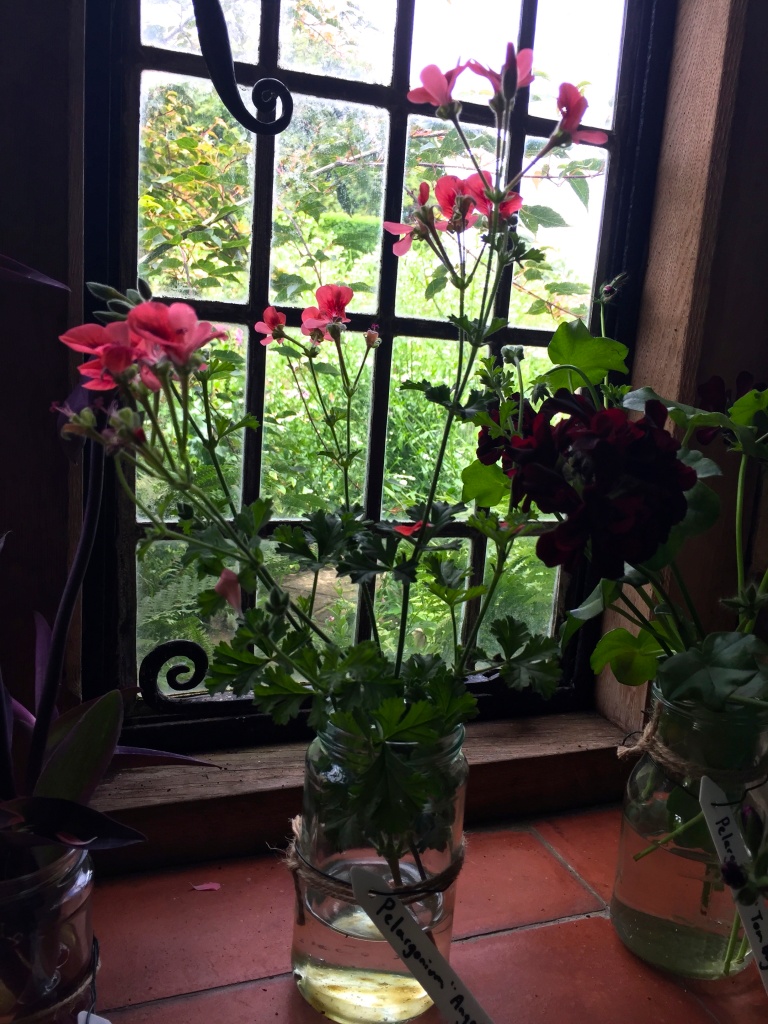 Pelargoniums in simple glass vases against lead paned windows
Pelargoniums in simple glass vases against lead paned windows
through the elongated kaleidoscope of the greenhouses:
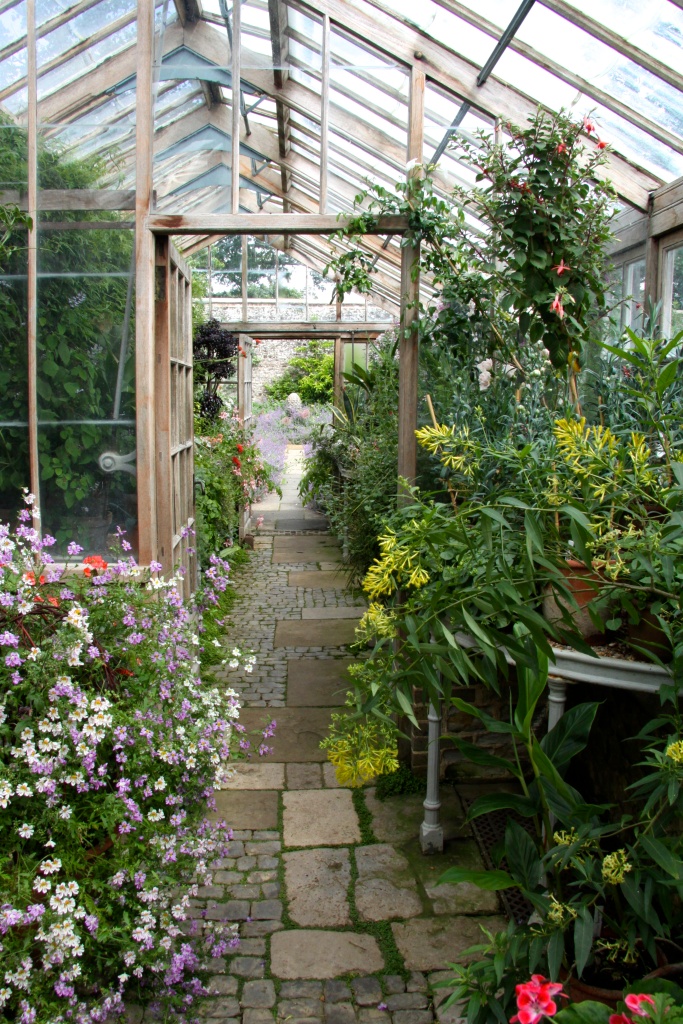 Route through the greenhouses
Route through the greenhouses
to the loveliest, completely simple composition of flint wall, catmint in quantity, stone pineapple, glossy banana plant and pair of orange fox tail lilies:
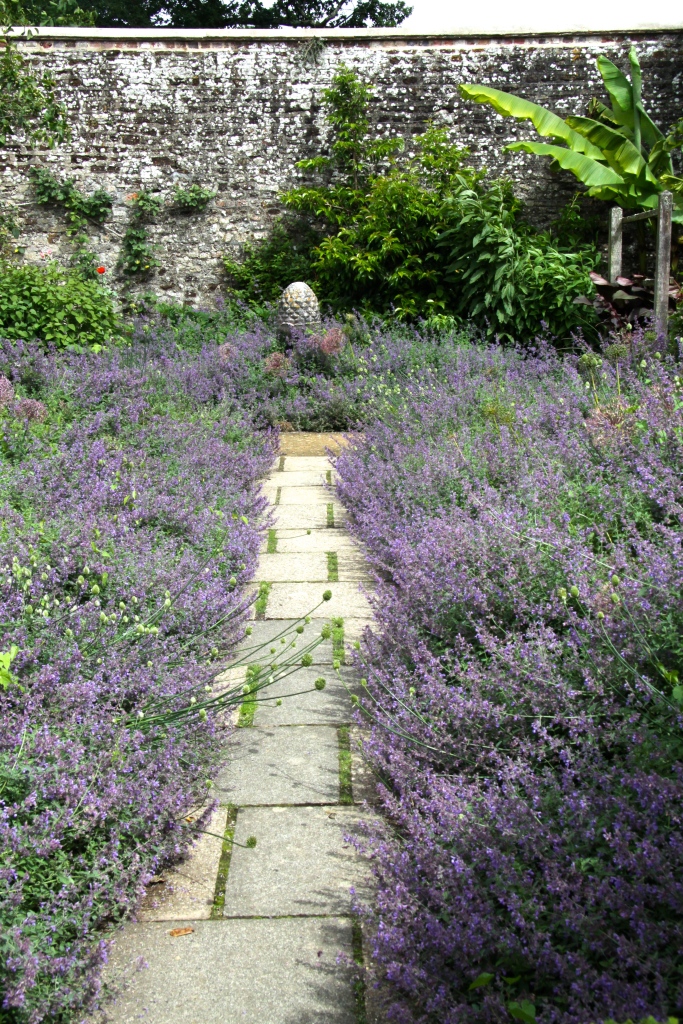
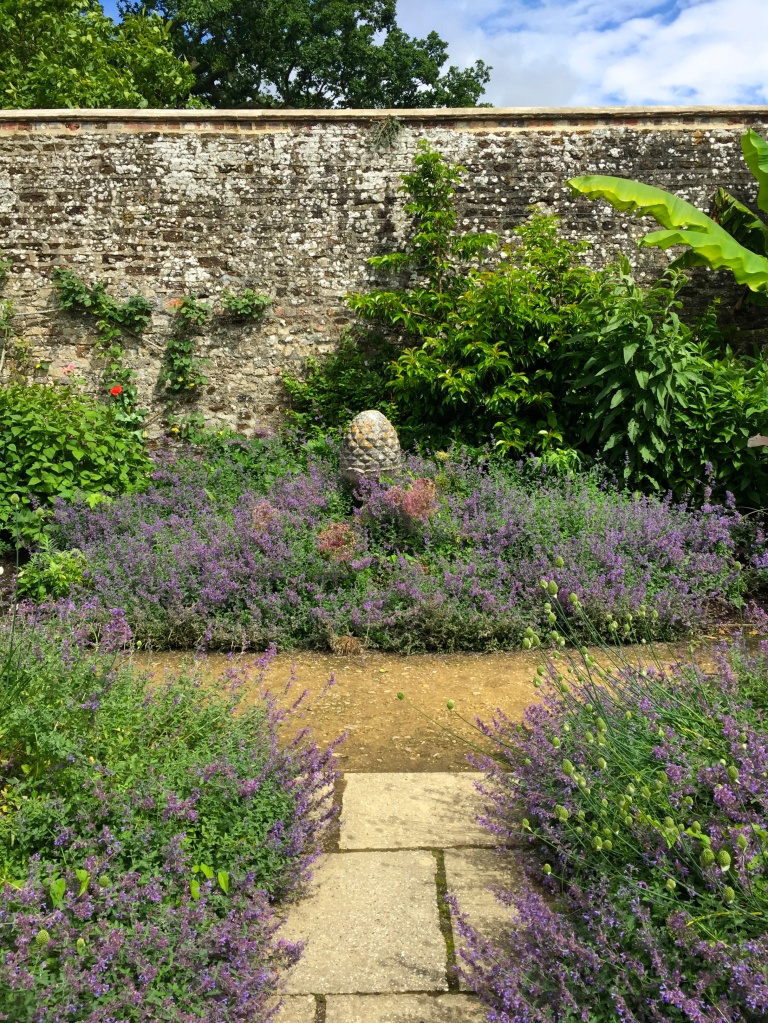
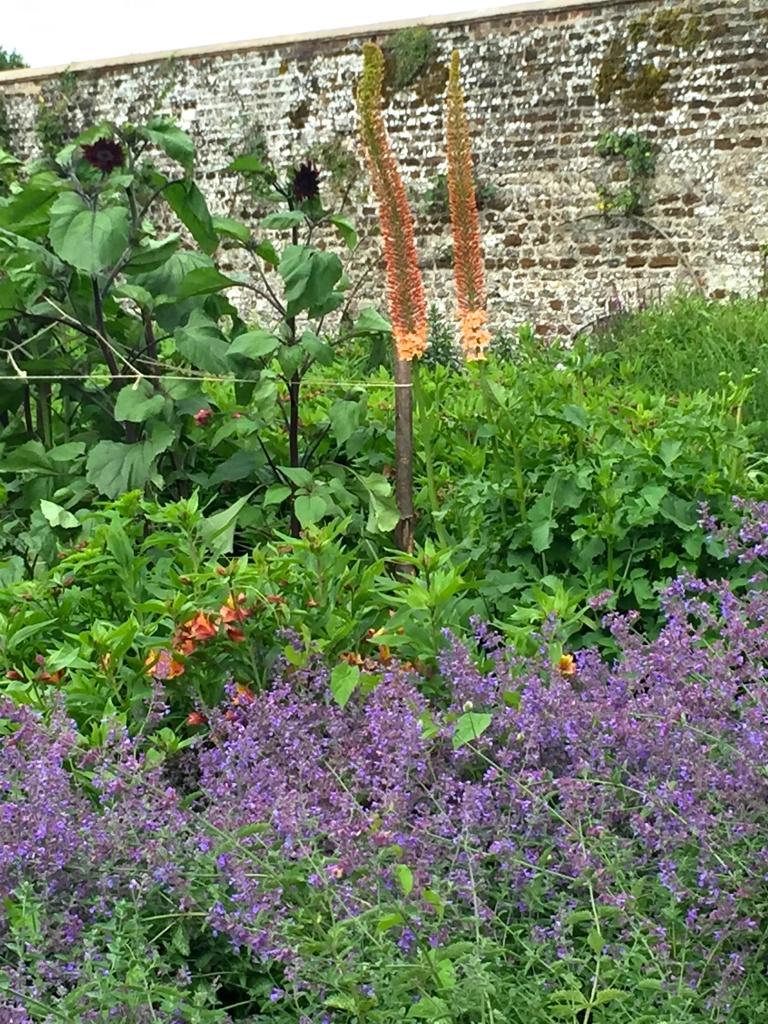
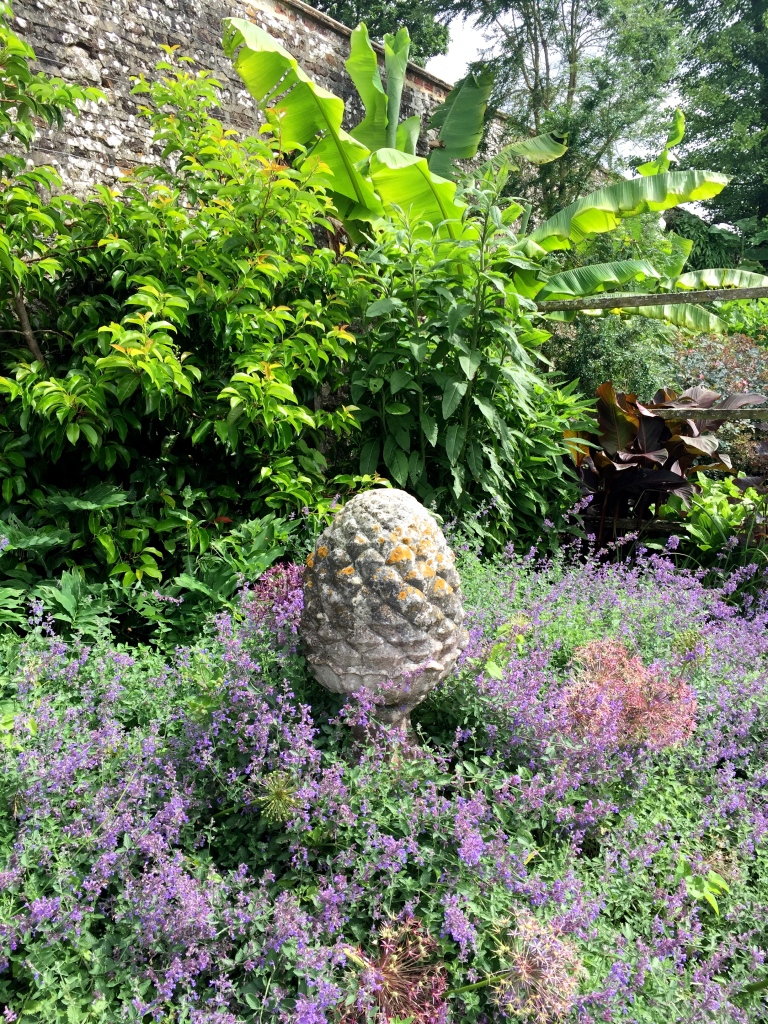
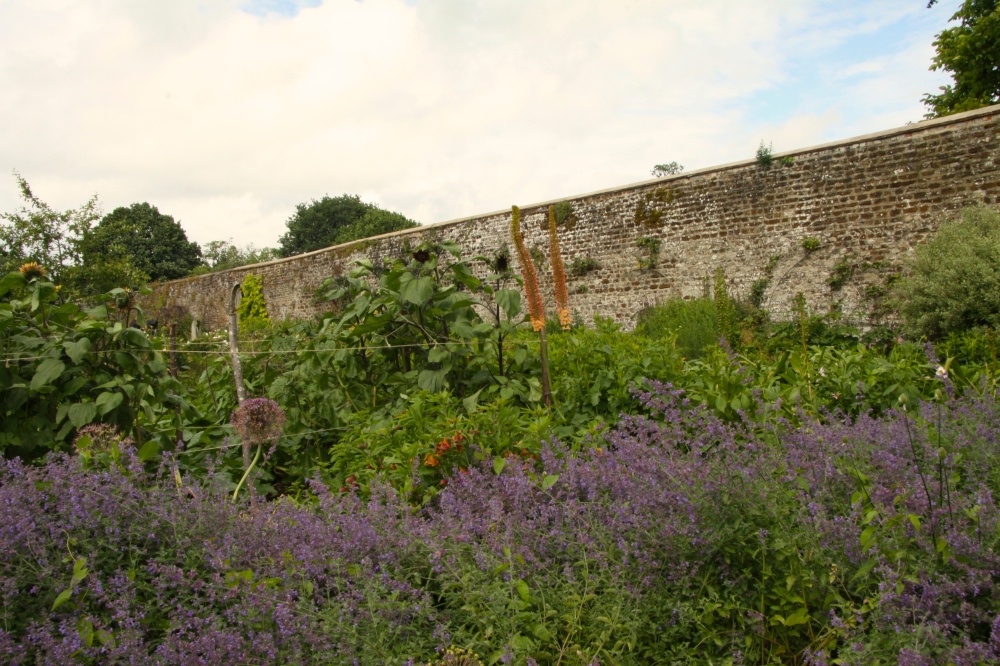
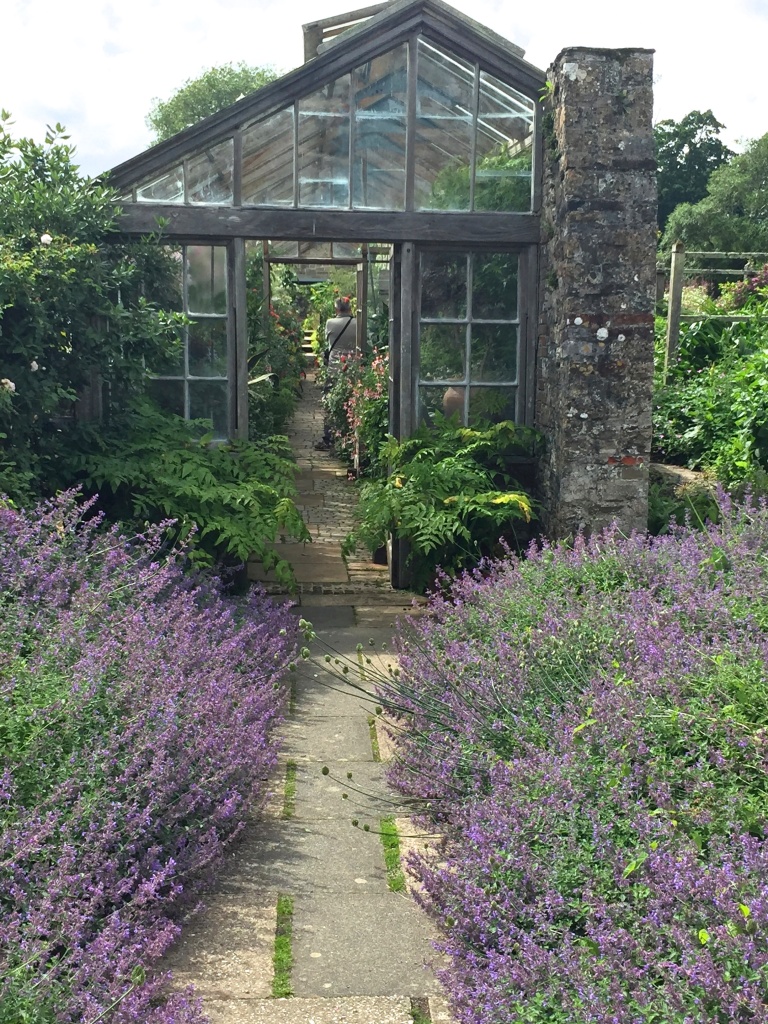
Emerging from the green houses to a sea of catmint, a stone pineapple, a banana plant and some brilliant orange foxtail lilies
I sneak inside the house before I leave, I am running out of time. Worth visiting alone for the 160ft Elizabethan Long Gallery ceiling painted with a twisting design of leaves and flowers in green and gold against white by stage and set designer Oliver Messel in the 20th century:

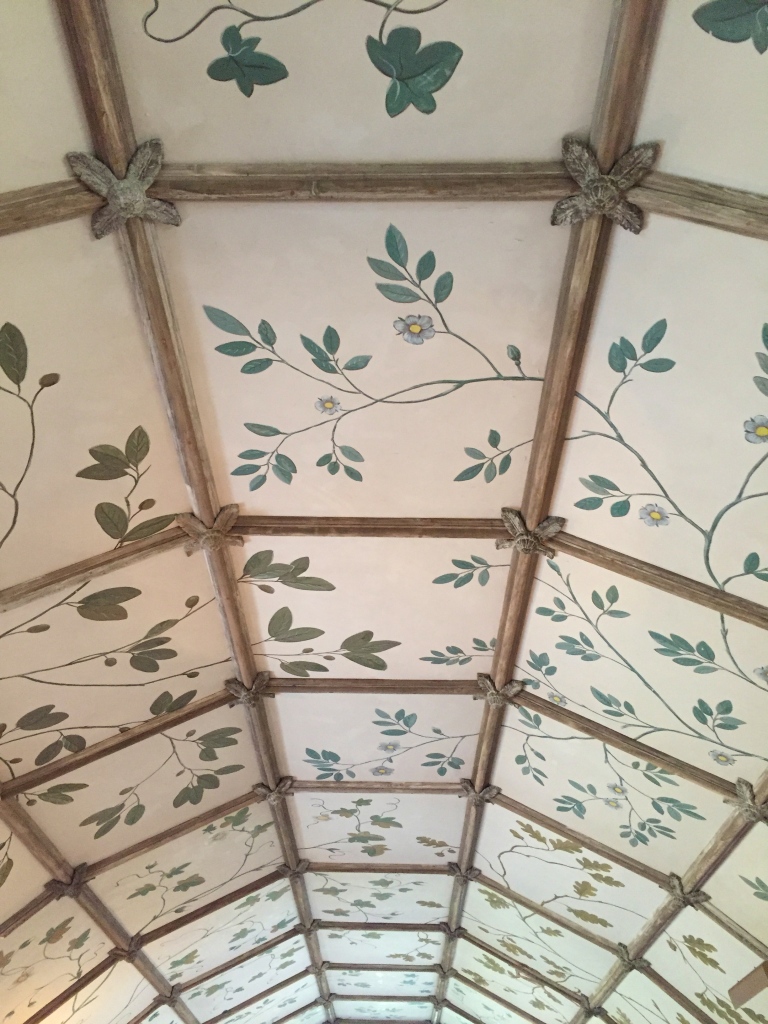
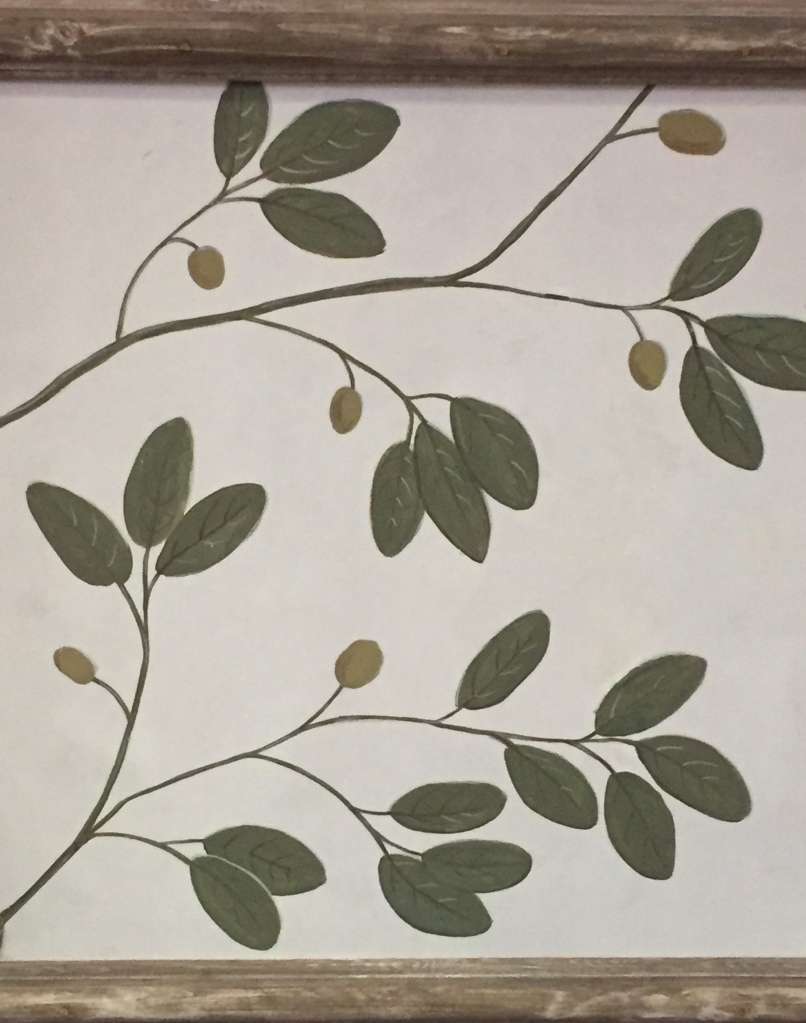
Barrel vaulted ceiling of the Long Gallery, Parham, restored in the 20’s and 30’s and painted with a design by Oliver Messel which was completed in the 1960’s
Even the windows of the house have subtle colour shifts that offer dreamy pallor and sweet intensity in the most enticing combinations:
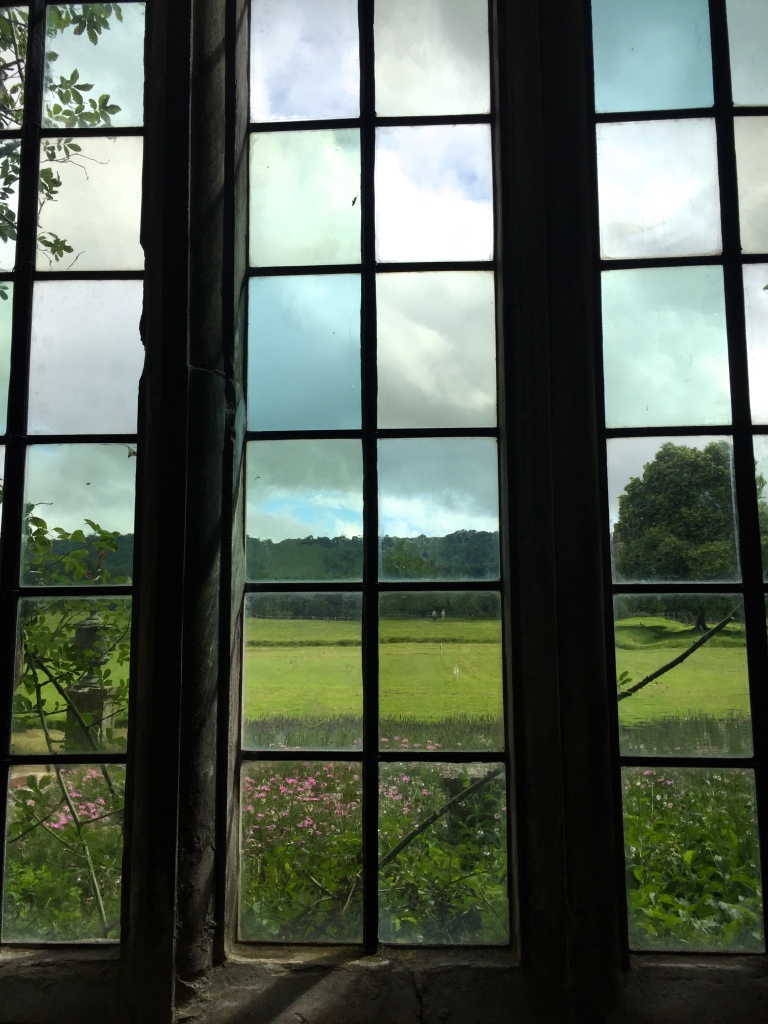
View of the park at Parham from one of the house windows.
Post Script: I will not be posting again for a couple of months as I am travelling all over the UK on writing and also garden design commissions . Wishing you a very good summer, Non.














